mercredi, 12 juillet 2023
Cinq raisons pour lesquelles l'Inde pourrait négocier un cessez-le-feu entre la Russie et l'Ukraine

Cinq raisons pour lesquelles l'Inde pourrait négocier un cessez-le-feu entre la Russie et l'Ukraine
par Andrew Korybko
Source: https://www.ideeazione.com/cinque-motivi-per-cui-lindia-potrebbe-mediare-un-cessate-il-fuoco-tra-russia-e-ucraina/
Il y a un consensus croissant sur le fait que l'échec de la contre-offensive de Kiev soutenue par l'OTAN et l'avantage de Moscou sur l'OTAN dans leur "course logistique"/"guerre d'usure" conduiront à la reprise des pourparlers russo-ukrainiens sous une forme ou une autre d'ici la fin de l'année, comme nous l'avons déjà expliqué dans nos colonnes. Il s'agira au minimum de parvenir à un cessez-le-feu, mais la Rada interdit à Zelensky de mener des discussions avec la Russie, d'où la nécessité d'un médiateur. Voici cinq raisons pour lesquelles l'Inde pourrait jouer ce rôle :
1. Les États-Unis veulent "désynchroniser" le processus de paix
La Chine dispose du pouvoir diplomatique nécessaire pour mettre en œuvre son plan visant à geler la guerre par procuration entre l'OTAN et la Russie, mais uniquement si les États-Unis autorisent Kiev à participer aux pourparlers sous leurs auspices, ce qui a peu de chances d'être approuvé. Washington ne laissera jamais son rival systémique entrer dans l'histoire comme le pays qui a contribué à mettre fin au conflit le plus important sur le plan géostratégique depuis la Seconde Guerre mondiale, préférant "désynchroniser" le processus de paix en demandant à quelqu'un d'autre de jouer ce rôle afin de priver Pékin de cette victoire diplomatique.

2. La Russie pourrait ne plus faire confiance à la médiation turque
La violation par le président turc Erdogan de l'accord sur l'Azovstal conclu l'année dernière avec son homologue russe pourrait avoir irrémédiablement entamé la confiance entre les deux pays, au point que le président Poutine pourrait ne plus se sentir à l'aise si la Turquie devait à nouveau jouer le rôle de médiateur entre lui et Kiev. Dans ce cas, et compte tenu de l'apparente inévitabilité d'une reprise des pourparlers sous une forme ou une autre d'ici la fin de l'année, il s'ensuit que la Russie, l'Ukraine et les États-Unis devront se mettre d'accord sur quelqu'un d'autre pour jouer le rôle de médiateur.
3. L'Inde est beaucoup plus attrayante que l'Afrique du Sud
Outre l'Afrique du Sud, l'Inde est le seul grand pays à s'être constamment abstenu de voter toutes les résolutions anti-russes de l'Assemblée générale des Nations unies, démontrant ainsi sa neutralité vis-à-vis de la guerre par procuration entre l'OTAN et la Russie en Ukraine. Contrairement à Pretoria, Delhi ne fait pas partie de la Cour pénale internationale et ses liens avec Moscou ne sont plus critiqués par Washington. Ces deux facteurs combinés rendent l'Inde beaucoup plus attrayante que l'Afrique du Sud comme substitut possible à la Turquie dans la médiation entre la Russie et l'Ukraine contrôlée par les États-Unis.
4. La Russie et les États-Unis entretiennent d'excellentes relations avec l'Inde
Le partenariat stratégique russo-indien, vieux de plusieurs décennies, a résisté de manière impressionnante aux pressions occidentales sans précédent au cours des seize mois et demi écoulés, tandis que le partenariat stratégique entre l'Inde et les États-Unis s'est récemment renforcé sans que les intérêts de Moscou n'en pâtissent. Chacune de ces deux grandes puissances a un intérêt naturel à renforcer le rôle croissant de l'Inde dans les affaires mondiales, ce qui explique pourquoi elles pourraient accepter la médiation de l'Inde dans les pourparlers russo-ukrainiens sur le cessez-le-feu.
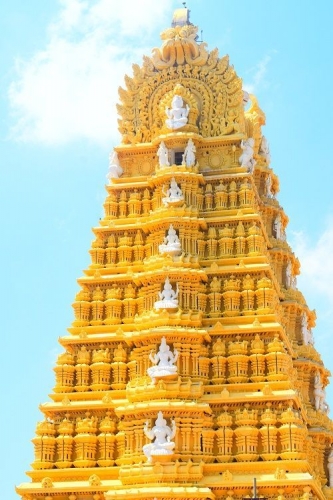
5. L'idée d'une médiation indienne est acceptable pour tous
La Russie et les États-Unis se disputent les cœurs et les esprits des pays du Sud, et chacun d'entre eux bénéficierait donc de l'effet d'optique d'une médiation demandée à la "voix du Sud". Les deux pays bénéficieraient également d'autres avantages : la Russie n'aurait pas à craindre que tout compromis qu'elle pourrait faire soit considéré comme "dicté par la Chine" à des fins de division et de domination, tandis que les États-Unis pourraient présenter le rôle diplomatique prestigieux de l'Inde comme la preuve que le "siècle asiatique" n'est pas synonyme de "siècle chinois".
Le porte-parole du département d'État, Matt Miller, a confirmé lundi que "nous saluons le rôle que l'Inde ou tout autre pays pourrait jouer" pour mettre fin à ce conflit, indiquant qu'il pourrait remplacer la Turquie si la Russie ne considère plus cette dernière comme un médiateur fiable. Si Delhi était intéressé, il devrait entamer immédiatement des pourparlers avec les deux pays, car le temps presse et d'autres acteurs rivalisent pour entrer dans l'histoire en contribuant à mettre fin au conflit le plus important sur le plan géostratégique depuis la Seconde Guerre mondiale.
Publié en partenariat sur One World - Korybko Stubstack
20:29 Publié dans Actualité, Affaires européennes | Lien permanent | Commentaires (0) | Tags : diplomatie, politique internationale, inde, russie, ukraine, europe, asie, affaires européennes, affaires asiatiques |  |
|  del.icio.us |
del.icio.us |  |
|  Digg |
Digg | ![]() Facebook
Facebook
jeudi, 29 juin 2023
Les liens entre l'Inde et la Chine constituent le facteur X pour un monde véritablement multipolaire

Les liens entre l'Inde et la Chine constituent le facteur X pour un monde véritablement multipolaire
Ajay Kamalakaran
Discours prononcé lors de la Conférence mondiale sur la multipolarité, 29 avril 2023
Source: https://www.geopolitika.ru/en/article/india-china-ties-x-factor-truly-multi-polar-world
Il est dans l'intérêt de New Delhi, de Pékin et de l'ensemble des pays du Sud que les liens sino-indiens se développent.
Les deux nations les plus peuplées du monde ont des économies florissantes qui continuent d'enregistrer des niveaux de croissance inconnus dans la plupart des régions du monde. Le commerce bilatéral entre l'Inde et la Chine a atteint près de 136 milliards de dollars en 2022. Malheureusement, les relations politiques et diplomatiques entre les deux pays sont confrontées à une série de défis. Les dernières années ont conduit à un déficit de confiance mutuelle entre les deux puissances asiatiques.
Si la quête de la Russie pour un monde véritablement multipolaire doit devenir une réalité, il est essentiel que les relations sino-indiennes ne soient pas seulement normalisées, mais qu'elles prospèrent. L'Inde et la Chine entretiennent des liens civilisationnels millénaires, mais un différend frontalier apparu à la fin des années 1950 les tient en otage.
Toutefois, le dégel des relations entre l'Inde et la Chine au milieu des années 1980 a donné un nouvel élan aux liens bilatéraux, qui ont commencé à prospérer jusqu'au milieu de la dernière décennie. Lorsque le président chinois de l'époque, Hu Jintao, a rencontré le premier ministre indien de l'époque, Manmohan Singh, à Moscou en 2005, lors des célébrations du 60e anniversaire de la fin de la Seconde Guerre mondiale, ce dernier aurait déclaré ce qui suit : "Lorsque nous nous serrons la main, l'Inde et la Chine ne sont pas des pays qui se ressemblent ". "Lorsque nous nous serrerons la main, le monde entier s'en apercevra".
La Russie a été l'un des principaux défenseurs des liens amicaux entre l'Inde et la Chine. La doctrine Primakov, formulée par le ministre russe des affaires étrangères Evgueni Primakov dans les années 1990, préconisait la formation d'une alliance stratégique entre la Russie, la Chine et l'Inde. Il s'agissait essentiellement du précurseur des BRICS.
Depuis les années 1990, l'amitié de la Russie avec la Chine et l'Inde s'est développée, mais les relations entre les deux principaux amis de Moscou n'ont pas suivi le même rythme. On peut supposer sans risque qu'il n'est pas dans l'intérêt de l'Occident que New Delhi et Pékin se serrent la main, mais des pays comme la Russie, qui apprécient l'Inde et la Chine, doivent encourager ces pays à aplanir leurs divergences ou au moins à geler leurs différends et à se concentrer sur les domaines de convergence.
Les dirigeants indiens répètent une phrase sanskrite qui signifie que le monde entier est une grande famille, tandis que leurs homologues chinois insistent sur la nécessité pour les nations les moins développées de grandir ensemble afin que personne ne soit laissé de côté. Il n'y a manifestement aucune contradiction entre les objectifs globaux des deux pays, et il est dans leur intérêt de suivre le principe de l'harmonie dans les différences.

L'amélioration des relations entre la Chine et l'Inde ne profitera pas seulement aux deux pays, mais aussi à l'ensemble du Sud, tout en favorisant l'émergence d'un monde multipolaire. Le fait que les deux pays coopèrent dans le cadre de structures multilatérales telles que les BRICS et l'OCS et que l'Inde soit un partenaire clé de la Banque asiatique d'investissement pour les infrastructures, dirigée par la Chine, prouve que les deux pays sont capables de coopérer à l'échelle mondiale. Le moment est venu de développer le format RIC (Russie-Inde-Chine) et de renforcer les liens bilatéraux.
Lorsque le ministre chinois de la défense, Li Shangfu, s'est rendu en Inde pour une réunion de l'OCS, il a déclaré à son homologue indien Rajnath Singh : "Les intérêts communs de la Chine et de l'Inde l'emportent sur les divergences, et les deux parties devraient donc envisager les liens bilatéraux et leur développement d'une manière globale, stratégique et à long terme. Il s'agit là d'un signe clair que Pékin souhaite que les relations avec New Delhi s'améliorent. Cette dernière doit accepter la main tendue par la première. Le monde en prendra bonne note lorsque l'Inde et la Chine se serreront la main et que le monde se rapprochera de la multipolarité.
20:21 Publié dans Actualité | Lien permanent | Commentaires (1) | Tags : actualité, multipolarité, chine, inde, asie, affaires asiatiques, politique internationale |  |
|  del.icio.us |
del.icio.us |  |
|  Digg |
Digg | ![]() Facebook
Facebook
mardi, 23 mai 2023
L'Inde quintuple ses importations en provenance de Russie et demande à Londres de restituer ce que les Britanniques lui ont volé
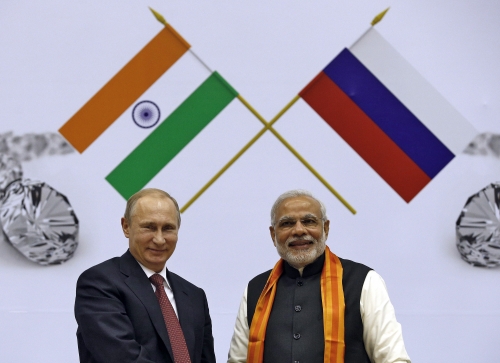
L'Inde quintuple ses importations en provenance de Russie et demande à Londres de restituer ce que les Britanniques lui ont volé
Enrico Toselli
Source: https://electomagazine.it/lindia-quintuplica-le-importazi...
La Russie est devenue le deuxième fournisseur de marchandises de l'Inde, derrière la Chine. Au cours du premier trimestre de cette année, les exportations de Moscou vers New Delhi ont dépassé 15,5 milliards de dollars, soit près de cinq fois plus qu'au cours du premier trimestre de l'année dernière. Un signe clair du non alignement du reste du monde sur les sanctions imposées par Washington et adoptées par les majordomes européens.
Au contraire, face aux protestations de Borrell - le représentant de la politique étrangère européenne et le génie qui a considéré Giggino Di Maio comme le meilleur candidat pour gérer les relations entre l'Europe et les pays du Golfe - sur les achats excessifs de pétrole russe par l'Inde, le ministre des affaires étrangères de New Delhi a rétorqué en invitant Borrell à étudier les règles européennes avant de répandre des âneries.
Car les idiots eurocratiques ont créé les conditions, grâce aux sanctions, pour acheter du pétrole russe mais en le payant plus cher. "Le pétrole russe, lui a rappelé le ministre indien, est largement transformé dans des pays tiers et, de ce fait, n'est plus considéré comme russe. Une farce, en somme. Que tout le monde connaît, sauf Borrell. Dans la pratique, la Russie continue de vendre du pétrole qui est traité au-delà de la frontière et qui acquiert la "nationalité" du pays de traitement qui le revend, à des prix plus élevés, à l'Ouest.
L'Inde et la Chine obtiennent quant à elles du pétrole à des prix réduits pour rendre leurs économies plus compétitives.
Mais les Russes ont également utilisé un autre stratagème. Ils ont transféré des hommes et des entreprises dans les anciens pays soviétiques d'Asie centrale. Avec la possibilité de produire et de commercer tranquillement avec tous les pays du monde. Et de "réexporter" ensuite vers la Russie ce dont ils ont besoin.
C'est ainsi, entre autres, que l'on fait croître les économies des pays voisins, renforçant le front des "non-alignés", même si ce front se rapproche de plus en plus de Pékin.
Quant à l'Inde, sollicitée par tous dans l'espoir de lui attribuer une fonction anti-chinoise, elle continue à penser principalement à ses propres affaires, profitant de la cour rapprochée que lui font les Russes et les Atlantistes, voire les Chinois eux-mêmes. Et elle a renchéri. En demandant à Londres de restituer tout ce que les Britanniques ont volé pendant la période coloniale. Car il est curieux que les défenseurs atlantistes des droits et de la légalité oublient toutes les valeurs et les bons principes lorsqu'il s'agit de les respecter.
20:04 Publié dans Actualité | Lien permanent | Commentaires (0) | Tags : inde, russie, actualité, politique internationale, asie, affaires asiatiques |  |
|  del.icio.us |
del.icio.us |  |
|  Digg |
Digg | ![]() Facebook
Facebook
dimanche, 14 mai 2023
L’aube de l’Inde-monde

L’aube de l’Inde-monde
par Georges FELTIN-TRACOL
Selon l’ONU, le 1er mai dernier, la République populaire de Chine a perdu sa première place d’État le plus peuplé de la planète au profit de son voisin et rival asiatique, l’Union indienne. D’après des statistiques plus ou moins fiables, l’Inde compterait un milliard cinq cents millions d’habitants et la Chine un milliard quatre cents millions. Au-delà de l’aspect quantitatif, il est évident que le dynamisme démographique joue en faveur de la Nouvelle Delhi.
La Chine paie dès à présent les quatre décennies de politique implacable de l’enfant unique. Elle est parvenue à contenir la croissance de sa population si bien que la société chinoise commence déjà à vieillir. Les mesures délirantes du zéro covid sont une conséquence immédiate de ce vieillissement. La question des retraites à venir dans une société pas encore opulente risque de déstabiliser le monopole politique du Parti communiste chinois à l’horizon 2040.
Malgré des tentatives parfois autoritaires de réduction des naissances dans les décennies 1960 et 1970, l’Inde semble poursuivre une augmentation humaine inexorable. En réalité, la fécondité des Indiennes a fortement diminué grâce aux retombées effectives de l’essor économique. Toutefois, le volume humain est si ample que naît chaque année une douzaine de millions d’enfants dans un État qui n’a que 3.287.263 km².
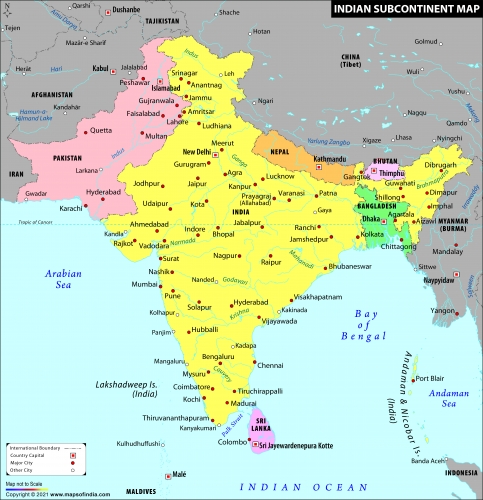
L’Inde est la clé de voûte du sous-continent éponyme qui compte le Pakistan, le Népal, le Bhoutan, le Bangladesh et le Sri Lanka, voire le Myanmar. Elle se projette aussi sur les autres continents quand on s’intéresse à sa diaspora. L’Indonésie, la Malaisie et Singapour accueillent des Indiens dont les aïeux sont venus s’installer à l’époque de l’Empire britannique. Des communautés indiennes anciennes résident en Afrique du Sud et en Afrique orientale (Kenya, Ouganda, Tanzanie), sur l’île Maurice et dans le département français ultra-marin de La Réunion.
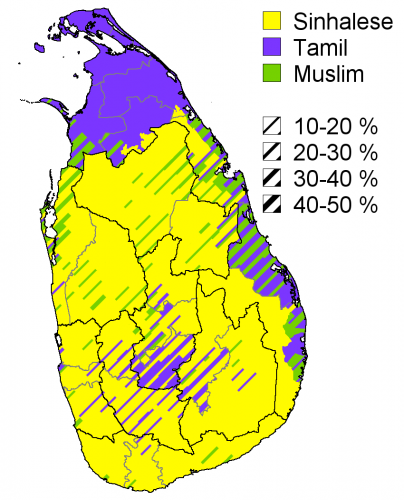
Cette présence suscite parfois des conflits. Les Tamouls de confession hindouiste ont longtemps revendiqué par les armes un État indépendant au Nord et à l’Est du Sri Lanka contre l’avis des Cinghalais bouddhistes. La question indienne a durablement perturbé la vie politique des Fidji dans l’océan Pacifique. Les nationalistes mélanésiens fidjiens ne supportaient pas la mainmise économique indienne sur l’archipel, d’où une série de coups d’État à la fin du XXe siècle. Cela n’empêcha pas qu’en 1999, le travailliste indo-fidjien Mahendra Chaudhry devienne le chef du gouvernement.
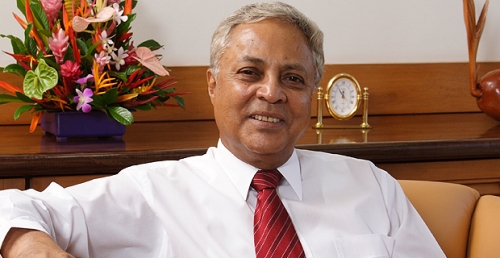
Les Fidji anticipaient une situation qui se reproduit maintenant dans le monde anglo-saxon. Le deuxième Premier ministre du roi Charles III est depuis octobre 2022, Rishi Sunak, premier hindouiste à occuper le 10, Downing Street. Si on considère les Pakistanais comme des Indiens de religion musulmane, le nouveau Premier ministre écossais s’appelle Humza Yousaf. Quant à la République d’Irlande, son Premier ministre, Leo Varadkar, a un père d’origine indienne. Au Canada, le principal animateur du NPD (Nouveau parti démocratique, une formation de gauche wokiste), Jagmeet Singh, est sikh ! L’actuelle vice-présidente des États-Unis d’Amérique, Kamala Harris, est jamaïcaine par son père et... indienne par sa mère.
Benjamin Disraeli rêvait de transférer la capitale de l’empire mondial britannique de Londres en Inde. Son désir se réalise en partie aujourd’hui avec l’arrivée au pouvoir des petits-enfants des colonisés de naguère. Les eaux de l’Indus et du Gange se mêlent à celles de la Tamise… Les Indiens peuvent pleinement se fondre dans l’Anglosphère puisqu’ils parlent couramment la langue anglaise et connaissent par cœur les codes anglo-saxons. Ils savent s’intégrer dans une mondialisation libérale américanomorphe bien mal en point.

Les Occidentaux gardent toujours en tête les images de bidonvilles de Calcutta où officiait Mère Teresa. Ils imaginent l’Inde en pays sous-développé avec ses millions de pauvres. Certes, la pauvreté n’a pas disparu. Cependant émerge et s’affirme une importante classe moyenne. Le groupe Tata détient les marques automobiles Jaguar, Land Rover et Hispano. L’industriel et homme d’affaires Lakshmi Mittal s’occupe d’Arcelor Mittal. L’Union indienne deviendra bientôt la troisième puissance économique mondiale. L’Inde ne dispose pas d’un siège permanent au Conseil de sécurité de l’ONU. Elle pourrait remplacer avec satisfaction le Royaume-Uni, ce caniche atlantiste !

Puissance nucléaire et civile, l’Inde maîtrise en outre les techniques aérospatiales avec sa base de lancement de fusées de Satish-Dhawan. Si Bangalore est la capitale informatique du pays, l’ancienne Bombay devenue Mumbay reste sa première place financière. Les studios de tournage et d’enregistrement qu’abrite cette mégalopole, « Bollywood », fournissent une grande partie de l’Asie et du Moyen-Orient en productions cinématographiques, télévisées et musicales.
Au pouvoir depuis 2014, le BJP (Parti du peuple indien) de Narendra Modi déroule une politique nationale-conservatrice libérale en économie. L’insistance gouvernementale à propager la numérisation des services publics et des activités marchandes constitue un indice préoccupant d’inclination sociétale vers un crédit social à la chinoise.
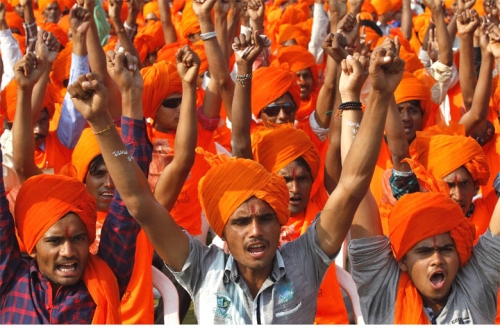
État-continent tendant vers un État civilisationnel potentiellement illibéral, l’Inde du BJP applique avec méthode son programme d’Hindutva. Or les quelque 800 langues usitées, la diversité des groupes ethniques et religieux et la permanence du système des castes malgré son interdiction constitutionnelle freinent les avancées d’une société unifiée par la couleur safran. Les nationalistes indiens se méfient par ailleurs des prosélytismes musulman et chrétien et surveillent l’activisme sikh en faveur d’un État sikh indépendant dans le Pendjab.
La politique gouvernementale indienne recèle enfin sa part de contradictions. L’Inde appartient à l’OCS (Organisation de coopération de Shanghai) qui comprend ses rivaux chinois et pakistanais. Proche d’Israël et hostile à l’islamisme politique, la Nouvelle Delhi entretient d’excellentes relations avec l’Iran et les Émirats arabes unis. Fidèle cliente en armement russe, l’Inde discute dans le cadre du « Quad » avec le bloc occidental atlantiste (États-Unis, Grande-Bretagne, Australie, Japon) afin de contrecarrer le « collier de perles » portuaire de la Chine dans l’océan Indien. Mais la patrie du non-alignement répugne à rejoindre clairement une alliance ou une entente exclusive. Elle préfère jouer sur les rivalités géopolitiques dans l’espoir d’en retirer le maximum de bénéfices. Ainsi vend-t-elle plus chers aux Occidentaux des hydrocarbures russes qu’elle a à peine reconditionnés.
Quelques oracles mentionnent un XXIe siècle chinois qui succéderait au XXe siècle étatsunien. D’autres parient sur un XXIe siècle indien du fait de la jeunesses de sa population. Conscients à la fois de ses forces indéniables, de ses atouts indiscutables, de ses faiblesses chroniques et de ses failles structurelles, les dirigeants indiens recherchent en priorité non pas une « grande politique » d’envergure intercontinentale, mais plutôt le contentement régulier des besoins élémentaires de leur population. C’est leur défi ! S’ils réussissent, ce sera alors un immense succès. Mais, pour l’instant, l’Inde-monde demeure toujours balbutiante.
GF-T
- « Vigie d’un monde en ébullition », n° 73, mise en ligne le 9 mai 2023 sur Radio Méridien Zéro.
11:18 Publié dans Actualité | Lien permanent | Commentaires (0) | Tags : inde, inde-monde, espace civilisationnel indien, asie, affaires asiatiques |  |
|  del.icio.us |
del.icio.us |  |
|  Digg |
Digg | ![]() Facebook
Facebook
mardi, 25 avril 2023
Les projets de double connectivité de l'Inde en Eurasie pourraient accélérer la dédollarisation

Les projets de double connectivité de l'Inde en Eurasie pourraient accélérer la dédollarisation
par Andrew Korybko
Source: https://www.ideeazione.com/i-progetti-di-doppia-connettivita-dellindia-in-eurasia-possono-accelerare-la-de-dollarizzazione/
La semaine dernière, plusieurs événements d'une grande importance pour la connectivité eurasienne ont échappé à la plupart des observateurs. Une délégation russe conduite par le vice-premier ministre Denis Manturov a conclu sa visite à Delhi, au cours de laquelle elle a exploré les possibilités de quintupler les exportations de l'Inde, un objectif précédemment déclaré par cette dernière. Cette visite a été suivie d'un protocole d'accord sur le transit et la coopération commerciale conclu à Moscou entre la Russie et l'Iran.
À la fin de la semaine, les compagnies ferroviaires de Russie, du Kazakhstan et du Turkménistan se sont mises d'accord sur leur propre mémorandum "pour mettre en place des tarifs compétitifs et un transport "sans rupture" des marchandises de [leurs pays] vers l'Iran, l'Inde et les pays du Moyen-Orient et de la région Asie-Pacifique". Le PDG du Fonds iranien de développement des transports a ensuite annoncé la possibilité d'investissements russes et indiens dans les infrastructures du pays.

Enfin, dimanche, le ministre indien des ports, de la navigation et des voies navigables, Sarbananda Sonowal, a inauguré à Chennai une série de projets qui, selon lui, renforceront le corridor maritime Vladivostok-Chennai (VCMC) avec la Russie. Ce développement s'ajoute aux précédents de la semaine dernière concernant les progrès sur le corridor de transport nord-sud (NSTC) entre la Russie, l'Iran, l'Asie centrale et, au moins officiellement, l'Azerbaïdjan également (à condition que les tensions régionales n'empêchent pas Bakou de jouer un rôle à l'avenir).
Ensemble, le NSTC et le VCMC représentent les deux projets de connectivité eurasienne non chinois les plus importants, qui visent à promouvoir l'intégration Sud-Sud afin d'éviter à titre préventif le scénario d'une dépendance potentiellement disproportionnée à l'égard de la République populaire. Toutes les parties entretiennent des liens commerciaux étroits avec Pékin, mais aucune d'entre elles ne souhaite que son rôle croissant dans les affaires économiques mondiales remplace celui, en déclin, de Washington. Ils souhaitent plutôt qu'il leur ouvre de nouvelles perspectives.
Les projets de double connectivité de l'Inde, qui intégreront le cœur de l'Eurasie par le biais du NSTC et feront de même avec le Rimland eurasien par le biais du VCMC (en gardant à l'esprit que le transit se fera par le biais de la puissance commerciale de l'ANASE), offrent une occasion unique d'accélérer les processus de multipolarité financière. Favoriser l'utilisation des monnaies nationales dans les échanges commerciaux par ces voies, au lieu de monnaies tierces telles que le dollar ou le yuan, peut jeter les bases d'une croissance exponentielle du commerce bilatéral au fil du temps.
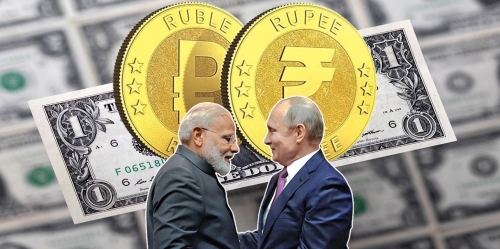
L'Inde est actuellement la cinquième économie mondiale et est en passe de devenir la troisième d'ici la fin de la décennie, ce qui cadre parfaitement avec son rôle attendu de leader informel du Sud dans la trifurcation des relations internationales qui s'annonce. Sur le plan financier, l'internationalisation attendue de la roupie peut être facilitée en encourageant ses partenaires du NSTC-VCMC à utiliser le nouveau modèle de dédollarisation qu'il a lancé avec le Bangladesh la semaine dernière.
Comme le résume l'analyse hyperliée ci-dessus, "toutes les exportations du partenaire le plus petit dans un duo d'Etats donné seront dédollarisées, tandis que le partenaire le plus grand les compensera par ses propres exportations". Cette politique pragmatique garantit qu'il y a suffisamment de monnaie nationale en circulation pour répondre à leurs besoins minimaux en matière de commerce bilatéral, tout en maintenant une quantité confortable de dollars en circulation pour faciliter leurs échanges avec d'autres pays qui se sentent encore à l'aise avec le billet vert".

L'accélération susmentionnée des processus de multipolarité financière serait multipliée si ce modèle était utilisé par les partenaires du NSTC-VCMC de l'Inde au sein de l'ANASE, de l'Azerbaïdjan, des républiques d'Asie centrale (RCA), de l'Iran et de la Russie, sans parler de l'adhésion de la République de Corée (ROK) et du Japon. Ces deux pays peuvent rester réticents à commercer avec la Russie en raison des pressions exercées par leur protecteur américain, mais ils peuvent toujours dédollariser leur commerce avec l'Inde en exploitant la vision VCMC de cette dernière.
En ce qui concerne l'avenir, il y a de nombreuses raisons d'être optimiste quant à la dédollarisation du commerce en Asie, grâce au rôle intégral que l'Inde est prête à jouer à cet égard par l'intermédiaire du NSTC-VCMC. Bien sûr, il faudra beaucoup de temps avant que des progrès tangibles ne soient réalisés, mais les bases de ces progrès sont là pour tous, grâce aux développements de la semaine dernière. Les observateurs seraient donc bien inspirés de suivre cette tendance, qui fait partie des plus importantes tendances financières qui se développent aujourd'hui, même si c'est de manière graduelle.
Publié en partenariat sur One World - Korybko Substack
21:33 Publié dans Actualité, Géopolitique | Lien permanent | Commentaires (0) | Tags : actualité, géopolitique, politique internationale, dédollarisation, inde, russie, chine, asie, affaires asiatiques |  |
|  del.icio.us |
del.icio.us |  |
|  Digg |
Digg | ![]() Facebook
Facebook
L'Inde introduit un modèle unique de dédollarisation

L'Inde introduit un modèle unique de dédollarisation
par Andrew Korybko
Source: https://www.ideeazione.com/lindia-sta-introducendo-un-modello-unico-di-de-dollarizzazione/
L'Inde et le Bangladesh ont convenu de dédollariser partiellement leurs échanges commerciaux selon un modèle unique qui pourrait devenir la norme mondiale dans un avenir proche. La totalité des 2 milliards de dollars d'exportations du Bangladesh vers l'Inde sera dédollarisée, tandis que l'Inde fera de même en dédollarisant un niveau équivalent de ses exportations vers le Bangladesh, d'une valeur d'environ 13,69 milliards de dollars. En d'autres termes, toutes les exportations du plus petit partenaire dans un duo d'Etats donné seront dédollarisées, tandis que le plus grand partenaire fera de même avec ses propres exportations.
Cette politique pragmatique garantit la circulation d'une quantité suffisante de monnaie nationale pour répondre aux besoins minimaux du commerce bilatéral, tout en conservant une quantité de dollars en circulation pour faciliter les échanges avec d'autres pays qui se sentent encore à l'aise avec le billet vert. C'est tellement simple que n'importe quel pays pourrait facilement imiter le modèle de ces deux pays, s'il en avait la volonté politique, ce qui est le cas d'un nombre croissant d'entre eux, après que les États-Unis ont utilisé le dollar comme arme contre la Russie l'année dernière.
À l'insu de la plupart des observateurs qui se concentrent exclusivement sur le rôle du yuan dans les processus de dédollarisation, la politique de commerce extérieur récemment dévoilée par l'Inde vise officiellement à internationaliser la roupie, une monnaie très prometteuse pour le rôle du pays en tant que cinquième économie mondiale. Ce n'est pas un hasard si l'Inde a choisi d'introduire son modèle unique de dédollarisation dans la région, car elle espère répandre l'utilisation de la roupie en Asie du Sud avant de le faire dans le reste du Sud mondial.
Cette démarche s'inscrit dans le cadre de la volonté de l'Inde de stimuler le commerce intra-régional, parallèlement à son ascension en tant que grande puissance d'importance mondiale. La Banque mondiale estime que ce chiffre n'est que de 23 milliards de dollars, soit un maigre 5 % comparé aux 25 % de l'ANASE. Si l'on se réfère aux statistiques citées précédemment, selon lesquelles le niveau du commerce bilatéral entre l'Inde et le Bangladesh est légèrement inférieur à 16 milliards de dollars au total (bien que d'autres sources affirment qu'il est supérieur à 18 milliards de dollars), cela signifie qu'au moins deux tiers du commerce intrarégional de l'Asie du Sud n'impliquent que ces deux pays.
Il est donc tout à fait logique que l'Inde dévoile d'abord son modèle unique de dédollarisation avec le Bangladesh, afin de le perfectionner avant d'étendre cette approche à l'ensemble de l'Asie du Sud et au-delà. D'autres pays feraient bien d'envisager de suivre l'exemple de l'Inde en dédollarisant partiellement leurs échanges avec leur partenaire régional le plus proche. Ce modèle pragmatique mérite d'être employé par le plus grand nombre de pays possible, car c'est lui qui a le plus de chances d'accélérer la multipolarité financière.
Publié en partenariat avec One World - Korybko Substack
21:19 Publié dans Actualité | Lien permanent | Commentaires (0) | Tags : actualité, dédollarisation, inde, roupie, bengladesh, asie, affaires asiatiques, politique internationale |  |
|  del.icio.us |
del.icio.us |  |
|  Digg |
Digg | ![]() Facebook
Facebook
lundi, 06 mars 2023
De l'Inde à l'Afrique, les tournées européennes ne sont pas à la hauteur des résultats annoncés

De l'Inde à l'Afrique, les tournées européennes ne sont pas à la hauteur des résultats annoncés
Augusto Grandi
Source: https://electomagazine.it/dallindia-allafrica-i-tour-euro...
Lady Garbatella (= Giorgia Meloni) s'envole pour l'Inde et les clercs de la désinformation italienne assurent que les résultats certains de cette visite inclueront la condamnation de la Russie par New Delhi. Manifestement, le premier ministre indien ne suit pas les médias italiens et n'exprime donc pas la moindre condamnation de Moscou avec qui, au contraire, les relations économiques et financières se sont intensifiées depuis le début de la guerre en Ukraine. Il est vrai que ce n'est pas Meloni qui s'est lancé dans des annonces dépourvues de signification, mais un démenti de temps en temps, son service de presse peut tout de même essayer d'en faire un.
Mais ce n'est pas comme si, sur la scène internationale, le rival de Lady Garbatella, Emmanuel Macron, faisait mieux, puisqu'il est en tournée en Afrique pour faire oublier les manifestations qui se succèdent sur le sol français et récupérer un peu d'espace et de crédibilité sur le continent noir où sévissent la Chine et la Russie, mais aussi l'Inde et la Turquie. Le pauvre Macron arrive au Gabon et l'accueil est froid. Puis, pourtant, l'environnement se réchauffe en République démocratique du Congo. Pas dans le sens espéré par le président français. Il est interpellé et insulté par une population qui accuse l'Hexagone de soutenir le Rwanda, coupable d'avoir perpétré des massacres au Congo.
Pour compléter le tableau des difficultés croissantes de la politique étrangère d'une Europe au service de Washington, l'ONU condamne la politique répressive menée par le gouvernement algérien. Mais comment ? L'Algérie tant encensée par Lady Garbatella et les ministres du gouvernement de droite et du centre, avec le soutien total des clercs de la désinformation italienne, pourquoi nous vend-elle à un prix élevé le gaz que nous achetions auparavant à un prix beaucoup plus bas à la Russie ? L'Algérie, partenaire clé du fantômatique "plan Mattei" ?
Il est évident qu'il s'agit d'une sale manœuvre de Poutine, qui contrôle l'ONU, pour mettre sous un mauvais jour un pays ami de l'Italie atlantiste. Dommage qu'en réalité Alger soit un partenaire stratégique de Moscou. Mais cela a dû échapper aux clercs du journalisme italien.
20:18 Publié dans Actualité, Affaires européennes | Lien permanent | Commentaires (0) | Tags : politique internationale, giorgia meloni, italie, emmanuel macron, france, inde, congo, rdc, affaires européennes, affaires asiatiques, affaires africaines |  |
|  del.icio.us |
del.icio.us |  |
|  Digg |
Digg | ![]() Facebook
Facebook
samedi, 04 mars 2023
Edward Law, le pionnier du Grand Jeu
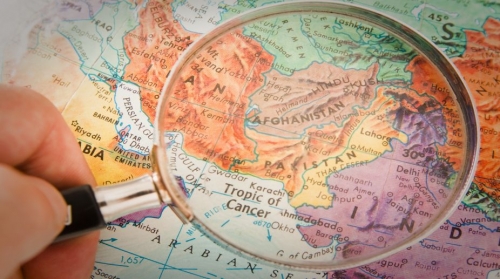
Edward Law, le pionnier du Grand Jeu
Emanuel Pietrobon
Source: https://it.insideover.com/schede/storia/edward-law-il-pio...
L'histoire, disait le philosophe Friedrich Nietzsche, est l'éternel retour du même. Un cycle qui se répète sans fin, où les mêmes événements ont tendance à réapparaître périodiquement sous une forme nouvelle ou déguisée. Un cycle duquel sortent de grands hommes dont les actes restent éternellement imprimés dans l'histoire pour guider les pas de ceux qui viendront après. Un cycle qui ne s'arrêtera jamais, car il est tout simplement inarrêtable.
Aujourd'hui comme hier, demain comme toujours, la dure loi de l'éternel retour du même écrit le présent des contemporains et dessine l'avenir de la postérité. Car notre présent, en effet, est l'ère des grands remakes géopolitiques: des nouvelles guerres russo-turques à la Guerre froide 2.0, en passant par la réédition de la course à l'Afrique et la renaissance du Grand Jeu en Asie centrale. Et ce dernier, le Grand Jeu 2.0, qui, par rapport au passé, est teinté de multipolarité, pourrait être mieux, compris, compris plus profondément en redécouvrant l'un des personnages qui a dominé sa version première : Edward Law, le premier comte d'Ellenborough.

Origines et éducation
Edward Law (tableau) est né à Londres le 8 septembre 1790. Fils d'artiste - son père était le célèbre Edward Law, MP, baron et Lord Chief Justice de la Cour d'Angleterre et du Pays de Galles -, Law est élevé dans un environnement aristocratique et reçoit une éducation de haut niveau. Il a été formé au Collège d'Eton et au Saint John's College de Cambridge - deux des institutions les plus prestigieuses du Royaume-Uni - où il a été initié aux arts de la politique et de la diplomatie.
En 1812, à seulement vingt-deux ans, le jeune Law entre en politique en portant la chemise des Tories, conservateurs fermement convaincus de la suprématie de l'anglicanisme sur le catholicisme et de la supériorité du pouvoir royal sur le pouvoir parlementaire. Après un premier passage de deux ans en tant que représentant d'un bourg pourri de Cornouailles, qui lui permet d'entrer à la Chambre des communes, il hérite en 1818 à la fois d'un siège à la Chambre des lords et du titre de baron de son père, décédé entre-temps.
Le Grand Jeu
En 1828, après avoir passé exactement une décennie à s'occuper de politique intérieure, Law est nommé Lord Keeper of the Privy Seal par le Premier ministre de l'époque, Arthur Wellesley, également connu sous le nom de Duc de Wellington, et commence à servir au sein du gouvernement en tant que conseiller en affaires étrangères.
Et c'est le duc de Wellington, un homme formé sur les champs de bataille et contre Napoléon, qui aurait entrevu quelque chose en Law : du talent, un sens aigu de la politique internationale. Placé à la tête de la commission de contrôle de l'East India Company, la longa manus de Londres la plus puissante au monde, Law aurait fait preuve d'une incroyable capacité à comprendre les affaires asiatiques, à en saisir la complexité et à soutenir le duc dans la défense des intérêts de la Couronne.
C'est Law, par exemple, qui a compris le caractère de pivot du territoire sous-continental de l'Inde, suggérant au duc de Wellington que sa souveraineté soit transférée de la Compagnie des Indes orientales à la Couronne. Et c'est également Law qui, sur fond d'études à distance de l'Inde, confia à son ami et explorateur Alexander Burnes la mission de visiter l'Asie centrale, inconnue et sauvage, pour tenter de comprendre pourquoi les tsars s'intéressaient tant à son sort (et à son contrôle).
Law allait bientôt s'avérer être le bon homme au bon endroit et au bon moment : le moment où le Grand Jeu a commencé. Fort de la confiance placée en lui par le duc de Wellington, ainsi que de son rôle puissant au sein de la Compagnie des Indes orientales, Law devint l'écrivain de l'ombre du programme de politique étrangère de la Couronne pour l'Asie centrale et l'Indo-Sphère.
Law avait compris une vérité jusqu'alors ignorée par ses compatriotes : l'Empire russe s'étendait dans la sulfureuse et chaotique Asie centrale dans le but d'atteindre l'Inde. Car le rêve caché de tous les souverains de la Troisième Rome, depuis l'époque pré-tsariste, avait toujours été le même : un débouché vers une mer chaude. Et l'Inde, désir des grands dirigeants depuis l'époque d'Alexandre le Grand, représentait l'un des débouchés chauds les plus géostratégiques du supercontinent.

L'habile stratège avait eu une révélation sur la manière d'empêcher les tsars d'étendre leurs tentacules sur l'Inde, pomme d'or de l'Empire britannique, et de gagner le Grand Jeu qui venait de naître. Une illumination qui fut accueillie favorablement par les dirigeants impériaux et qui reposait essentiellement sur les éléments suivants : la maîtrise de l'Afghanistan, l'anglicisation culturelle du dominion indien, la diplomatie secrète et le recours à des alliances impromptues, toujours anti-russes, avec les seigneurs du désert d'Asie centrale.
Law ne vivra pas assez longtemps pour assister à la conclusion de la plus importante confrontation hégémonique russo-britannique de l'histoire, mais il sera témoin de la concrétisation progressive de sa stratégie : les missions secrètes de Burnes entre l'Asie centrale et le sous-continent indien, l'expédition de Kaboul de 1842, les parties d'échecs avec les émirs afghans Dost Mahommed Khan et Shah Shujah Durrani et, enfin et surtout, l'instrumentalisation des différences interreligieuses et interethniques en Inde dans le but d'affaiblir les familles royales autochtones et de consolider l'hégémonie britannique.
La pertinence de la pensée de Law
En 1844, de retour d'une Asie (temporairement) pacifiée par la guerre, il reçoit une série de récompenses pour ses services à la Couronne, dont le titre de comte d'Ellenborough et la Grand-Croix de l'Ordre de Bath. Il passera les années suivantes à se battre chez lui pour la réduction de l'autonomie de la Compagnie des Indes orientales, pour la poursuite de l'assujettissement de l'Inde et pour attiser les esprits dans le turbulent Turkestan dans une visée anti-russe, consacrant son temps libre à la rédaction d'œuvres monumentales axées sur l'univers civilisationnel indien.
Il meurt en 1871, à l'âge avancé de quatre-vingt-un ans, laissant à la postérité un héritage inestimable en termes de clairvoyance politique et de stratégie diplomatique. Car aujourd'hui, à l'ère du Grand Jeu 2.0, l'ombre du comte d'Ellenborough plane de façon terrifiante sur ces terres indomptées qui s'étendent de Samarcande à Calcutta. Des terres qui, comme l'a montré le droit, peuvent s'avérer plus productives en étant instables qu'en étant stables. Des terres dont la déstabilisation hétérogène a servi et sert encore un large éventail d'objectifs : de l'endiguement de la Russie en tirant parti du tribalisme islamique dans les steppes d'Asie centrale à la réduction des ambitions de grandeur de la puissante mais fragile Inde.
Des terres, celles qui s'étendent de Samarkand à Calcutta, sans négliger le Caucase qui, hier comme aujourd'hui, et demain comme toujours, sont et seront les tranchées dans lesquelles les thalassocraties atlantiques et les tellurocraties eurasiennes se battent et se battront éternellement pour l'hégémonisation de l'île-monde.
Donnez-nous encore une minute de votre temps !
Si vous avez aimé l'article que vous venez de lire, demandez-vous : si je ne l'avais pas lu ici, l'aurais-je lu ailleurs ? S'il n'y avait pas InsideOver, combien de guerres oubliées par les médias le resteraient ? Combien de réflexions sur le monde qui vous entoure ne seriez-vous pas en mesure de faire ? Nous travaillons chaque jour pour vous fournir des reportages de qualité et des articles de fond totalement gratuits. Mais le type de journalisme que nous faisons est tout sauf "bon marché". Si vous pensez que nous méritons d'être encouragés et soutenus, faites-le maintenant.
19:02 Publié dans Actualité, Eurasisme, Géopolitique, Histoire | Lien permanent | Commentaires (0) | Tags : edward law, angleterre, russie, inde, asie centrale, eurasisme, grand jeu, histoire, géopolitique |  |
|  del.icio.us |
del.icio.us |  |
|  Digg |
Digg | ![]() Facebook
Facebook
mardi, 29 novembre 2022
Comment les États-Unis poussent l'Inde vers la multipolarité
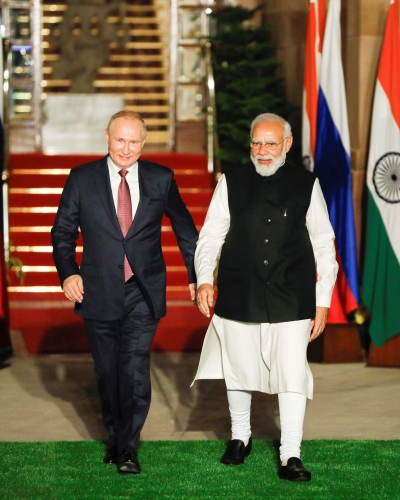
Comment les États-Unis poussent l'Inde vers la multipolarité
par Katehon Editor
Source: https://www.ideeazione.com/come-gli-stati-uniti-stanno-spingendo-lindia-verso-il-multipolarismo/
Depuis quelques mois, les États-Unis ont tenté à plusieurs reprises de forcer l'Inde à rompre ses liens avec la Russie, abandonnant ainsi ses intérêts nationaux. New Delhi continue toutefois de résister aux tentatives américaines de soumettre son économie aux diktats de Washington.
La dernière controverse concernait la tentative du G7 d'imposer un contrôle des prix du pétrole russe et les interdictions de l'UE et du Royaume-Uni frappant le transport maritime et les services liés au pétrole russe.
L'Inde n'est pas intéressée à rejoindre l'initiative menée par les États-Unis, car elle bénéficie d'une réduction importante sur le pétrole en provenance de Russie et souhaite maintenir des relations avec un partenaire stratégique de longue date. Le ministre indien des Affaires étrangères, Subramaniam Jaishankar, s'est rendu à Moscou le 8 novembre pour discuter de la poursuite des ventes de pétrole. Il a déclaré que l'Inde avait l'intention de continuer à acheter du pétrole russe, ignorant une nouvelle fois les appels lancés par les États-Unis à leurs alliés et partenaires pour isoler la Russie des marchés mondiaux.
Les projets du G7 risquent de faire grimper les prix du pétrole (malgré les déclarations contraires de la secrétaire américaine au Trésor, Janet Yellen) et de réduire la disponibilité des pétroliers, mettant ainsi en péril la sécurité énergétique de l'Inde et portant atteinte à son économie, qui est le troisième consommateur et importateur de pétrole au monde.
La Russie a déclaré qu'elle ne vendrait pas de pétrole à un pays impliqué dans le système de plafonnement des prix, et Jaishankar a répété à plusieurs reprises que l'Inde ne peut pas se permettre d'acheter du pétrole à des prix élevés, du moins pas sans nuire à sa croissance économique, qui devrait être de 6,1 % en 2023, faisant de l'Inde la grande économie à la croissance la plus rapide du monde. Selon Energy Intelligence, la Russie est devenue le premier fournisseur de pétrole brut de l'Inde en octobre, avec plus de 900.000 barils par jour, ce qui représente environ un cinquième des exportations de pétrole de l'Inde.
La principale préoccupation des deux pays est de s'assurer que le brut russe continue à circuler après les interdictions imposées par l'UE et le Royaume-Uni le 5 décembre et les plafonds de prix connexes du G7.
En raison de cette attitude attentiste, il n'y a toujours pas de clarté. Bruce Paulsen, expert en sanctions et partenaire du cabinet d'avocats Seward & Kissel, estime que "si les orientations sur la conformité [au plafonnement des prix] n'arrivent pas rapidement, certains acteurs de l'industrie pourraient être laissés en plan jusqu'à ce qu'ils soient en mesure de déterminer si les prix affectent la sécurité de l'approvisionnement".
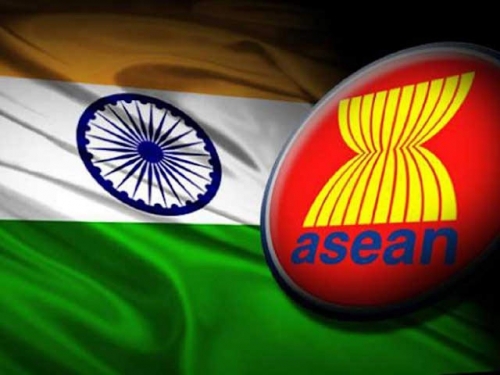
Les États-Unis ont temporairement cessé de faire pression sur l'Inde pour qu'elle respecte les plafonds de prix, et Mme Yellen déclare maintenant que Washington est "heureuse" si New Delhi continue à acheter tout le pétrole russe qu'elle souhaite, même à des prix supérieurs aux plafonds de prix du G7. Même si l'Inde ne peut pas utiliser les services d'assurance, financiers ou maritimes occidentaux pour transporter le pétrole.
Les raffineries indiennes peuvent traiter 600.000 bpj supplémentaires de brut russe, à condition qu'elles battent les principaux grades du Moyen-Orient, qui constituent la base de raffinage du pays, soit 5 millions de bpj. Mais la disponibilité de la livraison et de l'assurance, ainsi que des canaux de paiement, est cruciale. À partir du 5 décembre, les pétroliers et les compagnies d'assurance maritime liés aux pays de l'UE et du G7, qui dominent les expéditions mondiales de pétrole, se verront interdire le commerce du brut russe, à moins que ces volumes ne soient vendus à un prix maximum, qui n'a pas encore été déterminé. En outre, 90 % du commerce liquide de l'Inde est assuré par des pétroliers étrangers, ce qui crée des problèmes. L'assurance en elle-même ne semble pas si problématique et les entreprises russes et chinoises pourraient être en mesure de s'en charger.
Cela pourrait rendre la Russie dépendante d'une flotte fantôme de vieux pétroliers qui ne s'échangent pas en dollars. Récemment, Braemar, une société de courtage, a signalé que 33 pétroliers qui transportaient des exportations iraniennes ou vénézuéliennes, transportent depuis avril des exportations russes, principalement vers la Chine et accessoirement vers l'Inde.
Cette "flotte fantôme" représente les pétroliers qui ont transporté du pétrole iranien ou vénézuélien au moins une fois au cours de l'année écoulée. Le nombre total de ces pétroliers s'élève désormais à 240, pour la plupart de petite et moyenne taille, dont 74 % sont âgés de 19 ans ou plus. Quatre-vingts de ces navires sont de très gros transporteurs de brut (VLCC, pétroliers de 2 millions de barils), qui ne pourraient pas faire escale dans les ports russes, mais pourraient être utilisés pour transporter des cargaisons russes d'un navire à l'autre.
Dans le même temps, Washington fait pression sur New Delhi pour qu'elle respecte les plafonds de prix et importe davantage de gazole sous vide de l'Inde, qui est utilisé dans les raffineries pour produire d'autres produits tels que l'essence et le diesel. La Russie était un fournisseur clé de gazole sous vide pour les raffineries américaines jusqu'en février 2022.
Les sanctions américaines et européennes ne s'appliquent pas aux produits raffinés fabriqués à partir de pétrole russe exporté depuis un pays tiers, car ils ne sont pas d'origine russe. En Inde, les raffineurs ont augmenté leurs importations de brut russe à 793.000 bpj entre avril et octobre, contre seulement 38.000 bpj sur la même période un an plus tôt, selon les données commerciales.
Dans le contexte où les États-Unis tentent de construire leur stratégie indo-pacifique pour affronter la Chine, les actions de New Delhi causent clairement des problèmes à Washington. La possibilité que l'Inde poursuive ses propres intérêts nationaux ne semble pas avoir été prise en compte dans cette stratégie.
Les tensions sur la limitation des prix du pétrole en provenance de Russie ne sont que les dernières d'une série de désaccords entre New Delhi et Washington. Les sanctions américaines sur les exportations de pétrole iranien privent également l'Inde du pétrole iranien bon marché et l'obligent à acheter des exportations énergétiques plus chères aux États-Unis. L'Inde est actuellement le plus grand exportateur de pétrole des États-Unis.
Tout comme Washington arme la Grèce et Chypre dans le but de forcer la Turquie à couper ses liens avec la Russie, les États-Unis font de même au Pakistan pour faire pression sur l'Inde. Après avoir renversé l'ancien Premier ministre pakistanais Imran Khan, qui accuse les États-Unis de lui avoir fait perdre le pouvoir lors d'un vote de défiance, Washington tente de trouver des approches pour le nouveau gouvernement. En septembre, le département d'État américain a provoqué la colère de l'Inde en approuvant un contrat de 450 millions de dollars pour moderniser la flotte d'avions de chasse F-16 du Pakistan. Peu après, l'ambassadeur américain au Pakistan a fait monter la tension lors d'une visite de la partie du Cachemire contrôlée par le Pakistan, qu'il a appelée "Cachemire administré par le Pakistan" au lieu du "Cachemire administré par le Pakistan" approuvé par l'ONU.
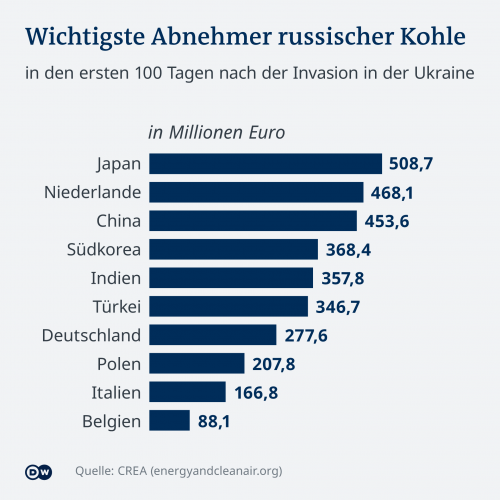

Le 8 novembre, le porte-parole du département d'État américain, Ned Price, a même fait la leçon à l'Inde sur ce qui est dans son intérêt : "Nous avons également indiqué clairement que ce n'est pas le moment de faire comme si de rien n'était avec la Russie, et les pays du monde entier ont l'obligation de faire tout leur possible pour relâcher leurs liens économiques avec la Russie. Il est dans l'intérêt collectif, mais aussi bilatéral, des pays du monde entier de mettre fin à leur dépendance vis-à-vis de l'énergie russe et, bien sûr, de s'en débarrasser au fil du temps. Plusieurs pays ont fait l'amère expérience que la Russie n'est pas une source d'énergie fiable. La Russie n'est pas un fournisseur de sécurité fiable. La Russie est loin d'être fiable dans tous les domaines. Il est donc non seulement dans l'intérêt de l'Ukraine, non seulement dans l'intérêt de la région, mais aussi dans l'intérêt collectif de l'Inde de réduire sa dépendance à l'égard de la Russie au fil du temps, mais aussi dans le propre intérêt bilatéral de l'Inde, étant donné ce que nous avons vu en Russie".
Bien sûr, ce n'est pas vrai. Et l'Inde en est bien consciente. L'Indian Observer Research Foundation a publié le 2 novembre les résultats d'un sondage montrant que 43% des Indiens considèrent la Russie comme le partenaire le plus fiable pour leur pays, loin devant les Etats-Unis (27%). Washington n'explique pas pourquoi il serait préférable pour l'Inde de réduire ses liens économiques avec la Russie.
Le commerce bilatéral de l'Inde avec la Russie a atteint le niveau record de 18,2 milliards de dollars entre avril et août de cette année fiscale, selon les derniers chiffres du ministère du Commerce. La Russie devient ainsi le septième partenaire commercial de l'Inde, contre le 25e l'année dernière. Les États-Unis, la Chine, les Émirats arabes unis, l'Arabie saoudite, l'Irak et l'Indonésie sont toujours devant la Russie.
L'Inde, l'Iran et la Russie ont également passé les deux dernières décennies à développer le corridor de transport international Nord-Sud pour stimuler le commerce entre les pays, ce qui a pris une importance accrue avec l'imposition de sanctions occidentales à Moscou. LoadStar rapporte que RZD Logistics, une filiale du monopole ferroviaire russe RZD, a lancé des services réguliers de trains de conteneurs de Moscou à l'Iran pour servir le commerce croissant avec l'Inde par transbordement.
L'objectif est de maximiser l'utilisation du corridor international de transport Nord-Sud (INSTC), un réseau de fret multimodal transfrontalier en Asie centrale qui aide les deux partenaires stratégiques à surmonter les défis de la chaîne d'approvisionnement causés par les sanctions occidentales contre la Russie.
Selon des sources industrielles, le temps de transit le long de la route nationale "océanique" est estimé à 35 jours, contre environ 40 pour les transports traditionnels précédents.
La pression exercée sur l'Inde ne semble qu'encourager New Delhi à chercher des moyens de s'affranchir de la dépendance au dollar. Loadstar ajoute que la Reserve Bank of India introduit également de nouvelles directives réglementaires pour aider les exportateurs à payer leurs expéditions en roupies plutôt qu'en dollars. La Fédération des organisations d'exportation indiennes fait également pression sur le gouvernement pour qu'il introduise une méthode de change alternative en dehors du marché russe. Il est intéressant de noter que le Pakistan demande au ministère russe du commerce d'introduire un mécanisme d'échange de devises afin de renforcer les liens économiques entre les deux pays.
Les États-Unis et l'Occident, par leurs actions irréfléchies, poussent l'Inde et d'autres pays à revoir leurs itinéraires logistiques et à chercher des solutions financières et économiques alternatives.
19:00 Publié dans Actualité, Géopolitique | Lien permanent | Commentaires (0) | Tags : actualité, politique internationale, géopolitique, inde, russie, asie, affaires asiatiques |  |
|  del.icio.us |
del.icio.us |  |
|  Digg |
Digg | ![]() Facebook
Facebook
samedi, 29 octobre 2022
L'Inde "conquiert" Downing Street: avec Sunak, l'aube d'un nouveau Royaume-Uni
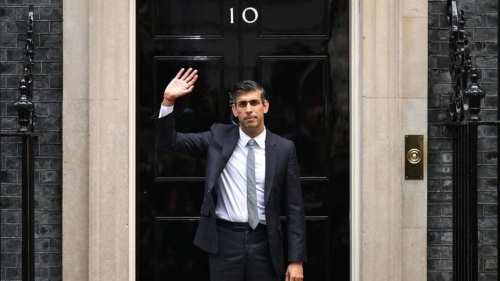
L'Inde "conquiert" Downing Street: avec Sunak, l'aube d'un nouveau Royaume-Uni
Andrea Muratore & Emanuel Pietrobon
Source: https://insideover.ilgiornale.it/politica/lindia-conquista-downing-street-con-sunak-lalba-di-un-nuovo-regno-unito.html
24.10.2022: c'est la date que la postérité retiendra pour dire que l'ère post-anglo-saxonne de l'Empire britannique a officiellement commencé. Date coïncidant avec la victoire de Rishi Sunak dans la course éliminatoire pour la direction du Parti conservateur britannique, qui fait de lui, en remplacement de Liz Truss, le premier chef de gouvernement d'origine indienne de l'histoire du pays.
Plus britannique que jamais, ancien banquier de Goldman Sachs, une carrière à la City suivie d'une ascension fulgurante dans les rangs des Tories, passé le poste de Chancelier de l'Échiquier à l'ère du Covid et de l'édification de la Grande-Bretagne globale, Sunak impose un changement structurel. Car Sunak, en effet, n'est rien de moins que la personnification du Royaume-Uni en mutation, ou plutôt déjà muté car devenu post-anglo-saxon et multiracial, mais non pas post-impérial.
Indien, oui, mais britannique
Le néo-premier ministre né à Southampton le 12 mai 1980 est le fils de parents d'origine indienne, nés au Kenya et en Tanzanie, qui se sont installés au Royaume-Uni dans les années 1960. Sur tous les fronts, c'est un fils, sinon un petit-fils de l'empire d'autrefois, qui est devenu le porte-drapeau de la Grande-Bretagne globale qu'il envisageait comme centrée sur Londres, le nouveau "Singapour sur la Tamise", en tant que premier centre financier du monde.
Sunak est le premier premier ministre nommé par le roi Charles III, un souverain plus complexe que la vulgate ne le dépeint : cultivé, instruit plus qu'aucun de ses prédécesseurs, le premier roi à recevoir une éducation non pas militaire mais politique, littéraire et sociale. Dirigeant post-impérial et post-colonial par définition, Charles est né en 1948, un an après la fin de la domination coloniale de Londres sur le sous-continent indien, et est aujourd'hui le monarque sous le trône duquel le premier ministre en charge est une figure si symbolique.
Le pragmatique Sunak incarnera-t-il la Grande-Bretagne post-britannique ? La nation qui a vu la Grande-Bretagne affirmer le Brexit comme l'ultime épopée impériale aux peuples de son pays connaîtra-t-elle ses propres troubles dans sa proche banlieue ? Et comment le premier fils de l'empire parviendra-t-il à gouverner ? Sunak sera-t-il plus global que britannique dans ses choix en matière de politique économique - il n'est pas hyper-libéral, il est cependant un libre-échangiste convaincu -, d'identité - il est bien moins extrémiste que nombre de ses collègues de parti - et de politique étrangère ? Que deviendra la relation spéciale avec Washington maintenant que Londres s'est montré vulnérable sur le front intérieur en premier lieu ? Et qu'adviendra-t-il des relations avec l'Inde, maintenant qu'un descendant de l'ancienne colonie dirige le pays ? Toutes ces questions sont légitimes.
La revanche de la périphérie sur le centre
L'histoire, comme on le sait, adore se moquer de l'homme. Le 24 octobre, alors que les hindous et les jaïnistes du monde entier étaient occupés à célébrer Diwali - l'une des fêtes les plus importantes de l'Indosphère, un moment de liesse où les fidèles se souviennent que le Bien triomphe toujours du Mal - un événement capital s'est produit à Londres : un Indien naturalisé britannique, Rishi Sunak, est devenu Premier ministre. Coïncidence, ou destin, selon votre point de vue.
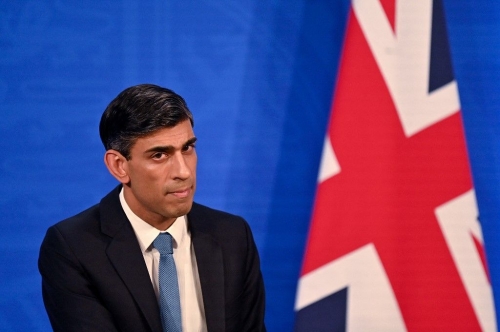
Il était question d'un gouvernement Sunak depuis des mois, depuis la crise de BoJo, nous ne sommes donc pas confrontés à ce que l'on appellerait habituellement un coup de tonnerre. Mais cela n'enlève rien au caractère mémorable de l'événement. Premier ministre d'origine indienne. Emblème de l'entrée du Royaume-Uni dans une nouvelle ère, d'ailleurs irréversible - car la démographie est le destin -, aux caractéristiques post-anglo-saxonnes et multiraciales. L'accomplissement de la prophétie de Macaulay.
Sunak n'est pas moins britannique que de naissance, et son CV est explicite à cet égard, mais ce qui est indéniable, c'est qu'il représente, à la fois, la revanche des périphéries sur le centre et le symbole d'une nouvelle nation multinationale, dynamisée par l'affirmation et l'activisme des fils des anciennes colonies et, bien qu'imperceptiblement, par le lobbying omniprésent et influent des membres du Commonwealth.
L'ascension de Sunak a eu lieu en plein jour, est-il écrit, et cela se rapporte directement au discours sur le pouvoir croissant des banlieues (et de leur progéniture) à influencer la dynamique interne de la métropole déconfite. Une ascension largement prédite car accompagnée de complots et de sabotages dans le dos de BoJo, dont Sunak a été l'architecte de la chute - déclenchant la crise gouvernementale en juillet - et qui n'aurait jamais été possible si le "parti minoritaire" de Downing Street, dirigé par les Pakistanais Sajid Javid et Saqib Bhatti, l'Irakien Nadhim Zahawi et les Indiennes Priti Patel et Suella Braverman (photo, ci-dessous), ne l'avait pas soutenue et popularisée. Complots et sabotages se sont ensuite redirigés au détriment de Liz Truss, qui a également été boycottée sur le plan intérieur par les primevères rouges du parti indien - en particulier le ministre Braverman - et, sur le plan extérieur, mise en difficulté par un curieux bras de fer avec New Delhi.
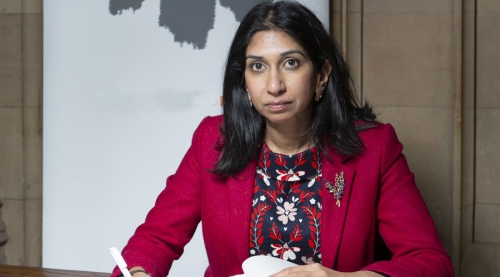
Homme de Londres ou homme de New Delhi ?
Trois raisons peuvent expliquer l'ascension impétueuse de Sunak, le premier ministre britannique du Joyau de la Couronne, à la lumière de ce qui s'est passé dans les coulisses de Downing Street.
La première est la moins diégétique : Sunak a senti le potentiel du parti minoritaire, de plus en plus nombreux et influent, et l'a utilisé à son avantage pour donner le coup de grâce à ses rivaux impopulaires. La revanche (authentique et sans malice) du Commonwealth sur Londres.
La deuxième et la troisième sont similaires mais différentes : la montée en puissance de Sunak comme faisant partie d'un plan astucieux scénarisé par des esprits raffinés basés soit en Angleterre, et donc stabilisateurs, soit en Inde, et donc puissamment inquiétants.
Le premier cas. Il pourrait s'agir d'une tentative, née dans les coulisses, de restaurer le calme en Grande-Bretagne afin qu'elle puisse poursuivre le rêve post-Brexit d'une Grande-Bretagne globale, dont le couronnement serait inévitablement le scellement d'une relation spéciale avec l'Inde - une mission échouée par BoJo, perdue dès le départ par Truss et que seul un homme comme Sunak, un véritable enfant du Gange, aurait une réelle chance de mener à bien. L'entrée de Londres dans l'ère post-anglo-saxonne comme fonction préparatoire à un retour impérial.
Le deuxième cas. On serait alors confronté à un phénomène exceptionnel : la transformation de New Delhi en un acteur décisif dans les équilibres internes de la Grande-Bretagne. Un acteur capable de les consolider ou de les briser, selon l'intérêt et la contingence, avec l'aide de sa progéniture insérée aux postes économiques et politiques clés. La métropole otage de l'(ancienne) périphérie.
Quelle que soit la durée réelle du mandat de Sunak, l'intrigue qui a permis son succès ne restera pas dans l'histoire comme un épisode impromptu, mais comme un événement décisif - un tournant entre deux époques. Il y aura un avant et un après Sunak. L'après-Sunak coïncidant avec un Royaume-Uni pleinement conscient de sa multiracialité et de l'érosion progressive de l'idée même de britannicité. La question est de savoir si et dans quelle mesure cette transformation aura des répercussions internationales importantes et, surtout, au profit de qui.
20:06 Publié dans Actualité, Affaires européennes | Lien permanent | Commentaires (0) | Tags : grande-bretagne, royaume-uni, europe, affaires européennes, inde, politique internationale, actualité, rishi sunak |  |
|  del.icio.us |
del.icio.us |  |
|  Digg |
Digg | ![]() Facebook
Facebook
lundi, 26 septembre 2022
"Vilayat Khorasan", une menace pour toute l'Asie centrale"
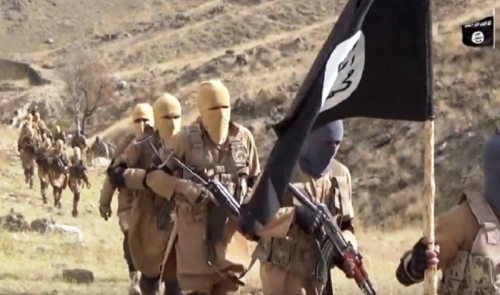
"Vilayat Khorasan", une menace pour toute l'Asie centrale"
par le comité de rédaction de Katehon
Source: https://www.ideeazione.com/vilayat-khorasan-una-minaccia-per-tutta-lasia-centrale/
Le groupe terroriste État islamique (interdit dans la Fédération de Russie) n'a pas été complètement anéanti. Malgré quelques succès contre le terrorisme en Syrie et en Irak, nous pouvons constater une résurgence des activités de l'organisation dans d'autres régions. En particulier, une branche autonome de l'État islamique de la province du Khorasan (ISKH), également connu sous le nom de Vilayat Khorasan (interdit dans la Fédération de Russie), opère dans une vaste zone englobant l'Asie centrale, l'Afghanistan, le Pakistan et l'Iran. À cet égard, l'adhésion de l'Iran à l'OCS est importante en tant que facteur de stabilisation. En outre, les Talibans, actuellement interdits en Russie, doivent être reconnus comme un acteur légitime pour aborder conjointement les questions de sécurité dans la région. L'ISIL, comme l'ISIS, est un agent par procuration de l'Occident collectif, donc unir les forces à temps pour le combattre est un impératif clé.
Vilayat Khorasan
L'ISKH est né au cœur du Khorasan historique, entre l'Afghanistan et le Pakistan. L'unité est apparue entre mi-2014 et début 2015, lorsque d'anciens commandants du Tehreek-e-Taliban (TTP) interdit au Pakistan, provenant de différentes régions des anciennes zones tribales fédérales (FTA), ont fait défection et se sont unis autour du leadership de Hafiz Saeed Khan Orakzai, car le TTP connaissait des divergences internes à propos de la nomination de Fazlullah Khorasani comme nouvel émir du TTP. Le successeur de Fazlullah et actuel émir du TTP, Noor Wali Mehsud, qui déclare dans son livre Inkilab-e-Mehsud que les circonscriptions de Mohmand, Orakzai, Kurram, Khyber et la moitié de celle de Bajaur ont quitté le TTP pour rejoindre l'IS ainsi que la circonscription de Peshawar. Ils ont été suivis par d'autres groupes et commandants pakistanais tels que le groupe Abdul Kahir Khorasani-ul-Islam de Khorasani, comme le montre une vidéo publiée en janvier 2015.
Le groupe a officiellement prêté allégeance à l'IS en janvier 2015 et était basé dans la province de Nangarhar, dans l'est de l'Afghanistan, principalement dans les districts d'Achin, Niazan, Mahmud Dara, Chaparhar et Shinwar. Lorsque le groupe a lancé sa campagne contre le gouvernement de Kaboul et les talibans, ses zones opérationnelles se sont étendues à d'autres provinces comme Kunar, Herat, Samangan, Kunduz, Jawzjan et Kaboul. La plupart des cibles du groupe sont des soldats afghans, la minorité chiite et les talibans, y compris les universitaires et les personnalités religieuses qui les soutiennent.
Le groupe continue également à opérer au Pakistan, notamment à Orakzai, Bajaur, Peshawar et au Baloutchistan. Au départ, toutes les attaques menées en Afghanistan, au Pakistan et au Cachemire ont été revendiquées au nom de l'ISKH. Cependant, alors que le groupe perdait le contrôle de ses bastions territoriaux dans les provinces afghanes de Kunar et de Nangarhar au milieu ou à la fin de 2019, l'IS a commencé à revendiquer toutes les attaques au Pakistan sous le nom d'une nouvelle province, l'État islamique des provinces du Pakistan (ISPP). Puis, en juillet 2021, Wali Abu Mahmood de l'ISPP a publié une déclaration indiquant que la province pakistanaise de Khyber Pakhtunkhwa avait été conquise par l'ISPP sur ordre de ce dernier, ce qui a incité le groupe à revendiquer toute attaque ultérieure dans la région au nom de l'ISPP.
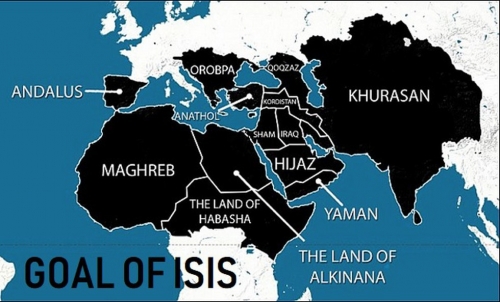
Au Pakistan, l'ISKH a mené des attaques contre les forces de sécurité, les journalistes, les travailleurs de la santé et les groupes religieux tels que les chiites et les soufis.
Depuis le second semestre 2021, l'ISKH cherche à se régionaliser et à s'internationaliser davantage. Cela se reflète dans la propagande médiatique, l'augmentation des agressions contre les États voisins et l'expansion des activités contre les pays de la région.
L'expansion internationale marquée des activités de propagande, de recrutement et de collecte de fonds de l'ISIL, en plus de cibler un nombre croissant de pays par des menaces et des attaques, pourrait avoir des répercussions importantes sur la sécurité des États entourant l'Afghanistan et peut-être même au-delà de la région, car les activités de l'ISIL en Syrie et en Irak ont eu un impact international.
En général, les activités de l'ISIL peuvent viser directement des citoyens et des étrangers dans la région, elle peut attaquer les États voisins depuis le territoire afghan et mener des incursions transfrontalières, ainsi que diriger et fomenter des attaques à l'étranger, par exemple dans les pays de l'UE. On sait que l'ISKH a tenté de faire exploser l'ambassade turkmène en août 2021, qu'il a lancé des roquettes en Ouzbékistan en avril et au Tadjikistan en mai 2022, qu'il a attaqué des gardes-frontières alors qu'il tentait de franchir la frontière entre l'Afghanistan et l'Asie centrale en 2019, et qu'il a développé des liens avec diverses cellules, comme le groupe tadjik qui préparait des attentats en Allemagne en 2019.
Le mois d'août 2021 a vu une forte augmentation du sentiment et de la rhétorique anti-chinois de la part de publications pro-ISKH telles que Khalid Media, Khorasan Wilayah News et Al Millat Media, alors que les Talibans reprenaient le contrôle de l'Afghanistan. Depuis lors, Al Azaim a continué à développer et à amplifier des récits qui défient les talibans sur ce front, les accusant récemment d'"amitié avec la Chine, qui tue des musulmans ouïgours" et, à une autre occasion, promettant que "bientôt, les guerriers de l'État islamique attaqueront les villes chinoises modernes pour venger les musulmans ouïgours".
Plus tôt cette année, le porte-parole de la SGI, Al-Azaim, a publié une vidéo appelant les zones tribales du Pakistan et du Baloutchistan à demander à leur population d'abandonner les talibans et Islamabad et de rejoindre l'ISKH.
Le SGI tenterait également de décourager les investissements étrangers et les projets de développement en Afghanistan qui renforceraient la position des talibans et saperaient la crédibilité du gouvernement afghan actuel en matière de sécurité.
La situation en Afghanistan
En 2020, le SGI a intensifié à la fois les attaques militantes et la campagne de guerre de l'information. Immédiatement après la conquête de Kaboul par les talibans, l'organe d'information de la SGI, Al-Azaim, a publié un livre d'Abu Saad Mohammad Khorasani, un idéologue de premier plan de l'ISKH, expliquant toutes les raisons pour lesquelles les talibans sont les pires ennemis de l'Islam. Ce message avait pour but de délégitimer les talibans représentant le nouveau gouvernement. Au cours des mois suivants, presque toutes les publications de l'ISKH ont abordé la soi-disant nature anti-islamique du gouvernement taliban, en les qualifiant de "polythéistes", de partisans des enseignements supérieurs de l'Islam Deobandi/Hanafi, de laïcs et de démocrates, et de hawarij (parias de l'Islam). Dans ses publications, l'ISKH reproche aux talibans d'être des "mercenaires payés par les États-Unis" et d'introduire la démocratie. Les attaques contre les talibans et les missions diplomatiques sont attribuées à la fois aux visites internationales et au fait que d'autres pays entretiennent des relations avec les talibans. L'attentat suicide près de l'ambassade de Russie à Kaboul confirme encore cette stratégie de l'ISKH. L'acceptation de l'aide étrangère est également une question controversée pour l'ISKH, qui a récemment condamné fermement les talibans pour leur collaboration avec des organisations internationales telles que l'USAID et le Comité international de la Croix-Rouge. Les puissances régionales telles que l'Iran, l'Ouzbékistan, la Russie, la Chine et le Pakistan sont également la cible de critiques en Afghanistan.
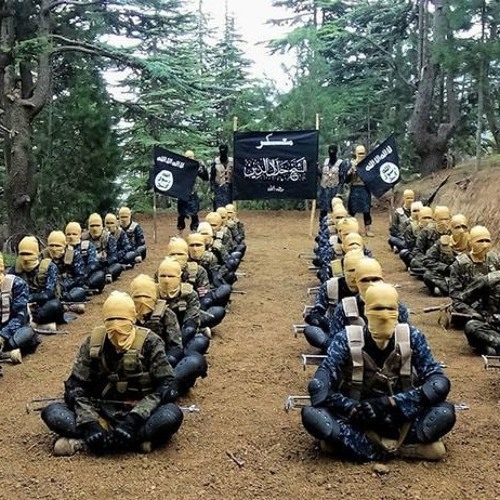
L'Iran et les activités anti-chiites
La campagne de propagande contre les chiites est typique de la nature sectaire de l'État islamique, mais l'ISKH a lié la lutte contre les chiites à la concurrence avec les talibans et à l'inimitié avec l'Iran. Le groupe a mené plusieurs attaques contre les chiites depuis l'arrivée au pouvoir des talibans, non seulement en Afghanistan mais aussi au Pakistan. Toutes ces opérations ont attiré l'attention des publications locales et des grands médias IS. Dans le même temps, il a été affirmé que leur campagne contre les chiites était non sectaire, car ils ne les considéraient pas comme des musulmans.
L'ISKH a émis une fatwa les autorisant à attaquer les lieux de culte des chiites, des autres sectes islamiques et des minorités non musulmanes.
L'ISKH considère que les talibans et les chiites travaillent ensemble, affirmant que les premiers protègent et donnent du pouvoir aux seconds, soulignant souvent la nomination par les talibans d'un gouverneur hazara chiite de Sari-e-Pul (bien que relativement récemment tué par les talibans lors de l'insurrection). Dans le même temps, l'ISKH accuse les talibans de tuer des salafis innocents, comme dans le cas des érudits salafistes Obaidullah Mutawakkil, Mustafa Darwishzadeh et Sardar Wali, pointant du doigt leurs meurtres comme preuve que les talibans favorisent les chiites par rapport à leurs camarades sunnites. La rhétorique de l'ISKH tend également à associer les communautés chiites nationales à l'ennemi extérieur déclaré, l'Iran.
La propagande contre l'Iran est continue depuis la création de l'ISKH, qui accuse le gouvernement iranien d'apostasie et d'être l'hôte d'Al-Qaeda, qui est interdit en Russie. L'ISKH affirme que l'Iran est le deuxième plus grand ennemi de l'Islam (après le Royaume d'Arabie Saoudite et avant le Pakistan), tandis que d'autres textes affirment que l'Iran et la Russie ont conjointement vaincu l'État islamique en Syrie, en Irak et en Afghanistan avec l'aide des Talibans. Le célèbre magazine en langue pachtoune Khurasan Ghag publie souvent des articles contre les chiites et directement contre l'Iran et ses dirigeants.
L'intérêt de l'ISKH à diffuser sa propagande sectaire auprès des communautés sunnites parlant le farsi est démontré par la traduction en farsi du troisième numéro du Khorasan Ghag, intitulé Sadae Khorasan. Dans le même temps, à un niveau non officiel, les chaînes en farsi affiliées à l'ISKH diffusent quotidiennement une propagande anti-iranienne contre les érudits chiites et sunnites qui soutiennent le leadership iranien. Relativement récemment, l'ISKH a menacé de lancer des attaques terroristes à l'intérieur de l'Iran et, dans son message particulièrement agressif, a appelé ses partisans à commettre des violences dans le pays.
Propagande ciblée en Asie du Sud
La même haine que l'ISKH éprouve à l'égard des chiites s'étend à d'autres minorités, en particulier à la communauté sikhe, que la propagande de l'ISKH qualifie habituellement d'hindoue-sikhe. Sur le plan rhétorique, l'ISKH a refusé aux chiites et aux hindous-sikhs le statut de zimis, c'est-à-dire de minorité protégée dans un pays musulman ; par conséquent, selon l'ISKH, ils devraient être systématiquement persécutés.
Dans le cadre de sa campagne sectaire, l'ISKH a récemment mené une attaque contre un gurdwara sikh à Kaboul. Cela s'est accompagné d'une nouvelle vague de propagande contre les hindous et l'Inde, provoquée par les commentaires offensants sur le Prophète énoncés par Nupur Sharma, représentante du Bharatiya Janata Party au pouvoir, dont l'ISKH a immédiatement profité. Le groupe a immédiatement publié un livre exhortant les musulmans indiens à rejoindre la branche locale de l'État islamique IS dans la province de Hind et à lancer des attaques. La fondation Al-Azaim a également publié une vidéo promettant une vengeance contre les talibans et les sikhs en Afghanistan, avec des images d'attaques passées en Afghanistan, dont celle du militant Abu Khaled al-Hindi, qui avait mené une précédente attaque contre un gurdwara sikh à Kaboul en 2020. Les deux magazines de l'ISKH, Khurasan Ghag et Voice of Khurasan, ont profité de cette évolution et ont menacé de mener d'autres attaques en représailles, accusant les talibans de se soucier davantage de la reconnaissance internationale et de l'aide étrangère que de la religion. Dans les semaines qui ont suivi l'opération de Kaboul, les partisans de l'ISKH ont continué à échanger des messages vantant les mérites du poseur de bombe, Abu Mohammed al-Tajiki.
Cela témoigne de l'ambition du groupe de devenir le seul acteur djihadiste transnational dans la région. Ces efforts visent également, du moins en partie, à coopter des combattants potentiellement démobilisés et appartenant à d'autres organisations infiltrées par des sentiments sectaires. Compte tenu des récents développements dans la région afghano-pakistanaise au sens large, la région de l'Asie du Sud représente une excellente opportunité pour le SGI d'absorber de nouveaux terroristes potentiels.
Depuis l'année dernière, le groupe a commencé à diffuser son contenu médiatique dans les langues régionales, en soulignant notamment son intérêt pour les recrues potentielles en provenance d'Inde. Pour ce faire, ils traduisent des contenus dans des langues indiennes, comme le malayalam, parlé principalement dans l'État indien du Kerala. Dans le même temps, le magazine anglophone Voice of Khorasan a publié les biographies de combattants indiens du Kerala qui ont rejoint l'ISKH (Najib al-Hindi) et l'État islamique en Libye, qui est interdit en Russie (Abu Bakr al-Hindi). Le journal rapporte également qu'Abdur Rahman Logari, le kamikaze qui a attaqué l'aéroport international de Kaboul en 2017, s'était rendu à New Delhi pour commettre l'attentat ; il a toutefois été arrêté par les autorités indiennes dans la capitale, puis extradé vers l'Afghanistan. Le magazine Khurasan Ghag a également partagé l'histoire d'un militant indien qui a participé à une opération d'évasion de prison à Jalalabad en août 2020, organisée par l'ISKH.
Asie centrale
En plus des menées citées, en Ouzbékistan et au Tadjikistan ce printemps, l'ISKH a intensifié sa campagne de sensibilisation auprès des locuteurs de langues d'Asie centrale et ses efforts de recrutement destinés à ces communautés. Pour accroître son attrait, le groupe a produit une propagande originale en tadjik et en ouzbek et a traduit le matériel officiel de la SGI dans ces langues. La SGI a récemment introduit une nouvelle aile en langue tadjike de son appareil de propagande officiel, Al-Azaim Tajiks. Un autre groupe, Siuroson Ovozi, produit du contenu médiatique en ouzbek et recrute activement des ressortissants d'Asie centrale pour rejoindre l'ISKH.
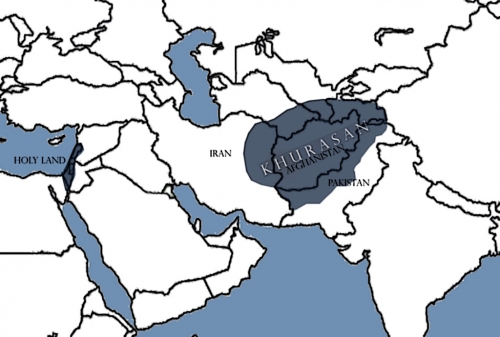
L'ISKH offre également aux partisans d'Asie centrale l'opportunité de prendre les armes contre les Talibans, accusés d'être une organisation centrée sur les Pachtounes qui opprime et recourt même à la violence contre les ethnies tadjik et ouzbek. Pour attirer les sympathisants de ces communautés, la propagande de l'ISKH met de plus en plus l'accent sur les relations amicales des talibans avec les "régimes tyranniques" d'Asie centrale. Au contraire, le ISKH se présente comme un moyen de détruire les frontières étatiques arbitrairement délimitées de l'Asie centrale et de renverser les "tyrans" de la région, afin de hisser le drapeau noir et de conquérir la province de Maverannahr, adjacente à l'IS.
En général, l'ISU attire depuis longtemps des combattants étrangers d'Asie centrale. En 2015, la faction du Mouvement islamique d'Ouzbékistan (interdite en Russie) a été incorporée à l'État islamique lorsque le chef du groupe, Usman Ghazi, a juré allégeance au calife de l'époque, Abu Bakr al-Baghdadi.
L'Asie centrale a également été utilisée comme point de transit par les recrues d'ISIS pour atteindre l'Afghanistan. À l'automne 2021, un citoyen britannique et un autre Européen ont été arrêtés par les talibans suite à un tuyau fourni par le gouvernement ouzbek. Les deux suspects étaient en possession de plus de 10.000 GBP en espèces, de lunettes de vision nocturne et d'uniformes militaires. Deux ressortissants français auraient traversé l'Asie centrale il y a plusieurs années pour rejoindre IS en Afghanistan et un autre a été capturé par les autorités tadjikes en 2017.
* * *
Ces faits indiquent une menace croissante pour les pays de la région d'Asie centrale et du Sud. Par conséquent, il est nécessaire de consolider les services spéciaux des pays de la région pour les activités opérationnelles et de contre-propagande. Ce dernier point est important car Al-Azaim produit déjà des documents en pachtoun, dari, arabe, ourdou, farsi, ouzbek, tadjik, hindi, malayalam, russe, anglais et parfois ouïghour. En outre, Al-Azaim utilise diverses plateformes telles que Telegram, Facebook, TikTok, Hoop, Element, Archive.org et bien d'autres. Elle est également devenue une organisation qui fournit des documents dans la plupart des langues à la Fondation Ilam, une plateforme d'archivage et de traduction de l'État islamique en pleine expansion, dotée d'adresses Web de surface et disponible sur le Dark Web. Des groupes pro-ISKH tels que Al-Fursan Media ont également contribué à la diversification linguistique, en utilisant le crowdsourcing pour recruter des volontaires pour traduire des documents en baloutche, en talysh et en turkmène.
16:20 Publié dans Actualité | Lien permanent | Commentaires (0) | Tags : fondamentalisme islamique, khorasan, isis, asie centrale, afghanistan, pakistan, iran, inde, asie, affaires asiatiques, politique internationale |  |
|  del.icio.us |
del.icio.us |  |
|  Digg |
Digg | ![]() Facebook
Facebook
lundi, 19 septembre 2022
Le monde multipolaire esquissé par Xi, Poutine et Modi à Samarkand
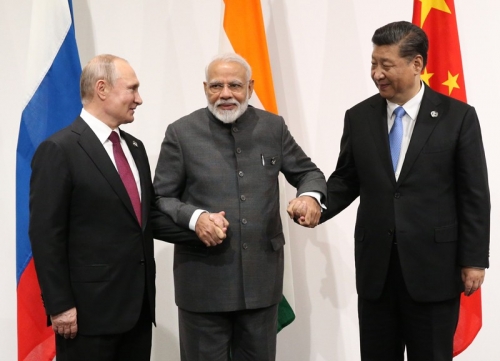
Le monde multipolaire esquissé par Xi, Poutine et Modi à Samarkand
Source: https://piccolenote.ilgiornale.it/mondo/il-mondo-multipolare-delineato-da-xi-putin-e-modi-a-samarcanda
L'assemblée de l'Organisation de coopération de Shanghai (OCS) à Samarkand, en Ouzbékistan, a fait la une des journaux en raison de la rencontre entre Poutine et Xi Jinping, duo désormais identifié comme l'actuel axe du mal (avec différentes modulations).
Et il a été dit que Poutine a subi un nouveau camouflet à cette occasion, car il n'a pas bénéficié du soutien inconditionnel du président chinois, qui le condamnerait même à un abandon imminent du pouvoir.
Poutine - Xi : simul stabunt simul cadent
Cela fait partie de l'art de la guerre de présenter les adversaires comme des perdants et cette technique a été adoptée avec beaucoup d'effet dans la guerre d'Ukraine. Il suffit de penser à l'époque où, au début du conflit, tous les médias parlaient de la prétendue maladie incurable du tsar, ce qui a été démenti, mais seulement quelques mois plus tard, par le chef de la CIA.
Pourtant, malgré tout, il n'est pas courant de transformer ses espoirs en nouvelles certaines, comme c'est le cas ici. Mais, pour en revenir aux faits, il faut répéter que Xi et Poutine ont désormais un lien indissoluble, grâce aussi à la politique étrangère américaine qui les a longtemps mis tous les deux dans le collimateur, favorisant ainsi leur proximité, sachant bien que simul stabunt simul cadent.
À tel point que les deux présidents ont désormais modelé un horizon commun : renforcer l'élan vers un monde multipolaire, sortant ainsi de la sphère étroite de l'unipolarisme actuel, né après 1989 et alimenté par des guerres sans fin, qui soumet la planète à l'hégémonie et aux caprices cruels des États-Unis. Un horizon ouvertement déclaré même à Samarkand.

Pour donner une idée plastique de la proximité entre les deux pays, il y a eu aussi l'exercice conjoint des marines respectives dans le Pacifique, commencé, sous l'œil attentif de Poutine, dans la semaine précédant le sommet et poursuivi pendant la réunion de Samarcande.
L'Inde à l'OCS dans un monde polarisé par le conflit ukrainien
Mais, au-delà des relations entre la Chine et la Russie, il convient de souligner certains aspects de cette rencontre d'une certaine pertinence.
Tout d'abord, il s'agit certainement de la réunion la plus importante depuis sa création, comme en témoigne le fait que Xi y a assisté en personne, quittant son pays pour la première fois depuis le début de la pandémie.
Il convient également de noter que la présence de Narendra Modi est apparue plus importante à cette occasion qu'aux précédentes, précisément parce que la guerre d'Ukraine, qui polarise le monde, semble indiquer que la présence du président indien constitue une sorte de choix de camp.
Pas tant un choix pro-russe, mais un choix décisif - et on pourrait dire inébranlable (à moins d'une révolution de couleur à l'indienne) - en faveur de la perspective multipolaire soutenue par la Chine et la Russie.
Pas seulement : la présence indienne renforce cet apaisement avec la Chine qui avait déjà été mis en évidence avec le terme mis aux escarmouches entre les deux pays à la frontière himalayenne, qui avaient fait des dizaines de victimes des deux côtés. Un apaisement dans lequel les deux géants asiatiques acceptent de contenir leur rivalité - fondée sur le chevauchement de leurs projections géopolitiques respectives en Asie - afin de travailler ensemble sur la perspective multipolaire.
La relation entre l'Inde et la Chine est une question géostratégique cruciale pour le destin du monde, comme le montre la prudence avec laquelle l'Occident aborde les démentis de l'Inde à ses diktats sur l'Ukraine et autres, l'Amérique ne peut tout simplement pas risquer d'effilocher ses relations avec New Delhi, car cela jetterait les Indiens dans les bras de la Chine, ce qui ouvrirait la voie au "siècle asiatique", au détriment de l'hégémonie mondiale américaine/occidentale.
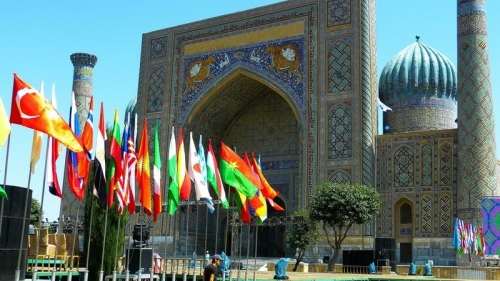
L'équidistance de la Russie par rapport aux grands rivaux asiatiques est également propice à l'apaisement, ce qui lui a permis de jouer un rôle de médiateur lorsque des problèmes sont survenus entre les deux pays (ce qui explique également le détachement apparent entre Xi et Poutine, qui est fonctionnel dans une perspective plus large).
La portée de l'OCS et l'Iran
Un autre point à souligner est la portée de l'OCS, qui, dans les médias grand public, est normalement abordée comme un organe géopolitique de faible importance mondiale.
Les différents participants donnent pourtant une idée de sa portée. Ses membres sont l'Inde, le Kazakhstan, le Kirghizstan, la Chine, la Russie, le Tadjikistan, le Pakistan et l'Ouzbékistan. Les États observateurs sont l'Afghanistan, le Belarus, l'Iran et la Mongolie, les partenaires de dialogue sont l'Azerbaïdjan, l'Arménie, le Cambodge, le Népal, la Turquie et le Sri Lanka. Et lors du sommet de 2021, la procédure a également été lancée pour accorder le statut de partenaire de dialogue à l'Égypte, au Qatar et à l'Arabie saoudite...
Un autre aspect important du sommet de Samarkand a été la signature de l'adhésion officielle de l'Iran à l'OCS, une nouvelle qui a fait le tour du monde, comme s'il s'agissait de quelque chose de sensationnel, alors qu'il ne s'agissait que d'une étape formelle, puisqu'en fait Téhéran était déjà un participant à part entière.
Téhéran avait jusqu'à présent évité cette étape, craignant qu'elle ne donne en quelque sorte à ses adversaires américains matière à renforcer leur pression contre le rétablissement de l'accord sur le nucléaire iranien. Maintenant que les États-Unis ont clairement fait savoir qu'une telle mesure n'est plus à l'ordre du jour, ils ont fait ce qu'ils voulaient faire depuis longtemps (nous reviendrons sur l'échec de la signature de l'accord nucléaire dans une autre note).
L'OCS et la détente dans l'espace post-soviétique
Aucune importance n'a cependant été accordée à trois aspects tout à fait positifs du sommet. Tout d'abord, au cours de la réunion, le Kirghizistan et le Tadjikistan ont convenu de mettre un terme aux désaccords qui avaient provoqué certains affrontements frontaliers entre les deux pays.
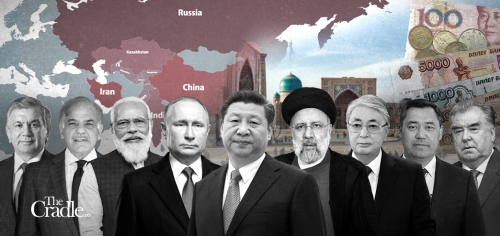
La seconde est qu'avant le sommet, l'Arménie et l'Azerbaïdjan ont trouvé le moyen de mettre fin aux affrontements entre les deux pays, notamment parce qu'Erdogan, qui soutient la position de l'Azerbaïdjan, ne pouvait pas venir à la réunion, où Poutine était présent, avec ce conflit non résolu, le Tsar étant irrité par la déstabilisation qu'il produit aux frontières de son pays (ce dont se réjouissent, en revanche, les néoconservateurs américains, comme l'écrit Responsible Statecraft et comme le souligne l'annonce par Pelosi de son prochain voyage dans la région, la présidente de la Chambre étant un vecteur délirant dans la propagation de conflits).
Le dernier aspect important du sommet concerne toujours Erdogan, qui, avant de partir pour Samarkand, avait exprimé son souhait de rencontrer Assad, si le président syrien se rendait à l'assemblée, ce qu'il n'a pu faire pour des raisons de sécurité.
Ceci a été rapporté par Reuters dans une note d'agence reprise par Haaretz, qui conclut de manière significative: "Toute forme de normalisation entre Ankara et Damas remodèlerait la guerre de Syrie qui dure depuis des décennies".
En effet, la Turquie a été l'un des parrains du changement de régime en Syrie et a été utilisée comme plaque tournante par des puissances étrangères qui l'ont alimenté en envoyant des miliciens, des armes et de l'argent par son territoire (un peu comme ce qui se passe en Ukraine, où les plaques tournantes sont plus dispersées et sous le contrôle total de l'OTAN).
La Russie et le dégel syrien
Mais à Samarkand, Erdogan a apparemment réitéré son intention, disant même qu'il était prêt à se rendre en Syrie pour rencontrer Assad. Et ce serait un coup fatal pour les partisans des guerres sans fin, qui ont rencontré leur premier échec en Syrie, après leurs succès en Libye et en Irak, Assad ayant survécu à l'assaut.
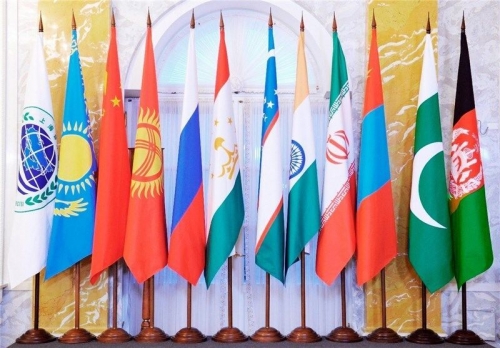
Ce qui est encore plus significatif, c'est ce qui est rapporté ailleurs dans la note, qui donne une idée de la façon dont une telle perspective n'est en aucun cas aléatoire : "Le rapport [sur l'intention d'Erdogan] a été publié après que quatre sources différentes ont déclaré à Reuters que le chef des services de renseignement turcs avait eu plusieurs réunions avec son homologue syrien à Damas ces dernières semaines, un signe des efforts russes pour encourager un dégel entre les États qui se sont opposés dans la guerre en Syrie".
Un tel dégel ne serait pas de trop pour le peuple syrien, qui souffre encore des conséquences de la dévastation et des deuils causés par la guerre et par les sanctions occidentales, qui pèsent encore tragiquement et de manière tout à fait arbitraire sur lui.
Malheureusement, beaucoup (qui sont puissants) de ceux qui s'arrachent aujourd'hui les cheveux pour le salut de la pauvre Ukraine ont participé - et participent - à la légion étrangère qui a alimenté la boucherie syrienne. Et ils feront tout pour empêcher le dégel susmentionné. Nihil sub sole novum.
Ps. Alors que le Kazakhstan accueillait l'assemblée de l'OCS, le pape François se trouvait également dans ce pays asiatique, en visite apostolique. Une simple coïncidence dans le temps, bien sûr, mais qui suscite autant de curiosité que d'intérêt.
18:52 Publié dans Actualité, Eurasisme, Géopolitique | Lien permanent | Commentaires (0) | Tags : ocs, eurasie, asie, affaires asiatiques, inde, russie, chine, politique internationale, géopolitique |  |
|  del.icio.us |
del.icio.us |  |
|  Digg |
Digg | ![]() Facebook
Facebook
jeudi, 15 septembre 2022
L'espace instable entre l'ancien et le nouvel ordre

L'espace instable entre l'ancien et le nouvel ordre
Markku Siira
Source: https://markkusiira.com/2022/09/13/vanhan-ja-uuden-jarjestyksen-epavakaa-valitila/
Selon le diplomate et universitaire indien Shivshankar Menon, "une sorte d'anarchie se glisse dans les relations internationales" - non pas l'anarchie au sens strict du terme, mais plutôt "l'absence d'un principe central d'organisation ou d'un hégémon".
"Les États-Unis ont mené deux ordres après la Seconde Guerre mondiale", divise Menon (photo). Premièrement, "un ordre keynésien qui ne s'intéressait pas particulièrement à la manière dont les États géraient leurs affaires internes dans un monde bipolaire de guerre froide".
Dans les années 1990, c'était le tour de "l'ordre néolibéral dans un monde unipolaire", dans lequel une Amérique puissante ignorait complètement la souveraineté nationale et les frontières nationales des autres États quand elle le voulait.
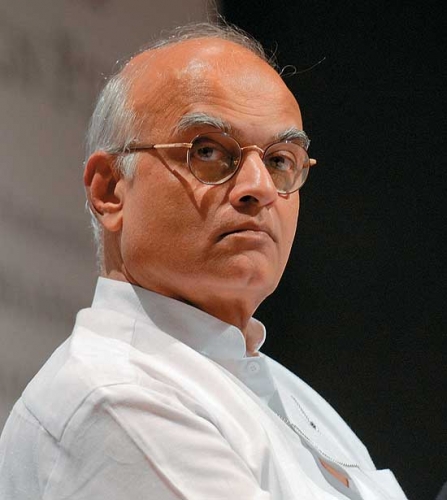

Les deux ordres ont affirmé être "ouverts, fondés sur des règles et libéraux" et ont prétendu "défendre la démocratie", les soi-disant "valeurs du libre marché, les droits de l'homme et l'État de droit".
En réalité, ils étaient fondés sur la "domination et la coercition militaires, politiques et économiques" des États-Unis. Dans l'ère post-soviétique, la plupart des grandes puissances, y compris la Chine émergente, ont suivi, du moins dans une certaine mesure, les règles truquées de l'ordre dirigé par l'Occident.
Mais les événements de ces dernières années laissent penser que cet arrangement appartient au passé. Les grandes puissances, y compris les États-Unis, se comportent désormais, selon Menon, de manière "révisionniste", c'est-à-dire qu'elles poursuivent leurs propres objectifs au détriment de l'ordre international.
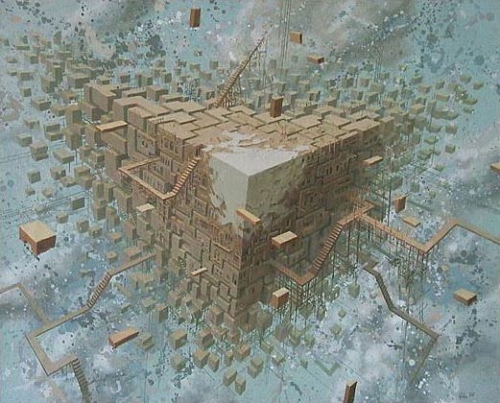
Ce révisionnisme se manifeste souvent par des différends territoriaux, comme ceux qui opposent la Chine à ses voisins, l'Inde, le Japon, le Vietnam et d'autres pays de la région maritime asiatique, et le conflit entre la Russie et l'Ukraine, qui est renforcée par l'alliance de l'OTAN.
Selon Menon, le révisionnisme se reflète également dans les actions de nombreuses autres puissances, "comme la suspicion croissante à l'égard du libre-échange aux États-Unis, le renforcement militaire d'un Japon autrefois pacifiste et le réarmement de l'Allemagne".
De nombreux pays sont mécontents du monde tel qu'ils le voient et cherchent à le changer à leur avantage. Cette tendance pourrait conduire à une géopolitique plus conflictuelle et à des perspectives économiques mondiales plus faibles.
Menon estime qu'à l'heure actuelle, "le monde est à la dérive". Dans l'espace instable actuel entre l'ancien et le nouvel ordre, les grandes puissances n'adhèrent plus à des principes et des normes clairs (on peut se demander si elles l'ont jamais fait).
De nombreux autres pays suivent leur propre voie. Le "principe de la souveraineté des États" est désormais invoqué pour mener une politique fondée sur la préférence des États, plutôt que la politique "fondée sur les valeurs" mise en avant par l'Occident (qui est, après tout, très fausse).
Ces dernières années, les États-Unis ont cultivé la rhétorique trompeuse selon laquelle le monde serait à nouveau défini par une confrontation entre deux blocs - le "monde libre" dirigé par l'Occident et les "États autocratiques". Les États soumis aux sanctions occidentales ont formé des partenariats stratégiques entre eux.
Alors que les anciennes normes et institutions s'érodent, des caractéristiques autoritaires sont déjà évidentes dans de nombreuses démocraties. Cette tendance s'est accélérée à l'époque de la pandémie, lorsque des restrictions à la libre circulation des personnes ont été imposées en raison de la crise sanitaire. "Les lois et règlements élaborés dans les circonstances exceptionnelles de la 'nouvelle normalité' permettent de renforcer le contrôle de l'État à l'avenir.
L'économie mondiale globalisée se fragmente en blocs commerciaux régionaux et la concurrence pour les avantages économiques et politiques entre les grandes puissances s'intensifie. Les pays doivent apprendre à se débrouiller dans cet entre-deux et se préparer à un avenir incertain.
"Une solution consiste à se tourner vers l'intérieur", analyse Menon. La Chine, l'Inde, les États-Unis et bien d'autres pays l'ont fait ces dernières années, en soulignant d'une manière ou d'une autre leur autosuffisance: la "stratégie de double circulation" de la Chine, la promesse de M. Biden de "reconstruire en mieux" et l'engagement de l'Inde, sous la direction du Premier ministre Narendra Modi, en faveur de l'aatmanirbharta, ou autosuffisance, en sont des exemples.
Si les pays veulent devenir plus indépendants économiquement, ils veulent aussi être mieux préparés militairement. Toutes les grandes puissances ont cherché à étendre leurs capacités de défense. Malgré les conséquences économiques de l'ère pandémique, les dépenses mondiales de défense ont dépassé les deux mille milliards de dollars pour la première fois en 2021.
Selon un professeur indien, une autre réponse à la situation actuelle est que les États forment des "coalitions ad hoc". La dernière décennie a vu l'émergence d'un certain nombre d'arrangements multilatéraux, tels que la Quad Alliance, les BRICS, l'Organisation de coopération de Shanghai et le regroupement I2U2 de l'Inde, d'Israël, des Émirats arabes unis et des États-Unis.

Chaque problème semble donner lieu à un nouvel acronyme. Ces arrangements servent des objectifs géopolitiques spécifiques et, bien qu'ils puissent contribuer à renforcer les relations bilatérales entre certains pays, ils ne se rapprochent pas des groupements de l'époque de la guerre froide.
De nombreux États de taille moyenne ou plus petite franchissent inévitablement les lignes de démarcation et cherchent à équilibrer leurs relations avec les grandes puissances. La réaction de l'alliance des pays d'Asie du Sud-Est (ASEAN) aux différends entre les États-Unis et la Chine et le développement des relations entre Israël et les monarchies sunnites du Golfe par le biais des "pactes abrahamiques" sont des exemples de cette tendance.
Plus récemment, de nombreux pays d'Afrique, d'Asie et d'Amérique latine ayant des liens étroits avec l'Occident ont résisté à l'envie de rejoindre le front des sanctions anti-russes, alors que le conflit gelé en Ukraine se réchauffait à nouveau. Ces pays ne manifestent pas automatiquement de la sympathie pour le jargon cynique sur les "valeurs" propagé par l'Occident.
Cet équilibrage et cette couverture encouragent la recherche de solutions locales aux problèmes locaux, qu'il s'agisse d'accords économiques et commerciaux régionaux ou de solutions négociées aux différends politiques. Le processus de mondialisation, qui estompe les frontières, est-il en train de se retourner contre nous ?
Si les grandes puissances remettent bruyamment en question la sagesse de l'ancien ordre, les pays plus faibles ont déjà perdu la foi en la légitimité et l'équité de "l'ordre international fondé sur des règles".
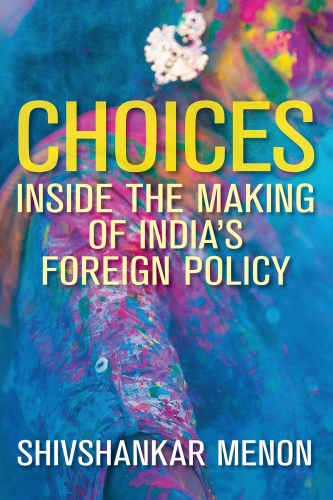
C'est particulièrement vrai pour les pays du Sud, qui ont vu l'ONU, le FMI, la Banque mondiale, l'OMC, le G20 et autres échouer dans leurs efforts. Aujourd'hui, plus de 53 pays sont menacés par une grave crise de la dette.
Alors que l'ancien ordre se désintègre et que le nouveau peine à émerger, le Prof. Menon estime que "les pays ayant une compréhension claire de l'équilibre des pouvoirs et une vision d'un ordre futur coopératif qui sert le bien commun auront un avantage".
Il est peu probable que l'équilibre des pouvoirs, qui évolue rapidement, fournisse la base d'un nouvel ordre stable avant un certain temps. Menon prévoit que les grandes puissances "se déplacent de crise en crise au fur et à mesure que leur insatisfaction à l'égard du système international et que la méfiance des unes à l'égard des autres grandit, comme une sorte de mouvement sans mouvement".
Le penseur indien est pessimiste quant à l'avenir. Menon note que "la capacité des grandes puissances s'est affaiblie en termes de gestion des relations étrangères, de gestion des crises, ou de capacité à résoudre les problèmes transnationaux".
Étant donné que les conclusions de Menon sont publiées dans Foreign Affairs, un journal du groupe de réflexion "Council on Foreign Relations" fondé par David Rockefeller, on peut se demander s'il ne suggère pas également que la solution réside dans une "gouvernance mondiale plus centralisée".
22:05 Publié dans Actualité, Théorie politique | Lien permanent | Commentaires (0) | Tags : actualité, politique internationale, instabilité, ordre mondial, shivshankra menon, inde, théorie politique, politologie, sciences politiques |  |
|  del.icio.us |
del.icio.us |  |
|  Digg |
Digg | ![]() Facebook
Facebook
mardi, 13 septembre 2022
L'Arthashastra de Kautilya : les origines orientales du réalisme politique

L'Arthashastra de Kautilya : les origines orientales du réalisme politique
Le réalisme, un héritage politique et un grand aperçu de la philosophie indienne
par Matteo Borgese
Source: https://aliseoeditoriale.it/arthashastra-kautilya-india-realismo-politico/
"Une flèche tirée par un archer peut tuer un homme ou ne pas le tuer du tout, mais l'intellect utilisé par un homme compétent peut tuer même un bébé dans le ventre de sa mère".
Cette phrase attribuée à Kautilya, le premier théoricien du réalisme politique, est la preuve concrète qu'un certain type de pensée peut être la plus efficace des stratégies pour la survie d'une nation. Le réalisme politique ou 'Realpolitik' peut être résumé comme la théorie de la philosophie politique selon laquelle le maintien concret du pouvoir est central.
Pour le réalisme, les questions morales, éthiques ou religieuses ne sont pas admissibles lorsqu'il s'agit de la théorie du gouvernement d'un peuple. La signification plus large de Realpolitik est aussi claire pour ceux qui s'intéressent à la géopolitique que l'évolution que ce terme a subie tout au long de l'histoire occidentale. Les noms de Kissinger et de Bismarck vous seront sans doute familiers, mais en remontant encore plus loin dans l'histoire du réalisme, nous pouvons rencontrer des figures tout aussi connues qui se distinguent comme des précurseurs de la Realpolitik : Machiavel, à la Renaissance, et Thucydide, dans la Grèce classique.
Bien que ces grands penseurs aient défini avec leurs idées les concepts qui constituent le réalisme politique et qu'ils aient joui d'une grande considération en Occident, il faut se tourner vers l'Asie du Sud pour retrouver les origines, au moins littéraires et documentées, du courant de pensée réaliste. Kautilya, également connu sous le nom de Chanakya ou Vishnugupta, est l'auteur de l'Arthashastra, terme sanskrit traduit par le philosophe et orientaliste G. Maggi par "Code du pouvoir", un traité composé entre le 4ème et le 2ème siècle avant J.-C. sur l'art du gouvernement, couvrant des sujets tels que l'économie, la guerre, la gestion des infrastructures, la politique étrangère et, au sens moderne des termes, le renseignement et la sécurité.
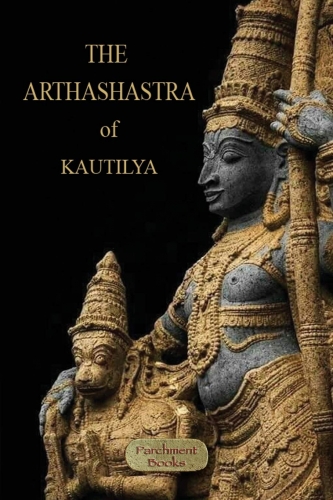
La figure de Kautilya et le contexte historique
Kautilya vivait dans le nord de l'Inde à la fin du 4ème siècle avant Jésus-Christ. Il a étudié dans l'une des plus anciennes universités du monde antique, dans la ville de Taxila, et est considéré comme un "faiseur de roi" car il a déposé la dynastie régnante de l'époque, les Nanda, et a fait couronner le jeune Chandragupta Maurya (statue, ci-dessous), dont il est devenu le mentor, sur le trône du royaume de Magadha, ouvrant ainsi l'ère de l'Empire Maurya. Kautilya devient le conseiller du souverain Maurya, jouissant d'une influence extraordinaire sur les décisions à prendre dans la gestion de l'État.
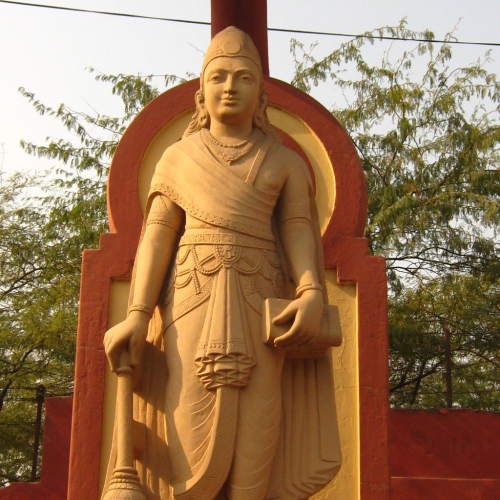
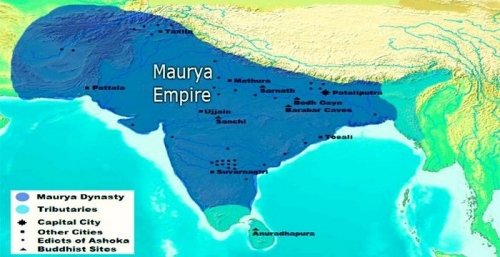
Ce fut le premier des empires pan-indiens, grâce aux directives de Kautilya; la domination de Chandragupta s'est étendue en très peu de temps de l'actuel Pakistan au Bangladesh, englobant tout le nord de l'Inde et une partie du sud de l'Inde. C'est dans ce contexte que le conseiller de l'empereur Maurya a pu écrire l'Arthashastra. L'empire de Chandragupta comptait une population de 50 à 60 millions d'habitants, soit environ 35 % de la population mondiale de l'époque, et pouvait se targuer d'une puissance militaire hors du commun. On estime que l'armée comptait plus de 600.000 soldats et près de 10.000 éléphants.
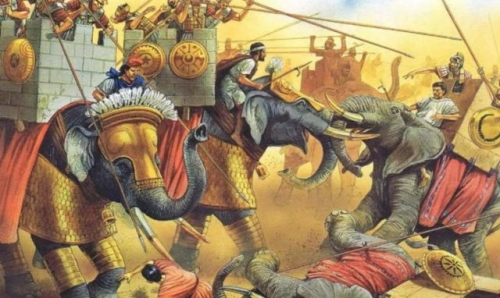
Ils formaient l'épine dorsale de la puissance militaire de Maurya, et notre vision de la guerre moderne ne doit pas nous conduire à sous-estimer l'importance de ces animaux en tant qu'arme de guerre, aussi cruciale à l'époque que la marine ou l'aviation peuvent l'être pour les forces armées contemporaines aujourd'hui. Bien conscient de la puissance politique et militaire de l'empire Maurya, Kautilya s'est montré astucieux pour façonner un modèle durable en proposant à son souverain un système de gouvernement qui ne se limite pas à la guerre mais qui est complet et conforme à une pensée réaliste concrète et sans préjugés.
L'Arthashastra, le contenu du "Code du pouvoir"
La pensée de Kautilya est finement condensée dans son œuvre la plus célèbre, l'Arthashastra. Le traité est en fait la première preuve littéraire de la Realpolitik, et je n'en veux pas au Chinois Sun Tzu, dont les maximes, bien que d'une immense valeur, prennent une saveur presque philosophique lorsqu'elles sont - parfois de force - étendues hors du contexte de la guerre. Le traité était déjà connu de nombreux intellectuels du vivant de Kautilya et est devenu une lecture obligatoire pour les souverains après l'ère Maurya. Pourtant, le texte a été perdu pendant de nombreux siècles pour n'être redécouvert qu'en 1904, et peut aujourd'hui à nouveau jouir de la renommée qu'il mérite grâce aux traductions modernes.
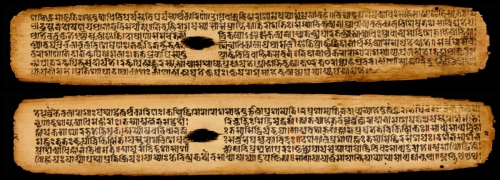
Pour se faire une idée de l'Arthashastra et de ses 15 chapitres, on pourrait comparer l'œuvre à un ouvrage qui a eu une résonance extraordinaire en Occident dans le domaine du réalisme, comme Le Prince du philosophe florentin Niccolò Machiavel, déjà mentionné. Selon Weber, cependant, malgré la crudité de la pensée machiavélique, l'œuvre du Florentin est même "inoffensive" en comparaison de l'Arthashastra. Kautilya est surprenant par la modernité de son regard analytique qui voit dans "conquérir ou être conquis" la seule règle dans les jeux de politique intérieure et extérieure du gouvernement.
Dans le traité, le penseur indien construit une série de situations dans lesquelles il est nécessaire de s'attaquer à des instruments considérés, surtout dans la société de l'époque, comme "déloyaux" : cela va de l'utilisation d'espions, principalement des femmes chargées des assassinats, mais aussi des enfants et des mendiants sous couverture, à la manipulation de l'opinion publique au moyen d'activités de propagande et à la création ciblée de la dissidence et du mécontentement à l'égard des ennemis politiques. Bien que le terme "renseignement" n'apparaisse jamais dans le traité dans son sens moderne, ces types de mesures détaillées par Kautilya peuvent être définies comme des mesures actives et couvrent des actions ante litteram.
Une importance considérable est accordée à la guerre en tant qu'instrument concret de résolution des conflits qui est presque nécessaire pour atteindre la paix et le bien-être de la nation. Selon Kautilya, il existe trois types de guerre : il y a la guerre ouverte, qui est à éviter car elle est imprévisible et coûteuse ; ensuite, il y a la guérilla, qui est préférable à la guerre ouverte malgré le fait que les forces de l'ennemi sur le terrain sont inférieures ; et enfin, il y a la guerre basée sur l'utilisation d'espions, d'assassins et de propagande, qui est bien plus efficace et moins chère que les types précédents. Il convient de souligner que Kautilya, selon certains historiens, a poussé le contrôle des citoyens à l'extrême en utilisant des espions de l'Empire et que Chandragupta était un souverain craint, plutôt qu'apprécié, en raison de cette surveillance oppressive.
Un quatrième type de guerre que Kautilya expose provient de la conception culturelle hindoue qui considère l'art de la diplomatie comme un instrument de guerre inestimable. Pour le philosophe indien, en effet, dans la conclusion de pactes et de traités, les intentions des gouvernants sont dissimulées et leurs actions futures peuvent être lues. Pour prendre un exemple moderne, on pense au pacte Molotov-Ribbentrop entre l'Allemagne nazie et la Russie soviétique, dans lequel il était facile de lire entre les lignes comment le pacte était plus adapté pour gagner du temps en vue d'une rupture future plutôt que de représenter un accord solide dans le temps entre deux puissances qui étaient à l'époque en conflit idéologique et politique avéré.
L'héritage de Kautilya dans l'Inde contemporaine
Les capacités d'analyse de Kautilya, bien que peu communes pour l'époque, ne doivent pas faire oublier le contexte culturel de l'époque et l'importance de certaines valeurs religieuses dans la société hindoue. L'Arthashastra est chargé d'une composante éthique et morale qui, à première vue, sans une connaissance de l'appareil culturel complexe issu de l'hindouisme - et du bouddhisme - pourrait heurter la teneur du réalisme extrême de l'œuvre. La philosophie et la religion hindoues apparaissent puissamment dans le texte lorsque l'on arrive à la conclusion que le but ultime de la guerre, malgré les moyens "injustes", est la paix et le bien-être des citoyens.
La vision hindoue de Kautilya, dynamique et conforme à la culture hindoue, admet que la nature de l'homme est de faire la guerre puisque toute action pour la survie de la nation est un acte guerrier, plus ou moins manifeste. Dans ce conflit perpétuel, le souverain doit profiter de ses réalisations, non pas de manière hédoniste, mais plutôt en façonnant la prospérité et en aspirant à une société meilleure pour ses sujets. Kautilya est également le père de la théorie du mandala, un concept applicable en politique étrangère qui est souvent résumé par un diagramme. La théorie part de l'hypothèse que deux États voisins, ayant donc des territoires voisins, sont ennemis par nature.
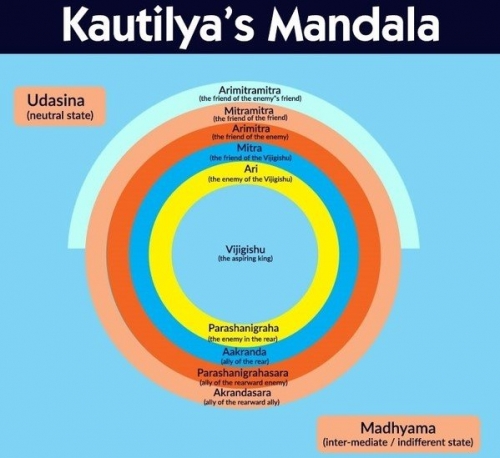
Ce concept est évoqué lorsqu'on cite le proverbe "l'ennemi de mon ennemi est mon ami", un aphorisme que l'on a cru pendant de nombreux siècles être d'origine arabe, mais qui trouve au contraire son origine et sa confirmation littéraire dans l'Arthashastra. La théorie du mandala est une évidence si l'on pense à la politique asiatique de ces dernières décennies. La menace pakistanaise a en effet poussé l'Inde à intensifier ses relations diplomatiques avec l'Afghanistan, tandis que la menace chinoise a poussé le pays vers le bloc occidental et dans QUAD, l'alliance quadrilatérale avec le Japon, l'Australie et les États-Unis. Dans cet échiquier où les cases voisines constituent une menace pour la sécurité nationale, on voit bien que l'amitié cultivée par Modi avec la Russie de Poutine est d'une importance capitale.
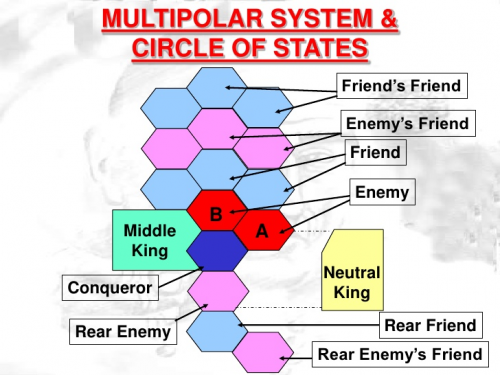
Inconnu des Occidentaux depuis des siècles, Kautilya a toujours été présent dans la culture indienne en tant que maître de la stratégie et du réalisme politique, au point qu'il est coutume de dire que "tout est Arthashastra en Inde". Son nom a été donné à une rue du centre de Delhi, où se trouve le siège des services de renseignement indiens, ce qui souligne encore l'héritage que cette figure a laissé à l'Inde contemporaine. La Realpolitik ne semble donc pas être quelque chose qui a influencé les dirigeants indiens au cours de l'histoire, mais apparaît plutôt comme un produit de la culture hindoue, de l'art de la gouvernance et de la pensée philosophique raffinée, facteurs liés par le besoin intemporel de survivre en tant que culture et nation.
Matteo Borgese
"Né à Rome en 1996. J'ai fréquenté un collège classique, puis j'ai continué sur la voie de la croissance et de l'étude des sciences humaines qui m'a rapproché de plus en plus de la philosophie orientale. Je m'intéresse au sous-continent indien et à tout ce qui a trait à la culture et à l'histoire indiennes, anciennes et contemporaines. Passionné par l'histoire des religions, le mysticisme et la relation entre l'homme et le divin dans sa globalité, j'essaie de discerner les échos des doctrines philosophiques anciennes dans la politique contemporaine".
22:02 Publié dans Philosophie, Théorie politique | Lien permanent | Commentaires (0) | Tags : inde, kautilya, arthashatra, philosophie, philosophie politique, realpolitik, réalisme politique, sciences politiques, politologie, théorie politique |  |
|  del.icio.us |
del.icio.us |  |
|  Digg |
Digg | ![]() Facebook
Facebook
mercredi, 07 septembre 2022
Alain Daniélou et le point de vue hindou sur le Kali-Yuga européen

Alain Daniélou et le point de vue hindou sur le Kali-Yuga européen
Nicolas Bonnal
Alain Daniélou, frère du cardinal, est païen et a vécu quinze ans en Inde au beau milieu du vingtième siècle. Là, il parfait sa connaissance de l’hindouisme, des textes sacrés, de la musique traditionnelle et de la danse initiatique. Puis il revient en Europe et assiste bien placé par ses relations mondaines au déploiement de cette Europe décadente dont a parlé Raymond Aron. Au début des années 80 il publie ses mémoires, Le Chemin du labyrinthe.
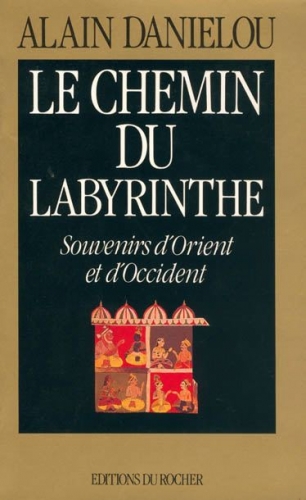
Le livre est fabuleux, à couper le souffle, totalement passionnant. Et il va appliquer sa connaissance de la Tradition, jointe à un remarquable esprit libertarien, cet esprit libre n’ayant jamais supporté la discipline occidentale, pour analyser ce qui se passe en Europe, qui, dès les années 60 et 70, court au Reset et à la dystopie.
« C’est armé de ce bagage que j’ai commencé à reprendre contact avec l’Europe qui m’est apparue comme une région malade, atteinte d’une sorte de cancer qui fait que certaines cellules se développent de façon incontrôlée et contaminent peu à peu les autres. Ce développement à forcement une limite. L’espace vital est de plus en plus réduit pour chacun dans ces énormes termitières qui recouvrent peu à peu les campagnes et les forêts. »
Le cancer de la civilisation et la fin de l’espace vital, nous y sommes. A l’époque on en parlait, aujourd’hui on applique. Daniélou évoque son toupet habituel les origines « aryennes » (violence et pillage) de ces occidentaux toujours en guerre et colonialistes :
« La recherche de la prospérité étouffe celle de la sagesse et du bonheur de vivre. Je me suis interrogé sur les raisons qui rendaient les Occidentaux modernes si agités et en somme assez rarement heureux. Les Aryens dont sont issus la plupart des peuples qui ont dominé l’Europe, les Achéens, les Doriens, les Celtes, les Romains, les Germains, les Russes, sont des peuples prédateurs. Ayant récemment envahi une grande partie de la planète, peuplé les Amériques et l’Australie, imposé leurs langues à l’Afrique et parfois même à l’Asie, ils ont atteint une limite et leur force d’expansion se retourne contre eux-mêmes. Il semble peu probable qu’ils arrivent à se contrôler. »
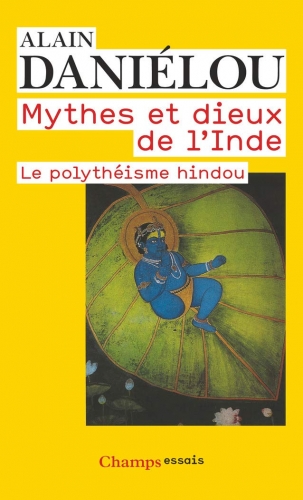
Oui, la force se retourne contre soi, et avec quelle alacrité !
Daniélou attaque l’occident là où il se croit fort, sur le plan des idées et de l’intellect ; il est aussi percutant que René Guénon :
« J’ai été surpris par l’incohérence des concepts, la naïveté des croyances, le manque de rigueur des raisonnements. De soi-disant « intellectuels » s’acharnent, sur des bases plus qu’incertaines, à changer le monde sans en étudier la logique ni en rechercher la raison d’être ; et prétendent « reformer » la société en partant de postulats irréalistes qui en tiennent aucun compte de la nature et du rôle de l’animal humain dans l’ensemble de la Création. »

Daniélou comprend comme Schopenhauer (voyez mon texte) que l’on ne peut convaincre en Occident. Alors il faut exterminer – surtout si on est le plus fort :
« Cette sorte de jeu artificiel ne peut aboutir qu’à de fausses valeurs imposées par des formes de tyrannie car, quand on arrive au bout du mensonge, on n’a plus d’autre issue que la destruction des preuves des opposants et l’annihilation physique de ceux qui les soutiennent ainsi que l’Histoire l’a trop souvent démontré. »
Il balaie la France fonctionnaire, républicaine et liquéfiée en une phrase :
« Les Français notamment apparus comme des gens particulièrement légers et irresponsables. »
La clé c’est la catastrophe bourgeoise. Taine en a très bien parlé dans son La Fontaine et les fables (voyez mon texte) ; Daniélou ajoute que le bourgeois est dangereux, surtout sur le plan culturel, car il est un snob. Cela donne les Femmes savantes, le bourgeois gentilhomme, la quête du mamamouchi et pas du Graal, ou le festival de Cannes et la sous-culture moderne qui repose sur la bêtise conformiste et le terrorisme critique :
«Le monde occidental, qu’il se prétende capitaliste ou socialiste, est entièrement dominé par la mentalité bourgeoise, c’est-à-dire par l’esprit qui caractérise la troisième caste, celle des marchands, non point tellement par suite de la puissance que donne l’argent que par l’importance attachée aux questions matérielles et surtout par le snobisme, un mot qui, selon certains, viendrait de l’italien snobile, « sans noblesse »
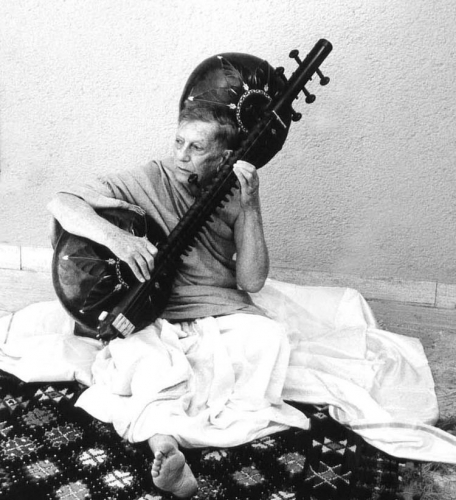
L’esprit libre et indépendant devient une rareté dans cet occident alors :
« Les esprits indépendants qui cherchent leur propre vérité, veulent vivre selon leurs goûts, sont suspects dans ce monde artificiel et prétentieux. Les snobes prônent les modes artistiques comme s’il s’agissait de valeurs incontestables. »
Daniélou insiste sur ce snobisme qui crée un déclin actif de l’art (visible par tous dès le dix-neuvième siècle, voyez Tolstoï ou Max Nordau) :
« Il semble qu’il n’existe plus de lien entre la cosmologie et la science, entre l’art et le sacré. Il y a des maladies et des idéologies à la mode alors qu’il s’agit de questions d’importance vitale. Le communisme de salon va de pair avec la musique aléatoire ou l’enthousiasme feint pour des toiles dépourvues d’intérêt esthétique, de talent ou même de technique. »
Et de conclure sur cette question :
« Les snobs sont des naïfs vaniteux aisément manipulés par les intérêts des puissances d’argent et des impérialismes. Les prétendus intellectuels font bien souvent partie de ce troupeau. »
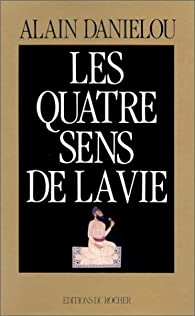 Le déclin de la science est évident aujourd’hui, sur fond d’épidémie, de la fin de l’énergie et d’arnaque spatiale (coucou Apollo ? Coucou Ariane ?) ; Daniélou ajoute :
Le déclin de la science est évident aujourd’hui, sur fond d’épidémie, de la fin de l’énergie et d’arnaque spatiale (coucou Apollo ? Coucou Ariane ?) ; Daniélou ajoute :
« Rares sont les savants qui au bout de leur carrière osent jeter, comme le faisait Oppenheimer, un regard effrayé sur le monde qu’ils ont contribué à construire tout en sachant qu’ils sont irresponsables, que la science collective poursuit son développement aveugle vers un destin inconnu que chacun pressent, qu’en théorie nul ne désire, et qui nous terrifie tous. »
L’abrutissement téléradio en une phrase :
« Un silence inquiétant est tombé sur les hommes saturés du bruit des radios et des images publicitaires de la télévision. »
Daniélou pressent la liquidation au nom de la lutte contre le racisme de la diversité sur terre :
« Au lieu de permettre aux différentes races de coexister, on encourage un abâtardissement général comme une solution qui contredit en fait la notion d’égalité de base. Là encore, au lieu de contempler, d’admirer, d’essayer de comprendre d’œuvre divine dans sa multiplicité, on cherche à l’abolir. »
Enfin après ce bilan la solution ? Il n’y en a pas de solution :
« On m’a souvent demandé si je ne pourrais pas définir des lignes de conduite, une méthode, une « religion » qui pourrait sortir l’Occident de l’impasse ou du moins aider quelques-uns à se réaliser. Mais je ne suis ni un maître ni un prophète. Dans un monde qui court à sa perte, selon la théorie des cycles, il n’existe de salut qu’individuel. Nous approchons, selon la conception hindoue, de la fin de kali yuga, l’âge des conflits, qui doit finir par un cataclysme. »
Macron réélu impose à son lâche et débile "peuple nouveau" (son peuple prolétaire, dirait le grand roumain Vlaicu Ionescu) un totalitarisme énergétique sur fond d’effondrement intellectuel et moral. "L’homme libre au milieu des ruines" (Julius Evola) ne peut qu’espérer passer au milieu des gouttes notamment s’il développe, dirait Laborit, sa capacité de fuite et ses dons manuels. Daniélou surdoué prétendait pouvoir exercer 32 métiers dont celui d’horloger, de jardinier ou de mécanicien.
J’oubliais : sur les USA, il explique, qu’avant Roosevelt et la guerre, ce pays était un paradis avec des gens libres et de bonne humeur – noirs compris (ils constituaient une caste). Puis est venu l’empire et sa bureaucratie… On croirait lire du Rothbard. Comme je l’ai expliqué dans mon opus sur la comédie musicale cette nostalgie a créé un genre spécial : l’americana…
Sources :
Alain Daniélou – Le Chemin du labyrinthe, Robert Laffont, pp.321 -341 et 75.
Nicolas Bonnal – Chroniques sur la Fin de l’Histoire
https://www.dedefensa.org/article/max-nordau-et-lart-dege...
https://www.dedefensa.org/article/taine-et-le-cretinisme-...
https://www.dedefensa.org/article/leon-tolstoi-et-les-joy...
18:26 Publié dans Philosophie, Traditions | Lien permanent | Commentaires (1) | Tags : alain daniélou, tradition, traditionalisme, nicolas bonnal, inde, hindouïsme, kali yuga, déclin européen, déclin occidental, occident |  |
|  del.icio.us |
del.icio.us |  |
|  Digg |
Digg | ![]() Facebook
Facebook
mercredi, 17 août 2022
Inde contemporaine : identité postcoloniale
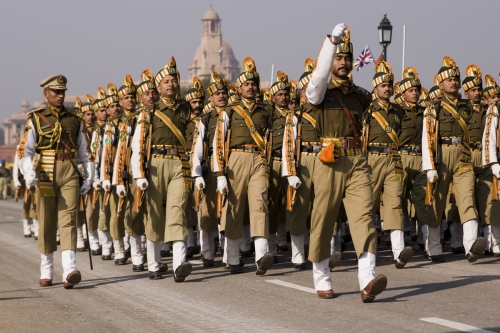
Inde contemporaine: identité postcoloniale
par l'équipe de Katehon.com
Source: https://www.geopolitika.ru/article/sovremennaya-indiya-postkolonialnaya-identichnost
La formation de l'Inde et du Pakistan
La phase post-coloniale de l'histoire de l'Inde commence le 15 août 1947, lorsque l'Inde a obtenu sa pleine indépendance de la domination britannique. Depuis lors, l'Inde est présente dans le monde en tant qu'État indépendant d'une manière qui, historiquement, n'avait jamais existé auparavant, ni en termes de forme politique, ni en termes de frontières, ni en termes de critère d'identité fondamentale. C'était une Inde entièrement nouvelle, qui clôturait l'ère de la modernisation coloniale et commençait celle de la modernisation nationale.
Les possessions britanniques en Inde et les territoires sous domination britannique jusqu'à la déclaration d'indépendance se sont retrouvés démembrés par l'administration britannique sortante en deux entités, l'Inde et le Pakistan, selon des critères religieux. Cependant, les indépendantistes nationaux eux-mêmes n'avaient pas, au départ, une position unifiée sur la partition ou l'unité - cela a fait l'objet de vifs débats, qui ont conduit à des affrontements sanglants entre hindous et musulmans lorsque la partition a commencé. Cela est principalement dû au fait que dans les deux États, l'Inde et le Pakistan, le modèle idéologique final est resté longtemps indéfini, et que tout dépendait de la situation spécifique dans laquelle les hindous et les musulmans pouvaient ou non trouver une solution commune. L'administration coloniale britannique était également complice de ce processus, cherchant à établir dans ses anciennes colonies un système sociopolitique qui lui permettrait de continuer à exercer une influence importante sur ces pays - en matière d'idéologie, de politique, d'économie, etc.
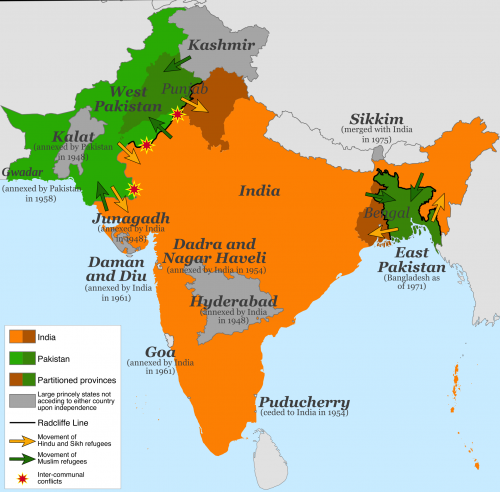
Ainsi, les États post-coloniaux suivants émergent dans le sous-continent indien - et plus largement, dans la zone, de la civilisation hindoue :
- L'Inde elle-même (avec la dominance religieuse de l'hindouisme, mais une importante minorité islamique - particulièrement massive et politiquement active dans l'État du Cachemire) ;
- Les États islamiques du Pakistan (avec des politiques strictement anti-indiennes) au nord et du Bangladesh (avec des politiques pro-indiennes) à l'est (qui était à l'origine une seule entité politique, le Pakistan occidental et oriental) ;
- Népal (où le bouddhisme domine) ;
- Sri Lanka.
La division en un État islamique et un État hindou, c'est-à-dire le Pakistan et l'Inde, s'est accompagnée de flambées de violence des deux côtés. Le Pakistan oriental, appelé plus tard Bangladesh, faisait partie du Bengale, artificiellement coupé de l'État indien ; les territoires du Jammu-et-Cachemire ainsi que du Pendjab avaient une population mixte, ce qui a conduit à des conflits territoriaux prolongés et à des actes de terreur récurrents. La division des territoires administratifs en territoires islamiques et hindous n'était pas stricte à l'époque de l'influence islamique maximale en Inde, ni pendant la période de colonisation britannique. Malgré toute la différence de religions, il s'agissait d'une population unique d'une civilisation commune, bien qu'avec des strates différentes. La division post-coloniale de l'Inde a représenté entorse à l'horizon indien, qui a été artificiellement et violemment démembré en plusieurs composantes. L'espace même de l'Inde pré-indépendance était polycentrique et multiethnique. Il y avait des zones dominées par l'une ou l'autre religion, des formes mixtes et intermédiaires ainsi que des enclaves de communautés archaïques ou d'entités mystico-religieuses originales. Cette polycentricité ainsi que les varnas et les jatas ont fait de l'Inde une mosaïque civilisationnelle, bien que la structure de cette mosaïque soit soumise à une logique civilisationnelle interne, largement manifestée par l'Historial indien.
Au moment de l'indépendance, ce processus subtil et naturel de dynamique civilisationnelle a été artificiellement interrompu et remplacé par le tracé rigide de plusieurs lignes de partage administratives, tracées très grossièrement et sans tenir compte de la structure indienne elle-même. Non seulement le Pakistan est devenu une création post-coloniale artificielle, mais l'Inde elle-même s'est conformée aux frontières conventionnelles sans continuité univoque avec les empires indiens du nord, les puissances islamiques ou les États du sud. Les dirigeants de l'Inde et du Pakistan ont été contraints de créer leurs nations dans des conditions totalement artificielles, en déplaçant de force d'énormes masses de population (étant donné la forte démographie de la société indienne), en procédant à des nettoyages ethniques, souvent accompagnés de violences et de bains de sang.
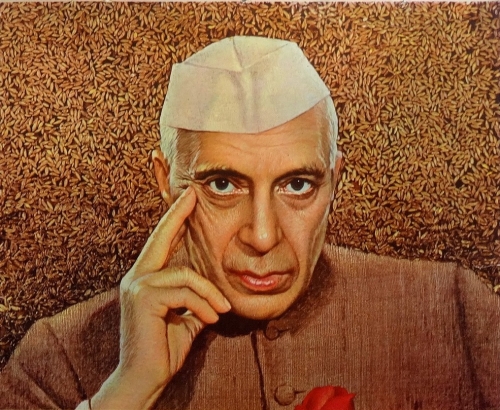
Indépendance et démocratie : Jawaharlal Nehru
Après la fin de la Seconde Guerre mondiale en 1946, des mutineries armées ont éclaté dans l'armée indienne et un mouvement de masse visant à expulser le contingent britannique et l'administration coloniale du pays a débuté. Simultanément, les frontières ethno-religieuses entre hindous et musulmans se polarisent, s'accompagnant d'un nettoyage ethnique et de pogroms dans de nombreuses villes et zones à la population traditionnellement mixte.
Lors des élections, le Congrès national indien remporte la majorité dans huit provinces, qui deviendront plus tard la base du nouvel État indien. Jawaharlal Nehru [1] (1889-1964) devient le premier Premier ministre de l'Inde. Il est le président du Congrès national indien et un proche associé et adepte de la cause de Gandhi. Nehru, contrairement à Gandhi, est né dans la Brahman varna, c'est-à-dire qu'il représentait la caste la plus élevée. Le père de Jawaharlal Nehru, Motilal Nehru (1861-1931), était également un participant actif de la lutte de libération nationale et le leader du Congrès national indien. Comme de nombreux leaders de la résistance indienne, Nehru a reçu son éducation en Angleterre. Dès sa jeunesse, il a accepté que Jawaharlal Nehru combatte les Britanniques, se retrouvant à plusieurs reprises en prison, où il a passé au total plus de dix ans.
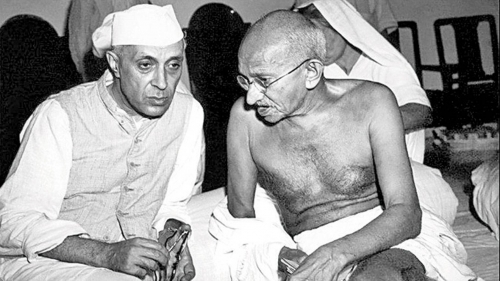
Au début de l'année 1947, l'Angleterre décide de se retirer définitivement du territoire de l'ancienne colonie, mais avant d'accorder l'indépendance aux Indiens, les Britanniques favorisent la partition du territoire entre les musulmans, représentés par Jinnah, qui s'unissent dans le dominion du Pakistan, qui comprend l'actuel Pakistan à l'ouest et le Bangladesh à l'est, et les hindous et les sikhs, qui forment la base de l'Inde moderne. Le 14 août 1947, l'État du Pakistan est proclamé et le 15 août 1947, l'État de l'Inde est déclaré.
Trois ans après sa création, l'Inde devient une république parlementaire totalement indépendante le 26 janvier 1950.
Jawaharlal Nehru a dirigé le pays dans la première phase et est resté à la tête du pays jusqu'en 1964.
Nehru adhère à des idées de gauche, en partie en sympathie avec le communisme et l'expérience soviétique (il se qualifie ouvertement et à plusieurs reprises de "socialiste") et en partie avec le système capitaliste de l'Ouest. C'est ainsi qu'il s'est retrouvé dans une position typique des pays qui ont créé le mouvement des non-alignés, dans lequel l'Inde a joué le rôle principal, avec la Yougoslavie de Josip Broz Tito (1892 -- 1980) et le mouvement panarabe sous la houlette de l'Egyptien Gamal Abdel Nasser (1918 - 1970).
En devenant indépendante, l'Inde a dû faire face à plusieurs défis géopolitiques :
- Problèmes avec le Pakistan au sujet du territoire contesté dans l'État du Jammu-et-Cachemire, qui compte une importante population islamique ;
- des différends territoriaux avec la Chine sur certaines parties du Tibet, que les deux pays revendiquent comme leur propriété ;
- plus tard, après la mort de Nehru, les relations avec les Sikhs, qui se sentent lésés par l'idéologie dominante de l'hindouisme et entreprennent de créer un État sikh séparé, le Khalistan, deviennent tendues ;
- parallèlement, le nationalisme et le séparatisme dravidien prenaient forme dans le sud de l'Inde, en particulier dans l'État du Mail Nadu.
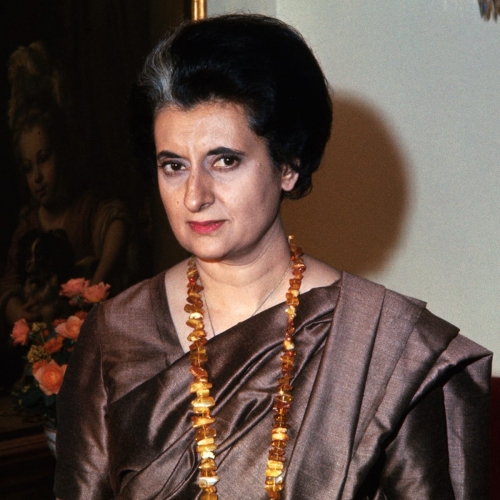
Indira Gandhi
Bien que la première guerre indo-pakistanaise ait éclaté sous Nehru entre 1947 et 1948, les guerres se sont poursuivies même après que la fille de Nehru, Indira Gandhi (1917 -1984), ait succédé à son père comme premier ministre de l'Inde. Puisque la mère d'Indira Ghani ainsi que son père appartenaient aux varnas brahmaniques, elle était à juste titre rattachée à ces varnas en termes d'hindouisme. Mais Indira Gandhi elle-même a épousé un politicien et écrivain zoroastrien (parsa), Feroz Gandhi (1912-1960) et a commis une erreur contre les coutumes de l'hindouisme. Ainsi, la progéniture d'Indira Gandhi et de Feroz Gandhi (les fils Rajiv et Sanjay) appartenait à la catégorie hors-caste des tchandalas, dalits, intouchables par la loi hindoue.
Indira Gandhi a été élue Premier ministre en 1966 après le décès de Lal Bahadur Shastri (1904 -1966), qui n'avait occupé ce poste que pendant deux ans. Sous Shastri, la deuxième guerre indo-pakistanaise a éclaté en 1965, avec des hostilités majeures au Cachemire et au Pendjab.
Indira Gandhi, comme Lala Bahadur Shastri qui a dirigé l'Inde avant elle, et même avant son père Jawaharlal Nehru, avait des opinions de gauche et poursuivait la ligne politique du Mouvement des non-alignés [2].
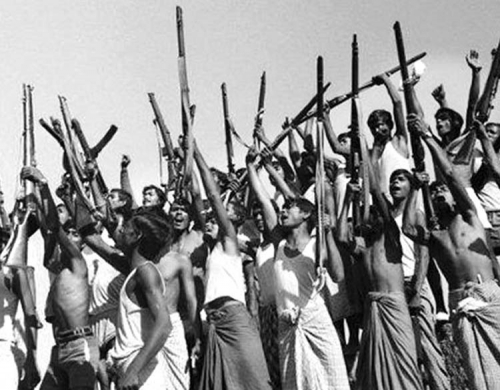
En 1971, une autre guerre indo-pakistanaise éclate sous Indira Gandhi, qui décide du sort du Pakistan oriental. La population du Pakistan oriental, qui n'avait pas de lien territorial direct avec le Pakistan occidental, se considérait comme un peuple distinct (principalement des Bengalis), qui éprouvait du ressentiment face à Islamabad (au Pakistan occidental) pour déni de droits et politiques visant à supprimer l'identité bengalie. Dans ce cas, le facteur islamique ne constituait pas une base assez solide pour maintenir un État unifié et, à bien des égards, une Inde hindoue mais généralement laïque semblait plus proche des habitants du Pakistan oriental. Le rejet par Islamabad de l'indépendance du Pakistan oriental a conduit à une guerre dans laquelle l'Inde, sous la direction d'Indira Gandhi, a pris le parti du Pakistan oriental.
L'armée pakistanaise a été la première à lancer une attaque de missiles sur l'Inde, visant la ville d'Agra. L'Inde a répondu par des frappes symétriques et a lancé une invasion du Pakistan oriental, défendant simultanément ses territoires à la frontière avec le Pakistan occidental.
En conséquence, les Indiens ont été victorieux, ce qui a entraîné la sécession du Pakistan oriental et son indépendance en tant que nouvel État indépendant, le Bangladesh. La guerre n'a duré que 13 jours. L'URSS a soutenu Indira Gandhi et la création de l'État indépendant du Bangladesh, avec Dhaka comme capitale. Dans le même temps, Moscou a garanti le soutien de l'Inde si la Chine et les États-Unis, qui s'étaient rangés du côté du Pakistan occidental, intervenaient dans la guerre. La victoire d'Indira Gandhi dans cette guerre a considérablement renforcé la position géopolitique de l'Inde, qui est devenue l'hégémon incontesté dans tout le sous-continent indien. Pour le Pakistan, il s'agit d'une défaite sévère, puisque le pays a perdu la moitié de sa marine, un quart de sa force aérienne et un tiers de son armée.
Néanmoins, un peu plus tard dans les années 1970, l'Inde est entrée dans une période de crise politique et Indira Gandhi s'est révélée être une dirigeante coriace en imposant une urgence nationale et en assumant des pouvoirs d'urgence (essentiellement dictatoriaux) face à des menaces croissantes. Au cours de cette période, elle a promulgué une loi de stérilisation forcée pour les hindous en raison du problème de la croissance démographique catastrophique et d'autres lois qui ont été rejetées par le public.
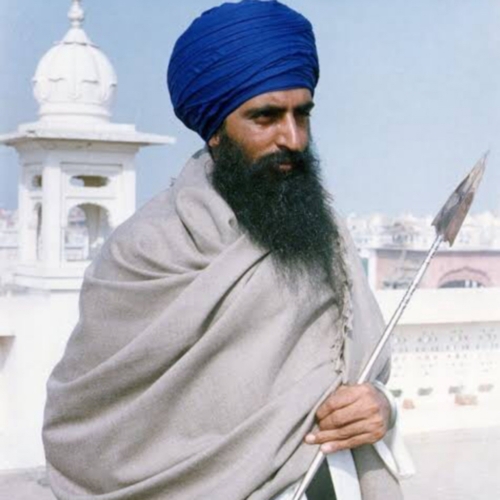
Par la suite, Indira Gandhi perd les élections, mais en 1980, elle redevient Premier ministre. Au cours de son deuxième mandat au pouvoir, il y a un conflit avec les Sikhs. Jarnail Singh Bindrawal (1947 - 1984) (photo), chef des Sikhs du mouvement politico-religieux Damdami Taksal, et du principal parti sikh, l'Akali Dal, a affronté les forces indiennes, s'emparant du sanctuaire le plus sacré des Sikhs, le Temple d'or (Darbar Sahid) à Armsar, au Pendjab, et y a établi un centre de défense militaire. Indira Gandhi a ordonné la prise d'assaut du sanctuaire, qui a fait un nombre important de victimes des deux côtés. Cela a tendu les relations entre les hindous et les sikhs et suscité le séparatisme sikh au Pendjab (avec un projet de création d'un État sikh séparé, le Khalistan): un problème aigu en Inde. L'opération menée par l'armée indienne pour écraser le soulèvement sikh a été appelée Opération Blue Star. Les Sikhs, vaincus dans la confrontation directe avec les troupes indiennes, ont répondu par une vague d'attaques terroristes et d'assassinats politiques. L'une des victimes était Indira Gandhi elle-même, tuée par des gardes du corps sikhs qui se vengeaient de l'assaut et de la profanation de leur sanctuaire, le Temple d'or.

Dans les années 70, un autre mouvement séparatiste, les Tigres de libération de l'Eelam tamoul, fondé par le nationaliste tamoul Velupillai Prabhakaran (1954-2009), s'est formé dans le sud de l'Inde, tout d'abord sur l'île de Sri Lanka. La mission des Tigres de libération de l'Eelam tamoul était de construire un État dravidien indépendant de l'Eelam au Sri Lanka et, plus largement, en Inde du Sud. Ce mouvement a entamé une lutte de guérilla s'appuyant sur des méthodes terroristes. Ainsi, l'Inde a été confrontée à trois types de terrorisme : par les musulmans, les sikhs et les dravidiens.
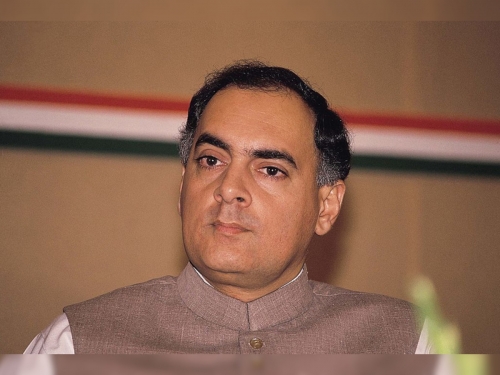
Après l'assassinat d'Indira Gandhi, son fils Rajiv Gandhi (1944-1991) (photo) a occupé le poste de premier ministre pendant quatre ans, entre 1984 et 1989. Son règne inclut le soulèvement sikh à Delhi et l'invasion des Maldives par l'armée indienne en réponse à un coup d'État dans lequel les séparatistes dravidiens des Tigres de libération de l'Eelam tamoul ont joué un rôle majeur. Rajiv Gandhi décide d'envoyer des troupes aux Maldives, ce qui fait échouer le coup d'État. Des mesures punitives contre les milices terroristes tamoules suivent.
En 1991, Rajiv Gandhi est assassiné par un terroriste tamoul pendant sa campagne pour le parlement. Après sa mort, la cause de la dynastie politique Nehru/Gandhi a été poursuivie par la veuve de Rajiv Gandhi, Sonia Gandhi, qui était d'origine italienne. À partir de la fin des années 1990, Sonia Gandhi devient le leader du Congrès national indien, alors confronté à la montée de l'opposition nationaliste de droite au Parti du peuple indien (Bhairati Janati Party).
La nouvelle génération de nationalistes en Inde
Le Parti du peuple indien (Bhairati Janati Party) a été fondé en 1980 par les politiciens conservateurs Atal Bihari Vajpayee et Lal Krishna Advani. Le nouveau parti était basé sur une alliance de nombreux groupes hindous nationalistes, collectivement appelés Sangh Parivar, dont le principal est le Rashtriya Swayamsevak Sangh [3]. De manière révélatrice, l'un des assassins du "Mahatma" Gandhi était membre de cette organisation, prônant à l'origine une Grande Inde ou un Empire indien, ce qui, selon ce courant, manquait à Gandhi. Ce mouvement était populaire parmi les Marathas les plus militants. L'un de ses représentants les plus éminents était le théoricien du nationalisme indien Madhav Sadashiv Golwalkar [4] (1906 -1973) (photo, ci-dessous).

L'Hindutva a joué un rôle central dans ce courant, mais parallèlement à son interprétation dans l'esprit du nationalisme européen, on pouvait également trouver des références au traditionalisme hindou intégral dans l'esprit de l'Advaito Vedanta et de la ligne Tilak.
Alors que le Congrès national indien gravitait traditionnellement vers le socialisme et le libéralisme, le Bhairati Janati Party nouvellement formé se concentrait principalement sur le nationalisme indien. Ses slogans reposaient sur l'idée de l'Hindutva - l'identité indienne - ainsi que sur le patriotisme, la souveraineté et la protection de l'État indien, qui étaient devenus particulièrement pertinents en raison de la montée des sentiments séparatistes. Étant donné que le mariage d'Indira Gandhi avec un Parsi la plaçait en dehors du système des varnas et que, par conséquent, son fils Rajiv et le reste de la dynastie politique étaient considérés comme des tchandalas (Dalits, intouchables), les nationalistes du parti Bhairati Janati ont transféré ces propriétés à l'ensemble du parti du Congrès national indien, l'accusant d'éroder et de perdre les fondements de la culture, de la civilisation et des traditions indiennes. La popularité croissante du Bhairati Janati Party a été alimentée par les scandales de corruption du parti du Congrès, longtemps au pouvoir en Inde, et par les tensions croissantes avec la population islamique, qui sont devenues particulièrement visibles à mesure que les idées salafistes et wahhabites propagées par l'Arabie saoudite et d'autres États arabes sunnites se sont répandues parmi les musulmans indiens.
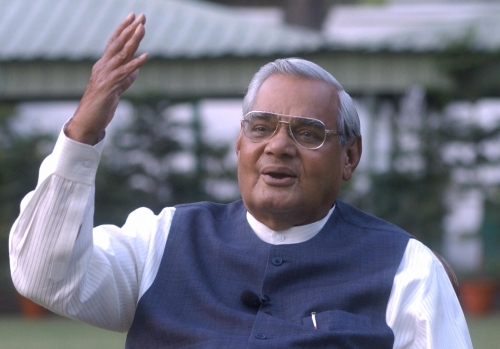
Le parti Bhairati Janati insistait précisément sur l'hindouisme religieux comme base de l'identité indienne, ce qui s'est parfois traduit par un harcèlement de la population musulmane. Néanmoins, le parti a remporté une majorité de sièges au parlement en 1996 et son fondateur Atala Bihari Vajpayee (photo) est devenu Premier ministre. Cependant, le parti n'occupe pas le poste, mais devient dès lors une force importante dans la politique indienne, participant à diverses coalitions et obtenant d'importants postes gouvernementaux.
Dans les années 1990, le Bhairati Janati Party avait un nouveau leader, Narendra Modi, qui est rapidement devenu chef de l'administration de l'État du Gujarat. Modi est issu du mouvement Rashtriya swayamsevak sangh et s'appuie sur le traditionalisme hindou. Progressivement, son rôle au sein du parti s'est accru et après que le parti ait remporté les élections parlementaires en 2014, il est devenu le premier ministre de l'Inde.
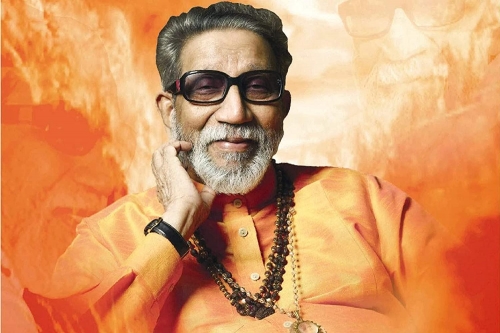

En alliance avec le Bhairati Janati Party se trouve l'organisation hindoue encore plus radicale Shiv Sena, [5] fondée par les marathas du scribe Kayastha Bal Keshav Thackeray (1926 - 2012) (photo, ci-dessus) en 1966. Les théoriciens du Shiv Sena combinent une identité indienne commune (Hindutva) dans sa version traditionaliste (avec un recours à l'Advaito Vedanta, aux varnas et au shivaïsme) avec un accent sur l'identité distincte des Marathas, d'où la grande influence dont jouit ce mouvement à Mumbai et dans l'État du Maharashtra en général.
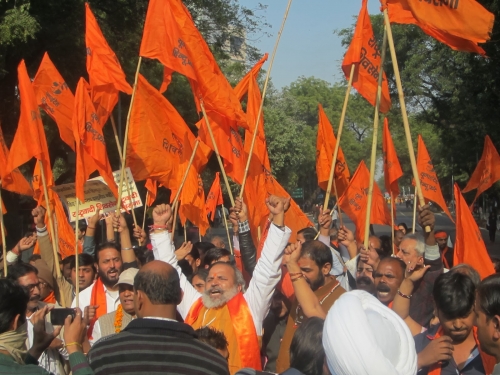
Les militants du Shiv Sena soulignent que ce sont les Marathas qui ont été les premiers à lancer des luttes armées contre les musulmans et pour la restauration de l'ordre hindou, et qui ont résisté farouchement à l'occupation britannique. Parfois, dans les textes du Shiv Sena, on peut trouver des appels à un État Maratha séparé. Après la mort du fondateur du Shiv Sena, Bala Keshav Thackeray, il a été dirigé par son fils Uddhav Thackeray.
De manière révélatrice, il existe également des partis nationalistes indiens dans des pays qui étaient autrefois sous l'influence de la Grande Inde. Parmi eux:
- Parti de l'éveil du Dharma indonésien (Partai Kebangkitan Dharma Indonesia) en Indonésie ;
- Les partis hindous de Banga Sena et Bangabhumi au Bangladesh ;
- Rashtriya Prajatantra Parti (Parti démocratique national) et Nepal Shiv Sena au Népal ;
- Parti de la réforme progressiste (Vooruitstrevende Hervormingspartij) au Suriname.
L'Islam radical en Inde
Examinons maintenant brièvement les tendances séparatistes en Inde que nous avons déjà mentionnées à plusieurs reprises. Eux aussi sont des versions du nationalisme, mais non pas intégrateur, comme dans le cas des différents courants de l'Hindutva, mais visant à diviser l'Inde en plusieurs États-nations.
Les musulmans représentent environ 14 % de la population indienne, et au Jammu-et-Cachemire, ils constituent la majorité de la population. La majorité des musulmans sont des sunnites du madhhab Hanafi, bien que les chiites, y compris les ismaéliens (les séminaristes chiites connus sous le nom de courants Bohra et Nizarite Khoja) constituent environ 30 % de la population islamique totale. Parmi les chiites, un courant extrême particulier, l'Ahmadiyya, a émergé au cours du XIXe siècle, dont le fondateur, Mirza Guam Ahmad (1835-1908) (photo, ci-dessous), né à Qadian, dans l'État du Pendjab, s'est déclaré le Mahdi. Bien que la plupart des chiites aient rejeté cette revendication, Ahmad a gagné de nombreux partisans, qui ont formé la base d'un nouveau mouvement religieux reconnu comme une dénomination indépendante dans l'Inde moderne.
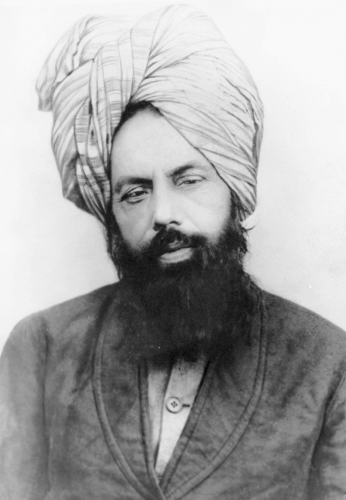
Les chiites sont beaucoup plus profondément et organiquement intégrés dans la société indienne. Parmi les sunnites, le soufisme (principalement la tarikat Chishtiyya) est très répandu et sert également de pont intellectuel et spirituel entre les deux traditions. Le chiisme et le soufisme constituent un bouclier important contre la pénétration du salafisme et du wahhabisme parmi les musulmans indiens, car les structures de l'islam zahirite sont l'exact opposé de celles de l'islam bati [6]. C'est l'islam bati qui prévaut en Inde, qui découle de l'histoire de la propagation de l'islam en Inde, où l'environnement culturel iranien de la Perse et de l'Asie centrale a été un élément médiateur.
Les sunnites en Inde appartiennent à deux branches - les Barelvi, dominés par l'interprétation traditionnelle du madhhab Hanafi et acceptant pleinement le soufisme, et les Deobandi, qui ont émergé au 19ème siècle avec le soutien du zahirisme et ont été fortement influencés par le wahhabisme. Le courant Barelvi est prédominant, bien que ces dernières années, sous l'influence de la propagande arabe, le courant Deobandi ait également gagné en influence.
Dans l'ensemble, les musulmans indiens se sont facilement intégrés à l'Inde moderne et après leur séparation du Pakistan, tandis que ceux qui préféraient une identité religieuse sont partis au Pakistan, des mouvements et des partis séparatistes islamiques sont apparus dans certaines régions et certains milieux sociaux, dans le but de faire sécession de l'Inde.
Les séparatistes islamiques en Inde peuvent être divisés en deux composantes :
- Les partisans d'une union avec le Pakistan (il s'agit principalement des partis islamiques de la population musulmane de l'État du Jammu-et-Cachemire, à majorité islamique, mais dont le principal territoire est contrôlé par l'Inde),
- Les partisans de la construction d'un État islamique (califat mondial) sur la base de l'idéologie salafiste, qui s'est activement répandue au cours des dernières décennies à partir de l'Arabie saoudite et a pris racine en Afghanistan et au Pakistan.
Les deux versions ont souvent recours à la pratique du terrorisme armé, qui constitue une menace sérieuse pour la sécurité de l'Inde.
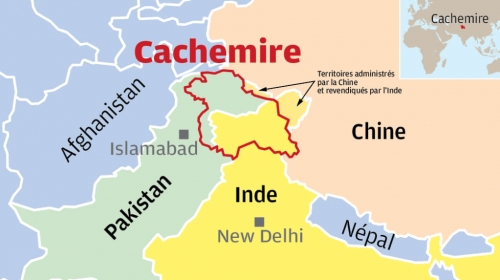
L'histoire du Jammu et du Cachemire est un cas à part. Dès l'époque de la domination britannique de l'Inde, le territoire du Cachemire a été envahi par des militants sikhs dirigés par Ranjit Singh (1780 -1839), le fondateur du premier État sikh au Pendjab. Plus tard, au cours de la première guerre anglo-sikh, l'État sikh a été divisé en deux parties - la partie occidentale (Lahore) est allée aux Britanniques, et la partie orientale est devenue une principauté du Jammu-et-Cachemire. Alors que la principauté était dirigée par des sikhs, la population principale était musulmane.
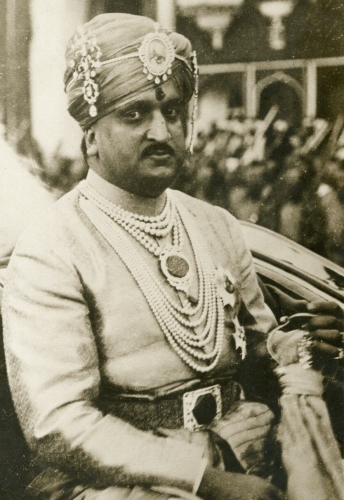
Au moment de la partition de l'Inde, le dernier souverain sikh du Jammu-et-Cachemire, Hari Singh (1895 - 1961) (photo, ci-dessus), a initialement déclaré l'indépendance à la fois face au Pakistan et face à l'Inde, mais par crainte d'être occupé par le Pakistan, qui bénéficiait d'un large soutien au sein de la population islamique de la principauté sikh, il a approché le gouvernement indien pour lui demander de rejoindre ce grand État. L'Inde introduit des troupes, ce qui provoque la première des trois guerres indo-pakistanaises. Les deux autres guerres, ainsi que la guerre de Kargil de 1999, ont également eu lieu pour la possession de ces terres.
Depuis lors, les sikhs, qui régnaient auparavant sur la région, n'ont pas joué un rôle décisif dans la politique, représentant l'une des minorités ethno-religieuses avec les bouddhistes, les chrétiens et les jaïns.
Les parties nord et ouest du Jammu-et-Cachemire sont tombées aux mains du Pakistan (Gilgit Baltistan), tandis que les régions du nord-est (Aksai Chin et la vallée de Shaksgam) sont passées sous la coupe de la Chine, qui les a occupées entre 1957 et 1963.
En 1987, des hostilités ont éclaté entre des séparatistes islamiques, mécontents des résultats des élections, et l'armée indienne dans la vallée du Cachemire, où la population musulmane est très majoritaire. Certains des rebelles ont appelé à l'unification avec le Pakistan, d'autres à l'indépendance et un troisième, déjà influencé par le salafisme réformiste, à l'établissement d'un État islamique. Les forces gouvernementales ont réussi à étouffer le soulèvement cette fois-ci.
Au début des années 1990, des affrontements entre musulmans et hindous ont également commencé à se produire dans l'État de Maharshartra, à Mumbai et en Uttar Pradesh. Par exemple, des hindous radicaux ont détruit la mosquée Babri à Ayodhya, le centre sacré de l'hindouisme, en 1993. En réponse, les extrémistes islamiques ont perpétré une série d'attentats à la bombe à Mumbai, la plus grande attaque terroriste avant l'attentat wahhabite contre le bâtiment du World Trade Centre à New York le 11 novembre 2001. Les enquêtes sur les attentats ont révélé que le syndicat du crime D-company, dirigé par Dawood Ibrahim, qui recevait à son tour des instructions au Pakistan et était lié aux organisations terroristes islamiques Al-Qaeda et Lashkar-e-Taiba d'Oussama ben Laden, a joué un rôle majeur dans leur organisation. Lashkari-Taiba, qui a son siège au Pakistan, proclame ouvertement la création d'un État islamique en Asie du Sud, la libération du Jammu-et-Cachemire de l'hindouisme et appelle à des actes terroristes. Lorsque la situation s'est aggravée au Jammu-et-Cachemire dans les années 1990, une grande partie des musulmans est passée sous l'influence de l'islamisme radical, ce qui a conduit à un nettoyage ethnique des hindous dans la vallée du Cachemire et à de nombreux actes de violence.
En 2001, des extrémistes islamiques ont attaqué le Parlement indien, et en 2008, de nouvelles attaques terroristes ont eu lieu à Mumbai. Le gouvernement indien a cité des preuves qu'à cette occasion également, le Lashkar-e-Taiba était l'organisateur de ces crimes, pointant directement du doigt le rôle du Pakistan.

Khalistan : le projet politique des Sikhs
Les Sikhs, comme nous l'avons vu, sont une religion syncrétique avec des éléments de l'islam et de l'hindouisme. Les adeptes les plus répandus du sikhisme se trouvent au Pendjab (la province du Pendjab au Pakistan et l'État du Pendjab en Inde) où un État sikh avec des centres à Armsitsar et Lahore existe depuis le début du 18ème siècle, qui a également régné sur les territoires du Jammu. En termes d'échelle, il pourrait bien être considéré comme un empire, car il englobait de vastes zones du Pakistan et de l'Inde actuels.
L'État sikh a été détruit par les Britanniques lors de la deuxième guerre anglo-sikh en 1849.
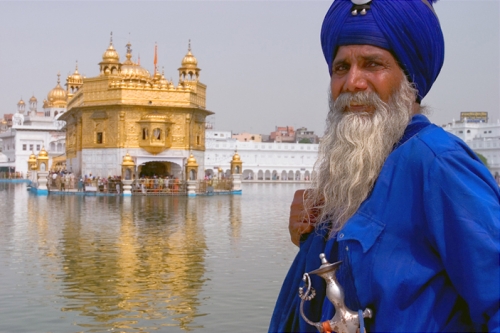
Le nombre total de sikhs dans le monde est de plus de 22.000.000. En Inde, ils vivent principalement dans les États du Punjab et d'Haraniya.
La communauté sikhe était à l'origine centrée sur dix grands gourous, à commencer par Nanak. Après la mort du dixième gourou Gobind Singh, le pouvoir est passé à la communauté, la Khalsa, qui devait être guidée par le "onzième gourou" -- selon les textes sacrés du sikhisme. Lors de l'établissement de l'Empire sikh, le pouvoir a été transféré du Khalsa et de ses assemblées régulières aux Serdars, qui étaient une classe d'aristocratie militaire.
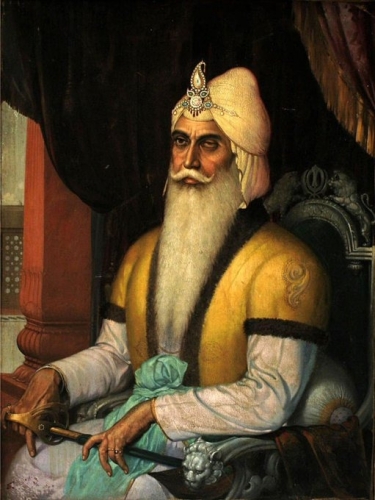
Pendant le règne de Ranjit Singh (tableau, ci-dessus), son statut parmi les autres chefs militaires des Serdars était similaire à celui de l'empereur, le roi. Mais après la chute de l'État aux mains des Britanniques, le centre du pouvoir était constitué par les Serdars individuels qui dirigeaient les possessions restantes après l'effondrement de l'Empire.
Les Sikhs ont cédé volontairement le pouvoir à l'Inde au Jammu et au Cachemire, et l'État du Pendjab, où ils constituaient un grand pourcentage de la population, fait également partie de l'Inde. Depuis les années 1970, cependant, la communauté sikh fait de plus en plus entendre ses intérêts politiques. Dans ce milieu, la théorie du séparatisme sikh devient populaire, culminant dans l'idée d'établir un État sikh indépendant, le Khalistān, centré au Pendjab, au siège historique de l'Empire sikh. L'idée a été évoquée pour la première fois par les Sikhs pendant la période de la domination coloniale britannique en 1920 avec la formation du parti politique Akali Dal, mais elle a été mise en avant pour la première fois en 1944 pour demander la création d'un État sikh. La thèse du Khalistan, littéralement "pays des purs", a été formulée par Jagjit Singh Chauhan (1929 - 2007), qui a proclamé un gouvernement du Khalistan en exil à Londres.
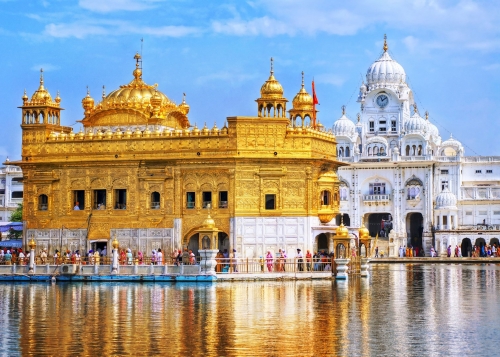
Amritsar, ou Amrita Saras, littéralement "océan d'amrita" ou d'immortalité, et fondée par le quatrième gourou sikh, Ram Das (1534-1581), en 1577, est considérée comme la capitale de cet état. Chauhan est ensuite retourné au Pendjab en Inde et a fondé le parti Khalsa Raj, appelant à la construction du Khalistan par des moyens pacifiques.
En 1984, des combattants indépendantistes sikhs, sous la direction de Bindrawal Singh, se sont emparés du principal temple sikh, le Temple d'or, Harmandir Sahib, et ont commencé à y préparer un soulèvement armé. Indira Gandhi décide alors de lancer l'opération Blue Star, au cours de laquelle le bastion sikh est pris d'assaut avec de l'artillerie et des chars. Cela a entraîné une forte hausse des sentiments séparatistes parmi les Sikhs ainsi que l'assassinat d'Indira Gandhi.
Petit à petit, cependant, le gouvernement indien est parvenu à atténuer cette opposition. Ainsi, pendant dix ans, le Premier ministre de l'Inde issu du Parti du Congrès national indien était un Sikh, Manmohan Singh.
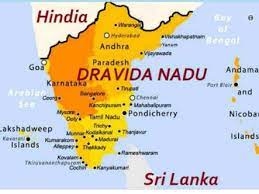
Dravida Nadu et l'Etat du Dev
Une autre forme de nationalisme séparatiste en Inde est basée sur l'identité dravidienne. Le fondateur du courant politique dravidien qui insistait sur leur identité était Erode Venkata Ramasamy (1879 - 1973) (portrait, ci-dessous), également connu sous le nom honorable de Periyar. Il était issu d'une caste spéciale de Balijas, considérée comme une branche des kshatriyas, qui se concentrait sur les activités commerciales (un analogue direct de la "thymocratie" de Platon).
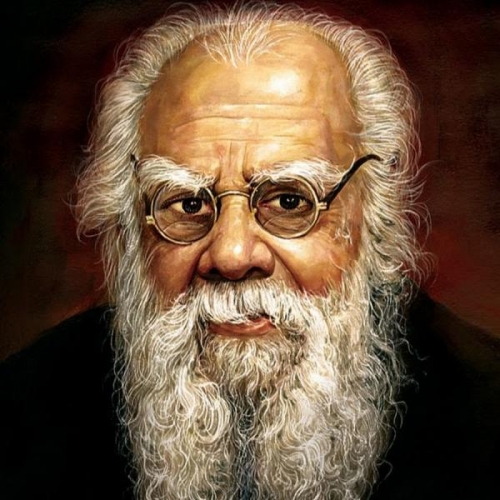
Au cours de la première phase de la lutte pour l'indépendance de l'Inde, Ramasamy a vivement critiqué le Congrès national indien en tant que "parti brahmane", qui, selon lui, ne cherchait l'indépendance que pour renforcer le pouvoir des "Aryens", c'est-à-dire des varnas supérieurs représentant les intérêts de l'"Aryvavarta", c'est-à-dire de l'Inde indo-européenne. Ramasamy a exigé une égalité totale pour les Dravidiens et les castes inférieures. À cette fin, il a créé le Parti de la justice, rebaptisé plus tard mouvement Dravidar Kazhagam. Les plans de Periyar Ramasamy comprenaient la création d'un état dravidien séparé - Dravidastan ou Dravida Nadu.
Periyar et son parti étaient actifs pendant l'occupation britannique, où ils formaient la majorité dans la présidence de Madras, et menaient la cause pour obtenir l'indépendance vis-à-vis d'eux après le retrait des Britanniques - comme au Pakistan musulman.
Periyar était un athée, considérant toutes les religions comme des constructions artificielles. Cependant, il partageait l'opinion selon laquelle les premiers porteurs de la culture védique et donc du système de varnas étaient des Indo-Européens venus du nord, mais considérait la situation depuis la position du sud de l'Inde, qu'il identifiait à l'ancienne culture dravidienne. Periyar a interprété l'épopée indienne Ramayana comme une preuve historique que les territoires de l'Inde du Sud étaient autrefois gouvernés par les Dravidiens eux-mêmes sous leur propre roi, déformé dans le Ramayana en tant qu'Asur Ravana, le principal adversaire de Rama.
Il est significatif que Periyar, ainsi que son prédécesseur, le politicien tamoul Iyoti Thass (1845 - 1914), le géniteur du mouvement tamoul, ait prôné l'égalité des droits pour les intouchables de la caste inférieure, que les Tamouls appelaient "pariyar". Iyoti Thas lui-même était un pariyar de naissance. Dans la théorie de Ramasamy et Thass, les Pariyars étaient la population originelle de l'Inde, subjuguée par les Aryas védiques et placée à un niveau inférieur. Ils ont donc appelé les Pariyas "adi dravida", c'est-à-dire "les premiers Dravidiens", "les Dravidiens originels". Les paryas tamouls étaient probablement à l'origine des joueurs de tambour (les instruments de percussion sont constamment associés dans la mythologie de différents peuples aux cultes de la Grande Mère); d'où l'affinité de leur nom avec le mot signifiant en tamoul "tambour" - paṟaiyar. Les pariyas vivaient en dehors des villages dans des établissements spéciaux éloignés. Ils étaient considérés comme de dangereux magiciens, mais dans les cours tamoules, ils étaient des musiciens et des magiciens qui transmettaient leur pouvoir aux monarques tamouls.
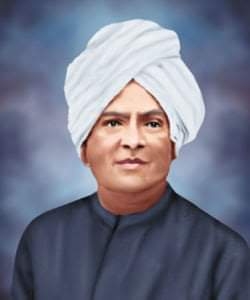
Selon Iyoti Thass (photo, ci-dessus), la religion originelle des parias tamouls était le bouddhisme. Nous avons vu qu'Ambedkar, le leader politique des Dalits, les intouchables, favorisait également cette religion particulière. Ces considérations nous renvoient à ce que nous avons dit sur l'opposition entre la tradition brahmanique et la tradition shramana, et le lien du bouddhisme originel spécifiquement avec le shramana.
Les idées de Periyar étaient partagées par son disciple, qui s'est ensuite éloigné de son professeur, le politicien dravidien Konjiwaram Natarajan Annadurai (1909 -1969), créateur du parti politique Dravida Munnetra Kazhagam. Il était le chef administratif de l'État du Tamil Nadu. Cependant, contrairement à Periyar, il était très strict sur l'idée d'une indépendance totale pour les Dravidiens, se limitant à respecter leurs droits et à développer la langue tamoule et la culture tamoule. Annadurai se considérait comme un "communiste" et ses opinions étaient proches de la faction de gauche du Congrès national indien, mais avec un accent particulier sur l'anti-brahmanisme et l'anti-aryanisme et le nationalisme tamoul par opposition au nationalisme de toute l'Inde.
À l'origine, le concept de Dravida Nadu ne comprenait que le territoire du Tamil Nadu et les zones où la population principale parlait la langue tamoule. Peu à peu, cette zone s'est étendue et les partisans du nationalisme dravidien ont inclus dans le territoire de l'État idéal (futur ?) des régions à population majoritairement dravidienne - les territoires de l'Andhra Pradesh, du Kerala et du Karnataka, ainsi que le Sri Lanka, certaines parties de l'Orissa et du Maharashtra.
Les théoriciens de cette école ont vu les origines de la doctrine du Dravida Nadu dans les légendes du pays de Kumari Kandam qui était situé sur un continent submergé dans l'océan Indien et dont le Sri Lanka (Ceylan) est la dernière partie survivante. Les nationalistes dravidiens attribuent également leurs projets politiques aux personnes et aux rois de Kumari Kandam.

L'étymologie de la combinaison Kumari Kandam n'est pas claire, mais les Tamouls eux-mêmes l'interprètent comme une référence au mot kumārī, qui signifie jeune fille, fille, vierge. Dans ce cas, l'État de Kumārī Kandam ou Kumārī Nadu peut être interprété comme l'"État des vierges". La version hindoue indique également que lorsque le maître de l'univers a réparti les territoires des mondes entre ses enfants, les huit fils ont obtenu d'autres domaines d'existence et la fille unique a obtenu la terre. Par conséquent, Kumari Kandam, c'est-à-dire la Terre de la Vierge, est la maison ancestrale de l'humanité, et les Dravidiens eux-mêmes sont le peuple élu le plus proche du berceau de la race humaine.
L'historien et homme politique tamoul Amala Arunachalam (1944 - 2004) a affirmé que dans les temps anciens, l'état de Kumari Kandam était gouverné par des reines féminines, les devas. D'après les historiens tamouls, la coutume dravidienne selon laquelle les femmes choisissaient leur futur époux existait depuis longtemps, ce qui contrastait fortement avec la tradition patriarcale hindoue. Tous ces détails soulignent la nature matriarcale de l'ancienne culture dravidienne, qui se reflète dans la nature matérialiste et souvent communiste du mouvement national dravidien.
L'organisation terroriste, les Tigres de libération de l'Eelam tamoul, qui mène la lutte armée pour un État-nation dravidien indépendant à Ceylan, adhère généralement à cette idéologie pan-dravidienne, tout comme son fondateur Velupillai Prabhakaran.
Controverse sur l'identité
L'Inde moderne, d'un point de vue civilisationnel, est une entité contradictoire : D'une part, elle continue à entretenir des liens assez étroits avec l'ancienne métropole (elle reste dans le British Commonwealth of Nations, le Commonwealth qui réunit les anciennes colonies) et, par conséquent, avec l'Europe, reconnaît l'économie de marché et le système libéral-démocratique, mais insiste d'autre part sur une distance par rapport à l'Occident capitaliste (comme en témoigne le maintien de liens étroits avec l'URSS pendant plusieurs décennies et sa participation au Mouvement des non-alignés).
Après avoir obtenu son indépendance, l'Inde a dû faire face à de nombreux problèmes techniques et sociaux, ce qui a exigé du pragmatisme de la part de ses dirigeants. Par conséquent, de nombreuses questions, y compris dans le domaine de l'idéologie, ont été traitées selon les circonstances. Cela a contribué à l'émergence d'une nouvelle forme d'archéo-modernisme indien qui était déjà appropriée aux conditions de l'indépendance, mais qui, en général, poursuivait les tendances et les trajectoires apparues à l'époque de la colonisation européenne.
Comme dans tout cas d'archéomodernité, ce phénomène complexe ne peut être résolu ou surmonté rapidement et sans ambiguïté. Une grande variété de couches de politique, de philosophie, de religion, de culture, d'art, de science et d'éducation sont contaminées par l'Archéomoderne. Par conséquent, il ne peut tout simplement pas y avoir de consensus pan-indien sur ce qui est la lignée sémantique de base de l'historique indien et sur ce qui constitue la base de l'identité indienne.
En Inde, il y a des débats sur la structure et le contenu de cette identité ainsi que sur la compréhension de la position dans le monde moderne et le choix de la voie future. Les tendances suivantes peuvent être discernées ici :
- Le nationalisme libéral modéré, représenté par le parti du Congrès national indien, orienté vers une réforme graduelle et détendue de la société indienne dans une veine libérale-démocratique et occidentale, mais tout en conservant certaines particularités historiques et culturelles (une grande partie de la société appartient à cette tendance, et c'était l'idéologie dominante de l'Inde moderne jusqu'à la fin du 20ème siècle) ;
- Les traditionalistes et les conservateurs, partisans d'une identité hindoue (Hindutva) qui insistent pour préserver et faire revivre les traditions hindoues (souvent assez durs envers les musulmans et ouvertement hostiles au Pakistan) - ils sont représentés par le plus grand parti politique de l'Inde, le Bhairati Janata Party, et dans une forme extrême par des mouvements nationalistes radicaux comme le Shiv Sena.
- l'occidentalisme indien, représenté par les modernistes et les partisans d'un développement accéléré sur le modèle occidental - libéralisme, démocratisation, démantèlement complet des structures de la société traditionnelle (formes inertielles des varnas, traditions religieuses et ethniques, etc.) - en géopolitique, cette aile préconise une orientation vers les États-Unis et l'OTAN et une alliance stratégique plus profonde avec les pays occidentaux et Israël
- Les organisations politiques dalits (intouchables) qui s'opposent durement à l'hindouisme et exigent une société aux conditions radicalement nouvelles, des réformes radicales et immédiates - jusqu'au démantèlement de l'État indien lui-même ;
- Mouvements nationalistes séparatistes - principalement des mouvements tamouls insistant sur l'autonomie d'un certain nombre de groupes ethniques indiens et, dans certains cas, sur un séparatisme pur et simple.
Naturellement, chacun des mouvements a son propre modèle de l'histoire indienne, sa propre version de la compréhension de l'identité indienne, son propre programme géopolitique et ses propres projets pour l'avenir.
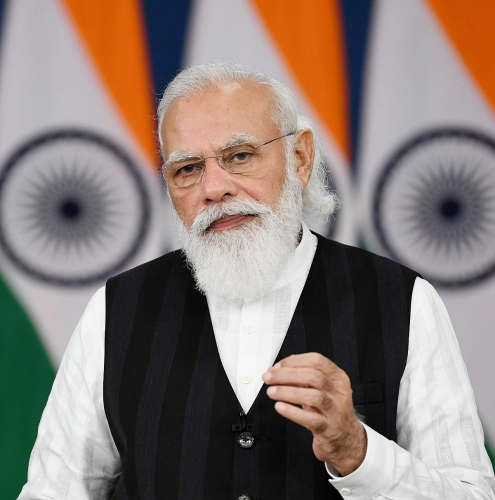
L'Inde de Modi
Le dirigeant moderne de l'Inde, Narendra Modi, le leader du Bharatiya Janata Party (Parti du peuple indien) est un dirigeant conservateur qui suit la tradition du nationalisme indien moderne. Il est un adversaire idéologique du parti libéral Indian National Congress, historiquement lié à la famille Gandhi.
Sur le plan géopolitique, Modi s'oppose au Pakistan et à la Chine, en s'appuyant sur les États-Unis et les pays occidentaux pour le faire. Mais en même temps, il ne romptpas les relations avec la Russie et saisit toutes les occasions de renforcer la souveraineté de l'Inde.
Avec le début de l'opération militaire spéciale de la Russie en Ukraine, Modi a condamné Moscou mais n'a pas soutenu les sanctions anti-russes, reconnaissant clairement dans la stratégie de la Russie une orientation de multipolarité, dont, selon Modi, l'Inde deviendrait logiquement un bénéficiaire. Depuis février 2022, la presse indienne utilise de plus en plus le terme "État-Civilisation" en référence à l'Inde elle-même, ainsi qu'en référence à un ordre multipolaire dans lequel l'Inde est destinée à devenir un pôle.
Ce faisant, le nationalisme de Modi et de son parti se concentre sur le principe de l'Hindutva, une identité associée à l'hindouisme en tant que religion, mais propose un vaste plan visant à intégrer toutes les castes et tous les courants religieux dans la société hindoue - avec reconnaissance de la domination hindoue.
Notes:
[1] Неру Дж. Открытие Индии. В 2 т. М.: Политиздат, 1989.
[2] Ганди И. Мир, сотрудничество, неприсоединение. М.: Прогресс, 1985
[3] Goyal Des R. Rashtriya Swayamsevak Sangh. Delhi: Radha Krishna Prakashan, 1979.
[4] Sharma Mahesh. Shri Guruji Golwalkar. New Delhi: Diamond Pocket Books, 2006.
[5] Vaibhav P. The Sena Story. Op. cit.
[6] Дугин А.Г. Ноомахия. Иранский Логос. Световая война и культура ожидания. Указ. соч.
22:03 Publié dans Actualité | Lien permanent | Commentaires (0) | Tags : actualité, inde, asie, affaires asiatiques, hindouisme, tamouls, dravidiens, pakistan, cachemire, jammu |  |
|  del.icio.us |
del.icio.us |  |
|  Digg |
Digg | ![]() Facebook
Facebook
samedi, 30 juillet 2022
Deux axes qui modifient la géopolitique mondiale : Russie-Chine-Iran et Russie-Iran-Inde

Deux axes qui modifient la géopolitique mondiale: Russie-Chine-Iran et Russie-Iran-Inde
Alfredo Jalife-Rahme,
Analyste géopolitique, auteur et conférencier
Source: https://geopol.pt/2022/07/24/dois-eixos-que-deslocam-a-ge...
L'Iran se positionne désormais comme un centre (une intersection) entre deux axes futuristes, l'un de nature géopolitique (avec la Chine) et l'autre de nature géoéconomique (avec l'Inde) et entre trois superpuissances convergentes (le RIC : Russie-Inde-Chine)
Dans sa sombre oraison funèbre, au lieu de donner une conférence à la Ditchley Foundation, l'ancien Premier ministre britannique méga-polémique Tony Blair (TB), au bord de la dépression mentale et dans le cadre de son schéma bipolaire simpliste entre les États-Unis et la Chine - sans la Russie - a exposé le partenariat stratégique du binôme désormais indissoluble de la Chine et de la Russie, auquel s'ajouterait l'Iran (bit.ly/3vvn3Zl).
Tony Blair a laissé l'Inde et l'Indonésie (la plus grande population islamique du monde) flotter dans le vague, ce qui n'augure rien de bon pour eux de la part de la perfide Albion.
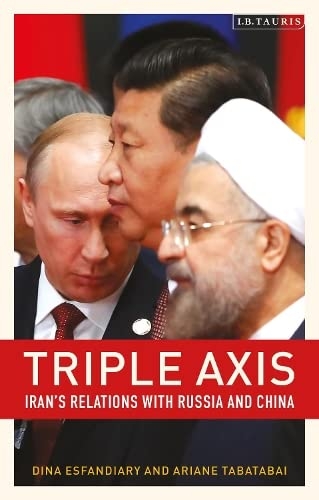
On pourrait arguer que l'axe Russie-Chine-Iran est plus géostratégique, lorsque l'Iran entretient simultanément des relations optimales avec la Chine et la Russie - sans parler de l'Inde - malgré l'épée de Damoclès tranchante des sanctions américaines et la menace permanente d'une attaque d'Israël qui, avec l'appui de Washington, exerce unilatéralement un monopole sur 250 bombes nucléaires au Moyen-Orient.
La récente visite de haut niveau du président russe Vladimir Poutine à Téhéran (sa cinquième visite, ce qui est significatif) - pour assister au sommet trilatéral avec le sultan Erdogan de Turquie dans le cadre du "format Astana (bit.ly/3czsIXB)" destiné à résoudre le conflit syrien - a marqué un accord historique de 40 milliards de dollars sur les hydrocarbures (bit.ly/3oks42G).
Le Global Times de Chine rapporte que la visite de Poutine à Téhéran est un revers majeur pour le camp occidental qui fait suite au voyage de Biden, qui est revenu du Moyen-Orient les mains vides - incapable de créer une OTAN arabe, c'est-à-dire un front contre l'Iran, et pire, incapable d'augmenter la production de pétrole des six pétromonarchies du Conseil de coopération du Golfe, dirigé par l'Arabie saoudite (bit.ly/3B9lDHi).
L'Iran vient de rejoindre le Groupe géostratégique de Shanghai (bit.ly/3IYrKQz) et a demandé à adhérer aux BRICS à l'initiative du chef suprême de la théocratie chiite, l'ayatollah Khamenei, et de son président Ebrahim Raisi.
Le très médiocre conseiller à la sécurité nationale de Biden, Jake Sullivan, affirme que l'Iran prévoit de livrer des centaines de drones de combat à la Russie (bit.ly/3yUBnLE), tandis qu'un autre conseiller accro à la russophobie incoercible, Anshel Pfeffer, exagère en affirmant que "Poutine a perdu la guerre des drones" et en expliquant "comment l'Iran peut l'aider en Ukraine (bit.ly/3yYZZ3i6)".
Deux points saillants qui ont attiré mon attention sont 1. le déclassement progressif de la Turquie, toujours membre de l'OTAN, et de l'Iran, et 2. le très importantes corridor de transport géoéconomique Nord-Sud - par terre, rail et mer (INSTC), de 7200 km reliant la Russie et l'Inde à travers l'Iran et l'Azerbaïdjan en passant par la mer Caspienne (bit.ly/3oj19EB).
Selon les évaluations du PIB nominal posées par le FMI, l'Iran se classe désormais au 14e rang, malgré les sanctions américaines dévastatrices, avec 1,74 trillion de dollars, devant l'Espagne et derrière l'Australie, tandis que la Turquie est tombée au 23e rang avec 692,38 milliards de dollars, ce qui a nui à la valeur de la livre turque.
Selon Bloomberg, la Türkye (son nouveau nom) cherche à abandonner le dollar dans ses paiements pour l'énergie russe, ce qui "pourrait ralentir le déclin de ses réserves (bloom.bg/3BbITok)".

La nouvelle route de l'Inde vers la Russie, via l'Iran et l'Azerbaïdjan, réduira de moitié le poids de la logistique actuelle.
L'INSTC (bit.ly/3Pqzqxn) offre la connectivité la plus courte entre l'Inde et la Russie, ce qui réduira leurs coûts logistiques et le temps de transport.
L'Azerbaïdjan et l'Iran ont également conclu un nouvel accord de transport (bit.ly/3v6nfxC) qui permettra de relier la Russie et l'Inde et fait donc partie de l'INSTC.
L'Iran se positionne ainsi comme un centre (un carrefour) de deux axes futuristes, l'un géopolitique (avec la Chine) et l'autre géoéconomique (avec l'Inde), avec trois superpuissances convergentes (le RIC : Russie-Inde-Chine), tandis que la Turquie, membre de l'OTAN, réfléchit à son dilemme existentiel : rester dans un bloc occidental qui la dédaigne ou renouer avec son glorieux passé de Moyen-Orient-Asie centrale.
19:57 Publié dans Actualité, Eurasisme, Géopolitique | Lien permanent | Commentaires (0) | Tags : actualité, géopolitique, eurasisme, politique internationale, chine, russie, iran, inde |  |
|  del.icio.us |
del.icio.us |  |
|  Digg |
Digg | ![]() Facebook
Facebook
mercredi, 27 juillet 2022
Bhoutan et Népal : les équilibres de pouvoir
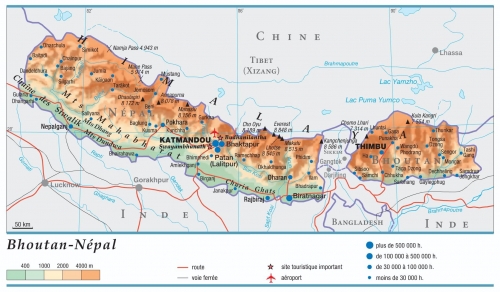
Bhoutan et Népal : les équilibres de pouvoir
Groupe de réflexion Katehon
Source: https://www.geopolitika.ru/it/article/bhutan-e-nepal-equilibri-di-potere?fbclid=IwAR3egPEGtZoYHEpiSViEnD9z8kejrRgJa3Hhcq4ZRv0RBKmIwAPv59y2pKg
Dans le processus de rapprochement avec les grandes puissances, les deux pays de l'Himalaya ont commencé à essayer de créer un environnement diplomatique indépendant. Le Népal et le Bhoutan sont fatigués de jongler avec les grandes puissances et veulent être seuls sur la scène mondiale.
Avec la montée en puissance de la Chine et de l'Inde et la mise en œuvre de leurs plans stratégiques respectifs, les positions stratégiques du Népal et du Bhoutan sont devenues progressivement visibles. L'Inde considère l'Asie du Sud comme sa propre arrière-cour. En raison des nombreux désaccords et contradictions entre la Chine et l'Inde, cette dernière résiste fortement à la pénétration de l'influence chinoise.
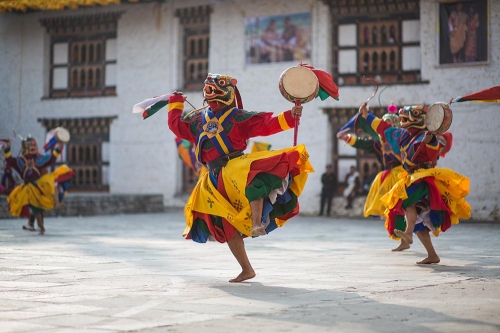
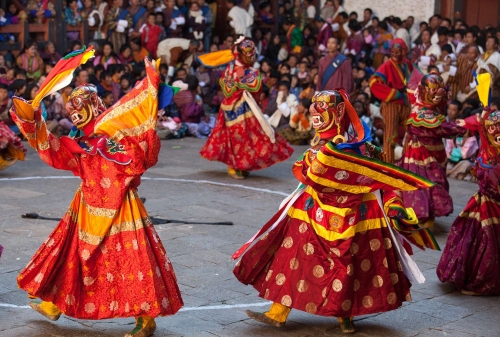
En outre, certaines forces extraterritoriales et forces spéciales, telles que les forces d'infiltration des États-Unis, de la Grande-Bretagne et du Japon, ainsi que les forces indépendantistes tibétaines, se réunissent également ici. Bien que le Népal et le Bhoutan soient enclavés, la géographie de l'Asie du Sud les place au carrefour des forces maritimes et terrestres.
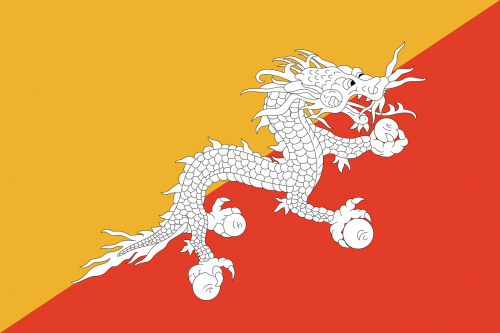
La politique étrangère du Bhoutan : du rapprochement avec l'Inde à l'accès au monde
Le Bhoutan est situé en Asie du Sud et dans la partie nord du sous-continent sud-asiatique, sur le versant sud de l'Himalaya oriental, bordant la Chine à l'est, au nord et à l'ouest et l'Inde au sud-est. C'est l'un des plus petits pays montagneux enclavés et il est connu comme "le dernier Shangri-La du monde" et "le royaume du bonheur". Le Bhoutan est très faible en termes de territoire, d'économie, de population et de ressources. La vulnérabilité inhérente du Bhoutan limite sa capacité à défendre ses droits et à participer au système politique et économique international.
Le Bhoutan est géographiquement situé sur les contreforts sud de l'Himalaya, entre la Chine et l'Inde. La géographie unique du Bhoutan a façonné ses caractéristiques en termes de sécurité nationale, d'intégrité territoriale, de transformation politique, de développement économique et de protection culturelle. En particulier, la position géographique entre les deux grandes puissances a augmenté le poids du comportement diplomatique du Bhoutan. La formation historique complexe du Bhoutan, sa connectivité géographique, ses préoccupations en matière de sécurité, sa dépendance politique et économique et d'autres "faiblesses structurelles" font que le Bhoutan "entretient toujours une relation spéciale" avec l'Inde, toutes ces relations étant fondées sur la faiblesse du Bhoutan, qui détermine ses intérêts de sécurité nationale [1]. Pour cette raison, la préoccupation excessive du Bhoutan pour la sécurité a fait que sa diplomatie a tourné autour de l'Inde tout au long des années 1970, limitant sa diplomatie et ses relations interétatiques à la "protection" de l'Inde, ce qui l'a éloigné en permanence des pays voisins tels que la Chine et de la plupart des organisations internationales [2].
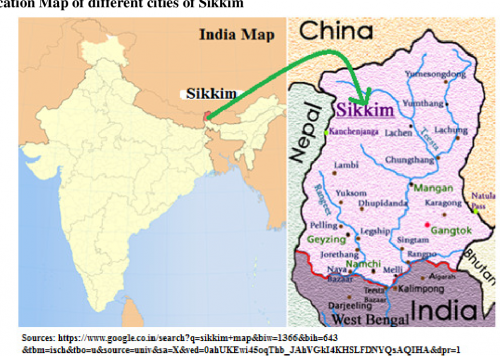
La géopolitique du Bhoutan a connu des changements majeurs au milieu des années 1970, et l'Inde a finalement annexé délibérément le Sikkim en 1975 pour en faire un "État" de l'Inde [3]. Ainsi, après les années 1980, le Bhoutan a commencé à rechercher un développement et une diplomatie indépendants pour contrer les insécurités de la relation hautement asymétrique entre les pays faibles et les grandes puissances. Sur la base de la réalisation de l'indépendance économique, de l'obtention progressive de l'indépendance politique et de la diversification du pays, il a commencé à mener une coopération internationale [4]. Sur cette base, depuis les années 1980, le Bhoutan a commencé à se concentrer sur le développement des relations avec les pays voisins, l'établissement de relations diplomatiques avec d'autres pays, la participation à des organisations internationales et une diplomatie indépendante. Désormais, sa diplomatie ne se limite pas à l'Inde. La Chine a aidé le Bhoutan à établir des relations diplomatiques et à participer à des organisations internationales. L'Inde pense également avoir établi une "amitié" avec le Bhoutan sur la base de la "bonne volonté" et de la "compréhension" [5]. Le Bhoutan a progressivement adopté une politique d'expansion prudente de ses relations, en tenant compte des intérêts régionaux et de sécurité de l'Inde, en explorant activement le multilatéralisme et le bilatéralisme international, et en réduisant sa dépendance politique et économique vis-à-vis de l'Inde.

Bien que le Bhoutan n'ait pas établi de relations diplomatiques avec la Chine, il a soutenu la Chine dans de nombreuses activités internationales. En 1971, le Bhoutan, qui venait de rejoindre l'ONU, a voté pour rétablir le siège légitime de la Chine à l'ONU et a voté à de nombreuses reprises contre les propositions anti-chinoises au sein de l'organisation. Le Bhoutan soutient le principe d'une seule Chine et s'oppose à toute ingérence dans les affaires intérieures de la Chine. Par exemple, en 2000, le Bhoutan a soutenu le gouvernement chinois à l'ONU et s'est opposé à la proposition de la soi-disant "participation de Taïwan à l'ONU". En 2002, le Bhoutan s'est également opposé à la candidature de Taïwan pour accueillir les Jeux asiatiques.
Le 14 octobre 2021, le vice-ministre chinois des Affaires étrangères Wu Jianghao et le ministre bhoutanais des Affaires étrangères Dandy Dorji ont signé un protocole d'accord sur une "feuille de route en trois étapes" visant à accélérer les négociations frontalières entre le Bhoutan et la Chine. Il s'agit d'une étape importante dans les pourparlers frontaliers entre la Chine et le Bhoutan de ces dernières années, et elle a été très appréciée par les milieux politiques des deux pays.
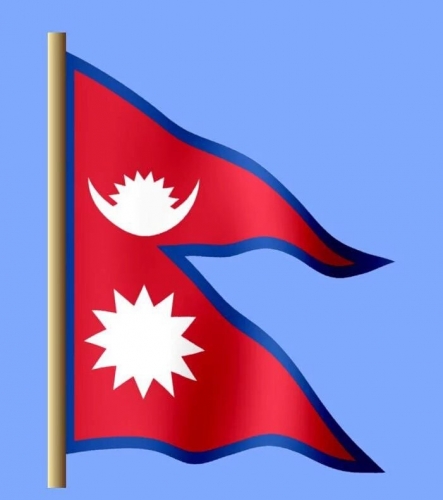
Népal : vers une diplomatie indépendante et la protection de la sécurité nationale
Pour des raisons géographiques, culturelles et géopolitiques, l'Inde a depuis longtemps des intérêts au Népal. Le Népal a de longues frontières avec la Chine et l'Inde, mais la frontière avec la Chine est limitée par le majestueux Himalaya. En revanche, le Népal et l'Inde ont des frontières ouvertes, ce qui est la principale raison pour laquelle le Népal est dominé par l'Asie du Sud. Sa situation géographique fait du Népal un pays d'importance stratégique tant pour l'Inde que pour l'Asie du Sud. Le Népal étant dépendant du commerce avec l'Inde, celle-ci a une plus grande influence politique dans les cercles politiques népalais. L'Inde reconnaît l'indépendance et la souveraineté du Népal, mais le considère toujours comme faisant partie de l'ancien "Bharatbarsha" (sous-continent indien). La proximité culturelle, climatique, linguistique et géographique entre le Népal et l'Inde renforce encore cette attitude. C'est le principal facteur qui détermine l'attitude de l'Inde envers le Népal ainsi que sa politique et sa stratégie.
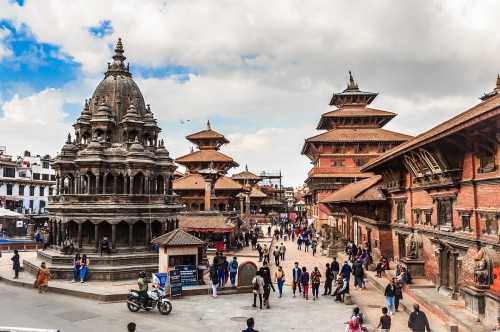
Depuis des siècles, les caractéristiques topographiques de l'Himalaya ont créé des problèmes pour la structure énergétique de la région. La position de la politique étrangère du Népal peut-elle maintenir des relations équidistantes avec la Chine et l'Inde? Ramakant estime que le Népal cherche à maintenir une proximité étroite avec la Chine et l'Inde, ce qui constitue une question clé de la politique étrangère du Népal [6]. Selon la théorie de Ramakant, le Népal doit entretenir des relations étroites et amicales avec l'Inde afin d'étendre ses intérêts économiques et politiques, mais il ne peut être trop proche et amical pour ne pas mettre en danger sa sécurité nationale. Le Népal veut seulement s'entendre avec la Chine pour contrer l'influence indienne. Selon S. D. Mooney, le Népal a adopté les stratégies suivantes pour atteindre ses objectifs de politique étrangère: (1) capitaliser sur les différences et les conflits entre la Chine et l'Inde ; (2) diversifier les relations diplomatiques pour réduire la dépendance à l'égard de deux pays voisins; (3) accroître les contacts internationaux et maintenir la confrontation [7]. Ainsi, la politique du Népal est astucieuse, mais cela ne serait pas arrivé si la présence étatique du Népal avait été moins importante pour les intérêts sino-indiens plus larges.
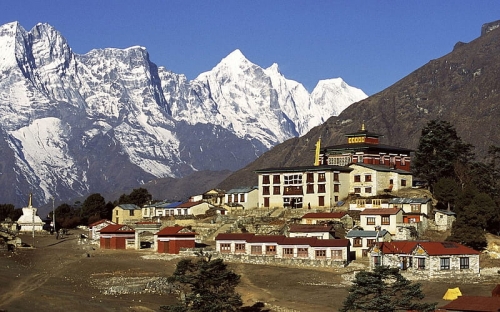
Le Népal a essayé de créer un "équilibre des forces" entre deux voisins puissants, mais dans une certaine mesure, parier sur un côté ou sur une seule carte dans la "théorie du jeu" ne permettra pas au Népal d'atteindre un développement significatif. Déjà pendant la période Panchayat, le Népal avait souligné la nécessité d'adopter une politique d'équidistance entre ses deux puissants voisins. Après 1990, le concept d'équilibre a été utilisé pour expliquer la proximité des centres de pouvoir du Népal avec les détenteurs de pouvoir extérieurs. L'universitaire Dhurba Kumar, dans son livre Nepal's Policy Towards India, définit le terme "équidistance" comme "un concept qui garantit une relation équilibrée avec la Chine et l'Inde". Il estime que "l'égalité souveraine reste la clé du concept". Par conséquent, le Népal doit intentionnellement modifier tous les traités précédents et renoncer aux parties qui sont défavorables à l'intérêt national. Le débat indique clairement la fin de la relation spéciale avec l'Inde. Une relation spéciale avec l'Inde limite la liberté du Népal d'entretenir une relation significative avec la Chine, un sentiment rendu plus concret aujourd'hui par l'aide militaire chinoise et le blocus de l'Inde" [8].
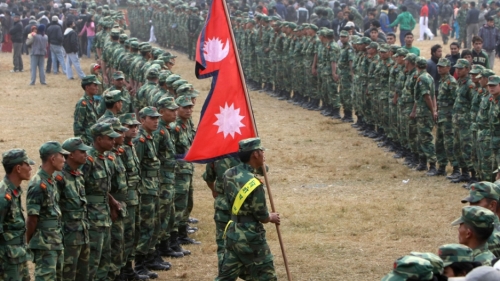
Concernant les défis auxquels le Népal est confronté pour formuler une politique étrangère visant à protéger ses voisins immédiats, le professeur Sadmuk Thapa a suggéré : "La nouvelle diplomatie équidistante du Népal est plus large et plus profonde qu'auparavant. Selon les termes de la science politique, la stratégie de proximité a une orientation multidimensionnelle. Premièrement, cette politique, que le Népal utilisera, est très appropriée dans les relations avec la Chine et l'Inde. Il est tout aussi fiable et bénéfique dans le nouveau Népal pour l'interaction diplomatique. En outre, il s'agit d'une politique positive et constructive, car elle est basée sur le bénéfice mutuel, la confiance mutuelle, l'égalité et la coopération" [9].
Depuis qu'Oli a été élu Premier ministre du Népal pour la deuxième fois en février 2018, la situation intérieure et internationale à laquelle le Népal est confronté a subi des changements majeurs. Tout d'abord, le parti au pouvoir n'est plus dans un état de coalition gouvernementale lâche. Les principaux partis communistes du Népal ont officiellement fusionné pour former le "Parti communiste du Népal". Pour la première fois, le parti au pouvoir a pu conserver son droit de vote au Parlement et la base du pouvoir est devenue plus stable. Deuxièmement, le principal parti d'opposition, le "Parti du Congrès", était divisé sur la question de l'abandon et du maintien de Deuba, ce qui a affaibli sa capacité à interférer dans la politique étrangère d'Oli ; troisièmement, avec le profond développement de la coopération entre la Chine et les pays d'Asie du Sud dans le cadre de "Une ceinture, une route", l'influence de la Chine en Asie du Sud s'est considérablement accrue par rapport à il y a de nombreuses années, et l'Inde a commencé à modifier sa ligne dure initiale envers le Népal.

Avec l'augmentation du nombre de points, cela donne au Népal la possibilité de s'engager dans une diplomatie active entre la Chine et l'Inde. En conséquence, Oli (photo) a adopté une position plus active en matière de politique étrangère tout en promouvant une ligne dure au niveau national. Le Premier ministre Oli a fait de gros efforts pour équilibrer la diplomatie avec la Chine et l'Inde, il cherche à maximiser les intérêts nationaux, à promouvoir le développement de la SAARC et à participer activement à la diplomatie multilatérale.
Notes :
[1] Karma Galay, “Politica internazionale del Bhutan”, Journal of Bhutan Studies, vol. 10, Estate 2004, pp. 90-108.
[2] Geetanjali Sharma e Ajay K. Sharma, “Geopolitics of Bhutan and its Relevance in the Security of India”, International Journal of Interdisciplinary Research in Science Society and Culture, vol. 2, n. 1, 2016, pp. 365-378.
[3] 张明金 、 汤道 凯编 著: 《斯里兰卡 斯里兰卡 印度洋 上 上 上 的 尼泊尔 尼泊尔 尼泊尔 喜马拉雅山 喜马拉雅山 国 不丹 不丹 神龙 之 国 锡金 锡金 山顶 王国》 , , , 军事 , 1995 年 第 125 ~ 126页。
[4] Karma Galay, “Politica internazionale del Bhutan”, Journal of Bhutan Studies, vol. 10, Estate 2004, pp. 90-108.
[5] Dorji Penjore, “Sicurezza del Bhutan: Camminare tra i giganti,” p. 121
[6] Ramakant, Nepal-Cina e India, Delhi, India: South Asia Books, 1976, pp. 47-48.
[7] SD Muni, “The Dynamics of Foreign Policy”, in SD Muni, ed., Nepal: 1977.
[8] Sushi Raj e Pushpa Adhikari Pandey, a cura di, Nepalese Foreign Policy at the Crossroads, 2009, p. 58.
[9] Thana Sadmukh, “Nepal: Sandwiched Between Three Bounders”, Journal of International Affairs, vol. 1, n. 1(2009), p.51.
22:34 Publié dans Actualité, Géopolitique | Lien permanent | Commentaires (0) | Tags : actualité, politique internationale, asie, népal, bhoutan, affaires asiatiques, himalaya, inde, chine, sikkim, géopolitique |  |
|  del.icio.us |
del.icio.us |  |
|  Digg |
Digg | ![]() Facebook
Facebook
samedi, 02 juillet 2022
Naissance d'une route commerciale historique
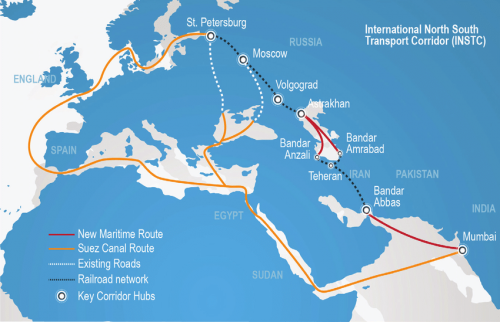
Naissance d'une route commerciale historique
Parth Satam
Source: https://katehon.com/ru/article/znakovyy-torgovyy-marshrut
L'Inde, la Russie et l'Iran font des affaires par le biais du corridor INSTC alors que New Delhi continue d'échapper à la pression américaine
Essais de transport de marchandises russes depuis Astrakhan vers un port du sud de l'Iran jusqu'à leur destination au port Jawaharlal Nehru de Mumbai. L'Autorité portuaire Jawaharlal Nehru à Mumbai (JNPA), qui fait partie du Corridor international de transport Nord-Sud (INSTC), marque les premiers pas de l'Inde, qui rejoint l'axe émergent Russie-Iran-Inde.
Ceci intervient dans un contexte de fissures dans les relations entre l'Inde et les Etats-Unis à propos du commerce croissant du pétrole avec la Russie et du refus de rejoindre le camp occidental pour critiquer Moscou ; en même temps, l'Inde est sur la même longueur d'onde que la Chine à propos de ce qui est perçu comme une pression unilatérale des Etats-Unis forçant le pays à prendre parti dans la rivalité géopolitique russo-américaine.
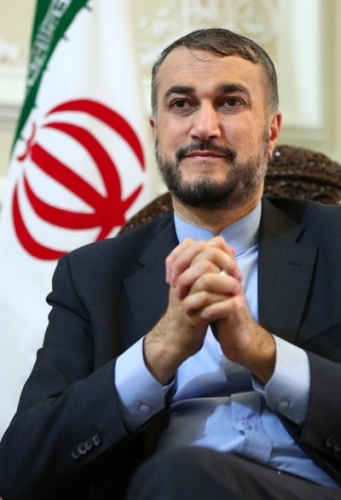
Le processus a débuté après la visite du ministre iranien des Affaires étrangères, Hossein Amir-Abdollahian (photo), en Inde le 8 juin et une conversation téléphonique entre le président russe Vladimir Poutine et le président iranien Ebrahim Raisi le même jour.
Une partie du corridor international de transport Nord-Sud (INSTC) reliant les marchés de la Russie, de la Perse et de l'Asie peut être considérée dans le contexte plus large de changements d'alliances et d'arrangements pragmatiques, motivés principalement par les aléas économiques de l'ère Covid et les sanctions anti-russes.
Les cargaisons sortantes sont deux conteneurs de 40 pieds de lamelles de bois, d'un poids total de 41 tonnes, qui ont été chargés à Saint-Pétersbourg et sont destinés à Astrakhan, où ils seront rechargés dans le port de Solyanka.
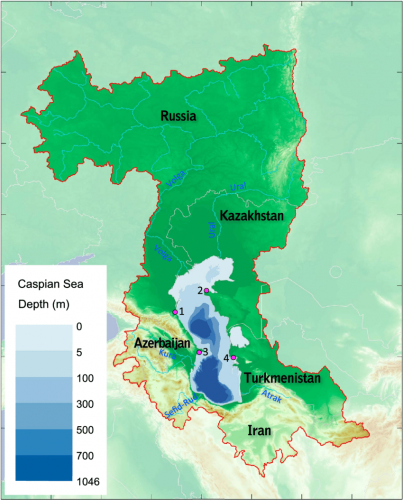
Ensuite, en traversant la mer Caspienne, ils atteindront le port iranien d'Enzeli avant de se diriger vers Bandar Abbas au sud et la dernière étape du voyage vers JNPA (ou Nhava Sheva), selon Dariush Jamali, directeur du terminal commun irano-russe à Astrakhan.

Dans le même temps, l'Iran semblait promouvoir son propre projet régional parallèle sous la forme du chemin de fer Khaf-Herat.
La réduction du voyage de 40 à 25 jours, car elle permet d'éviter le trajet plus long par le canal de Suez et de réduire les frais de transport maritime de 25 %, est importante dans le contexte actuel de forte inflation.
Le pragmatisme consistant à mettre de côté des positions différentes pour une raison plus substantielle a pu être observé dans la touche très sensible d'Amir-Abdollahan sur les questions de minorités en Inde.
"Téhéran et New Delhi s'accordent sur la nécessité de respecter les religions divines et les sanctuaires islamiques", a-t-il tweeté, ajoutant : "L'Iran et l'Inde sont déterminés à porter leurs relations à un niveau supérieur."
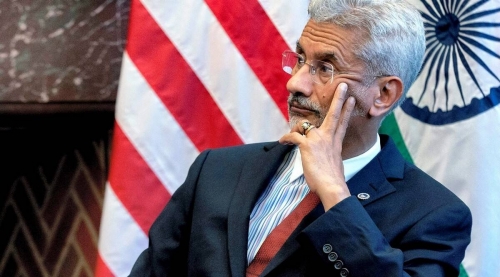
Heureux de rencontrer le Premier ministre Modi, le ministre des Affaires étrangères Jaishankar (photo) et d'autres responsables indiens pour faire progresser notre dialogue stratégique bilatéral. Téhéran et New Delhi s'accordent sur la nécessité de respecter les religions divines et les sanctuaires islamiques et d'éviter les déclarations controversées. Nous sommes déterminés à porter les relations à un niveau supérieur.
Le même jour, lors d'un appel téléphonique entre Poutine et Raisi, des accords ont été conclus sur la mise en œuvre de "projets communs dans le domaine de l'économie et du commerce", a indiqué le Kremlin dans un communiqué.
Auparavant, l'Inde avait cherché de manière contre-productive à construire des coalitions régionales. Étant à l'apogée de son alliance stratégique avec les États-Unis en 2020, elle n'a pas pu obtenir les conditions financières du projet Chabahar en raison des sanctions américaines contre l'Iran concernant l'accord nucléaire sous l'administration de Donald Trump. Cela a conduit l'Iran à exclure le pays du projet en juin 2020.
Ainsi, l'objectif déclaré de l'Inde d'atteindre l'Asie centrale (via Chabahar) n'a pu être atteint en raison de la pression occidentale. Il y a 73 ans, les Britanniques sortants ont partitionné le sous-continent, divisant l'Asie centrale, du Sud et de l'Ouest pour limiter l'influence de l'Union soviétique dans la région.
L'Inde avait une frontière terrestre avec l'Iran et l'Afghanistan, et un plan élaboré pour pénétrer en Asie centrale aurait été dangereux pour les puissances maritimes. L'intégration des terres par la continuité naturelle de la vaste masse terrestre eurasienne a sapé les routes commerciales maritimes, qui, selon les historiens, étaient un outil majeur de la domination coloniale occidentale.
Aujourd'hui, l'Inde maintient ses relations avec le Pakistan à un niveau acceptable, et la rhétorique de son soutien aux militants du Cachemire et aux acteurs terroristes non étatiques est presque absente chez ses dirigeants politiques.
Cela fait également intervenir les Talibans (interdits en Russie - Ndlr), un signe que l'Inde se rapproche des vues régionales de l'Asie centrale, de la Russie, de l'Iran et de l'Asie occidentale et accepte l'existence des Talibans comme une réalité politique. Il appelle à ignorer la doctrine ultra-conservatrice et orthodoxe du groupe au nom d'un véritable intérêt pour la stabilité en Afghanistan.
Pendant ce temps, les alliés des États-Unis considèrent que Washington développe un projet de plus en plus protectionniste, indépendamment des convictions idéologiques, républicaines ou démocrates, qui ne leur viendra pas en aide en cas de conflit et évitera toute nouvelle intervention militaire.
Le changement d'alliances mondiales provoqué par le conflit Russie-Ukraine est visible dans les positions changeantes d'Israël et de l'Iran, qui se sont déplacés entre les camps russe et américain.
Par exemple, Israël est passé du statut d'intermédiaire privilégié de Poutine, transmettant les pensées de ce dernier à l'Europe, aux États-Unis et à l'Ukraine dans les premiers jours du conflit, à celui de critique le plus sévère de Moscou en échange du blocage par les États-Unis des négociations sur le programme nucléaire iranien.
En mars, les États-Unis ont désespérément tenté de conclure l'accord pour s'assurer des approvisionnements supplémentaires en pétrole iranien et faire baisser les prix mondiaux du pétrole.
L'Iran a alors vu une opportunité et a flirté avec les États-Unis pendant un certain temps, s'éloignant de sa doctrine d'"économie de résistance" et de "pivot vers l'Est" - résister aux sanctions dévastatrices des États-Unis au détriment d'une coopération accrue avec les principales puissances eurasiennes - pour engager l'Occident dans des négociations nucléaires et obtenir un certain soulagement économique. Il est revenu à une position dure après que les États-Unis ont fait pression sur l'Iran et ont bloqué l'accord sous la pression israélienne.
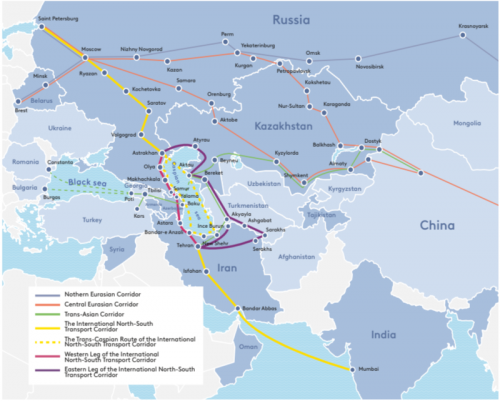
L'Iran et l'Inde ont également constaté que les commentaires du président Joe Biden et de son secrétaire à la défense Lloyd Austin ("cet homme ne peut pas rester au pouvoir", "l'objectif est d'affaiblir la Russie") visaient davantage à affronter Moscou qu'à défendre l'Ukraine dans la guerre par procuration soutenue par les États-Unis.
Les succès de la Russie à Marioupol, où plus de 2000 combattants néonazis se sont rendus dans l'aciérie Azovstal, et la perte actuelle de "100 soldats ukrainiens chaque jour" dans le Donbass, selon le président Vladimir Zelensky lui-même, augurent d'un probable triomphe de la Russie.
Par ailleurs, l'Inde n'a pas encore pleinement soutenu l'axe Russie-Iran-Chine, comme le prouve son adhésion au groupement Israël-Inde-États-Unis-Émirats arabes unis (I2U2), où Israël et les EAU partagent une méfiance mutuelle à l'égard de l'Iran.
Les liens renforcés de l'Inde avec les Émirats, où ces derniers ont suscité l'indignation avec les commentaires controversés de Nupur Sharma, porte-parole suspendu du BJP, les relations tendues des Émirats avec Israël après les Accords d'Abraham de 2020, et l'apaisement désespéré de Washington envers Abu Dhabi pour augmenter la production de pétrole après qu'il ait été indigné par l'échec du premier à condamner les attaques de Husi soutenues par l'Iran, rendent la perspective plus sérieuse.
17:29 Publié dans Actualité, Eurasisme, Géopolitique | Lien permanent | Commentaires (0) | Tags : actualité, politique internationale, iran, russie, inde, instc, eurasie, eurasisme |  |
|  del.icio.us |
del.icio.us |  |
|  Digg |
Digg | ![]() Facebook
Facebook
jeudi, 23 juin 2022
Une vision du monde bi-multipolaire rapproche plus que jamais l'Inde et l'ASEAN
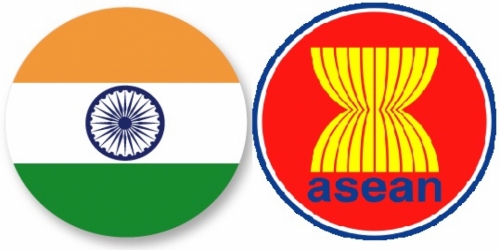
Une vision du monde bi-multipolaire rapproche plus que jamais l'Inde et l'ASEAN
Andrew Korybko
Source: https://www.geopolitika.ru/it/article/la-visione-del-mondo-bi-multipolare-avvicina-lindia-e-lasean-come-mai-prima-dora
Du point de vue de la grande stratégie, l'Inde a l'opportunité de devenir un pivot géostratégique qui peut façonner la trajectoire de la phase intermédiaire dite "bi-multipolaire" de la transition systémique mondiale vers une multipolarité plus complexe, en gérant l'émergence de la tripolarité en Eurasie parallèlement à la Russie et dans l'Indo-Pacifique avec l'ASEAN.
La semaine dernière, l'Inde a accueilli une réunion spéciale des ministres des affaires étrangères avec ses partenaires de l'ANASE pour commémorer le 30e anniversaire de leur relation de dialogue. La réunion est passée inaperçue aux yeux de la plupart des observateurs, car elle n'a pas eu d'issue spectaculaire et la seule chose substantielle qui en est ressortie est une déclaration commune sur la nécessité de continuer à étendre leur coopération, mais les remarques d'ouverture du diplomate singapourien suggèrent que les parties se sont récemment rapprochées comme jamais auparavant.
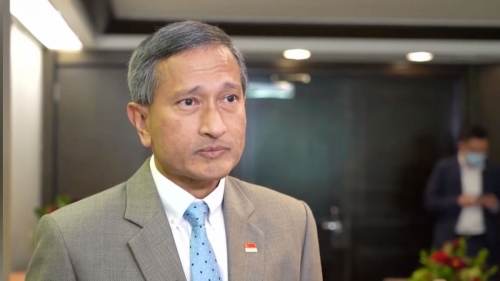
Le ministre des Affaires étrangères de l'île-Etat, Vivian Balakrishnan (photo), a déclaré que "l'escalade de la rivalité entre les superpuissances américaine et chinoise a des implications directes pour nous tous en Asie. Ces évolutions, si elles ne sont pas maîtrisées, peuvent menacer l'ancien système de paix et de stabilité, dont nous dépendons depuis de nombreuses décennies pour notre croissance, notre développement et notre prospérité". C'est un clin d'œil évident au concept de bi-multipolarité du penseur indien Sanjaya Baru (photo) d'il y a quelques années, selon lequel les superpuissances américaine et chinoise façonnent plus que quiconque l'ordre international en évolution.
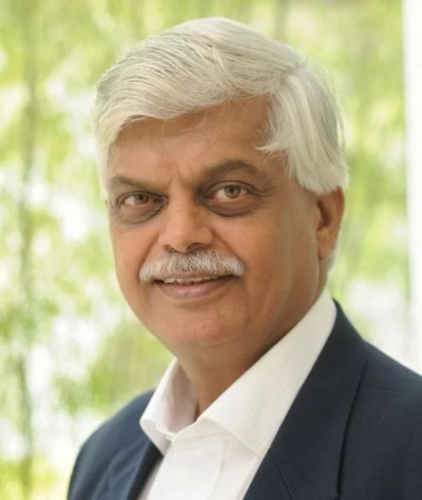
Au-dessous de ces deux géants, a-t-il fait valoir, se trouve un nombre croissant de grandes puissances, tandis que l'échelon inférieur de l'ordre international est occupé par des États relativement petits et moyens qui ne jouent pratiquement aucun rôle dans la transition systémique mondiale vers une multipolarité plus complexe. Baru a identifié l'Inde comme l'une des grandes puissances mondiales, alors que l'on peut affirmer que l'ANASE (ASEAN) dans son ensemble peut également être considérée comme telle. La reconnaissance par le ministre des affaires étrangères Balakrishnan de l'Amérique et de la Chine en tant que superpuissances jette les bases conceptuelles d'une coopération plus étroite avec l'Inde grâce à la vision du monde bi-multipolaire tacitement partagée.
Pour expliquer son point de vue, Baru a précisé que l'ordre international sera défini par les deuxième et troisième échelons, qu'il a placés dans sa hiérarchie théorique, lesquels s'équilibrent activement entre eux et les deux superpuissances. Le but ultime est que toutes les parties tirent un maximum de bénéfices de leurs partenaires, les grandes puissances en particulier visant à poursuivre leur ascension jusqu'à éroder progressivement l'influence des superpuissances, de sorte qu'un multipolarisme plus complexe puisse succéder à la phase transitoire du tripolarisme qui viendra après la phase intermédiaire bi-multipolaire actuelle.
À cette fin, l'Inde est intervenue de manière décisive après le début de l'opération militaire spéciale de la Russie en Ukraine, afin de devenir la soupape de sûreté irremplaçable pour Moscou face aux pressions occidentales et d'empêcher ainsi la dépendance potentiellement disproportionnée de son partenaire vis-à-vis de la Chine, qui aurait pu remodeler la nouvelle guerre froide en faveur de Pékin et ainsi déstabiliser le continent selon Delhi. Certains États de l'ANASE alignés sur les États-Unis, comme Singapour, sont réticents à coopérer avec la Russie de peur d'irriter leur patron, il ne faut donc pas s'attendre à ce que le bloc dans son ensemble rejoigne le Neo-NAM.
Ce concept fait référence au nouveau Mouvement des non-alignés que la Russie et l'Inde espèrent construire conjointement afin de créer un troisième pôle d'influence pour assurer la transition de la phase actuelle du bipolarisme vers le tripolarisme, facilitant ainsi l'émergence d'un multipolarisme plus complexe au fil du temps. Cependant, Delhi peut intervenir de manière décisive en devenant la soupape de décharge irremplaçable de l'ANASE face aux pressions des superpuissances, un peu comme le rôle qu'elle joue avec Moscou, afin de leur fournir une troisième option équilibrée au lieu de se sentir obligés de choisir entre Washington et Pékin.
Le diable est dans les détails quant à la manière dont cela pourrait se dérouler dans la pratique, car l'Inde n'a pas l'attrait des garanties de sécurité américaines en mer de Chine méridionale et est loin d'avoir l'influence économique que la Chine exerce sur l'Asie du Sud-Est, mais elle peut toujours continuer à coopérer étroitement avec l'ANASE de manière de plus en plus créative afin de maximiser la flexibilité géostratégique du bloc. Puisque les deux parties s'accordent sur le fait que l'Amérique et la Chine sont des superpuissances, il s'ensuit naturellement que l'ANASE est déjà en bonne voie d'adopter le concept de bi-multipolarité de l'Inde et tout ce qu'il implique.
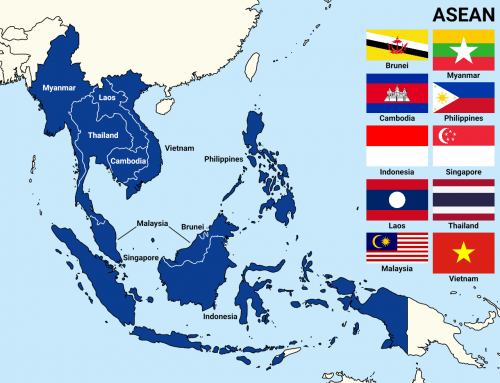
Il appartient donc à Delhi d'étendre son jeu d'équilibre de l'Eurasie à l'Indo-Pacifique, en tirant les leçons de sa récente expérience avec Moscou pour reproduire son succès avec l'ANASE (ASEAN). Les deux paires de partenaires sont complètement différentes et n'ont pratiquement rien en commun, si ce n'est un désir partagé de maximiser leur autonomie stratégique dans la phase intermédiaire bi-multipolaire actuelle de la nouvelle guerre froide, mais c'est là que l'Inde s'est imposée comme le partenaire de choix, car cet État civilisationnel d'Asie du Sud est la seule grande puissance capable d'aider les deux à atteindre ces objectifs.
Du point de vue de la grande stratégie, l'Inde a la possibilité de devenir le pivot géostratégique capable de façonner la trajectoire de la phase intermédiaire bi-multipolaire de la transition systémique mondiale vers un multipolarisme plus complexe, en gérant l'émergence du tripolarisme en Eurasie vis-à-vis de la Russie et dans l'Indo-Pacifique vis-à-vis de l'ANASE (ASEAN). Cette tâche ambitieuse exige une habileté diplomatique sans précédent, mais elle a déjà récolté des dividendes impressionnants auprès de Moscou, comme en témoigne le fait qu'elle a évité le sort de devenir le "partenaire junior" de Pékin, contrairement à ce que beaucoup avaient prévu.
L'Inde peut également faire de même en renforçant l'autonomie stratégique de l'ANASE, afin que le bloc dans son ensemble ne devienne pas le "partenaire junior" de la superpuissance américaine ou chinoise, même si certains États en son sein optent pour ce destin, s'ils estiment qu'il en va de leur intérêt national objectif. Du point de vue de Delhi, le plus important est que cette plate-forme d'intégration régionale reste neutre dans la nouvelle guerre froide, afin d'éviter de donner un avantage à l'une ou l'autre superpuissance. Cela peut à son tour donner à l'Inde le temps stratégique dont elle a besoin pour reproduire le jeu d'équilibre perfectionné par la Russie avec l'ensemble de l'ANASE.
Au mieux, l'Inde se retrouvera au centre d'un réseau transcontinental d'intégration terre-mer s'étendant de la Russie en Europe de l'Est à l'Iran en Asie occidentale et à l'Indonésie en Asie du Sud-Est, si elle parvient à gérer l'émergence de la tripolarité en Eurasie et dans l'Indo-Pacifique en utilisant la formule conceptuelle de la bi-multipolarité de Baru. Bien sûr, de nombreuses choses peuvent se produire qui pourraient gâcher ces plans, mais en général, l'Inde est déjà en passe d'y parvenir, à des degrés divers, et ce n'est peut-être qu'une question de temps avant qu'elle n'y parvienne.
17:17 Publié dans Actualité, Géopolitique | Lien permanent | Commentaires (0) | Tags : anase, asean, asie, affaires asiatiques, inde, chine, états-unis, politique internationale, géopolitique |  |
|  del.icio.us |
del.icio.us |  |
|  Digg |
Digg | ![]() Facebook
Facebook
mercredi, 08 juin 2022
L'Inde est en passe de devenir une puissance géo-économique avec laquelle il faudra compter en Eurasie
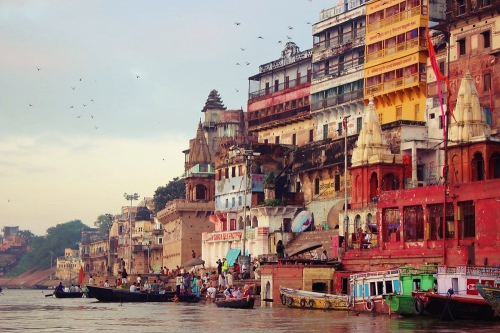
L'Inde est en passe de devenir une puissance géo-économique avec laquelle il faudra compter en Eurasie
Andrew Korybko
Source: http://www.elespiadigital.com/index.php/noticias/geoestrategia/37949-2022-06-07-15-00-03
L'un des résultats les plus inattendus de l'opération militaire russe en cours en Ukraine a été la montée en force de l'Inde en tant que grande puissance eurasienne. Delhi est intervenue de manière décisive pour devenir la soupape irremplaçable de Moscou face à la pression occidentale, ce qui a permis d'éviter de manière préventive une dépendance potentiellement disproportionnée du Kremlin vis-à-vis de Pékin dans ces nouvelles conditions difficiles et a ainsi renforcé mutuellement l'autonomie stratégique complémentaire de la Russie et de l'Inde.
Il s'agit d'un développement qui a changé la donne et qui a considérablement modifié le cours de la nouvelle guerre froide à ses débuts, influençant grandement la trajectoire stratégique de tous les acteurs clés à l'avenir.
Les doutes concernant les allégeances géopolitiques de l'Inde ont été dissipés une fois pour toutes: cet État-civilisation place ses propres intérêts au premier plan selon le ministre des Affaires étrangères Jaishankar, ce qui ne signifie pas nécessairement qu'il promeut ses intérêts au détriment des autres. L'Inde aspire plutôt à maintenir une équidistance entre l'ordre mondial unipolaire libéral-mondialiste (ULG/Unipolar-Liberal-Globalist) représenté par l'Occident dirigé par les États-Unis et l'ordre mondial multipolaire conservateur-souverainiste (MCS/Multipolar-Conservative-Souverainist) dirigé conjointement par la Russie et la Chine. Le premier partage les intérêts de l'Inde dans la "gestion" de la montée en puissance de la Chine, tandis que le second s'aligne sur la détermination de Delhi à réformer progressivement les relations internationales pour les rendre plus équitables, plus justes et plus stables.
Rien n'a changé en ce qui concerne les liens de l'Inde avec les ULG, puisqu'elle participe toujours au Quad, mais ce qui est nettement différent ces derniers mois, c'est le rôle qu'elle joue dans les efforts du MSC pour intégrer le cœur de l'Eurasie. Le corridor de transport Nord-Sud (NSTC) entre l'Iran et la Russie (où l'Azerbaïdjan représente la route terrestre continue entre eux, tandis que la mer Caspienne est la route maritime alternative) est devenu le seul corridor logistique viable pour l'économie mondiale selon le ministre des transports de ce pays à la fin du mois dernier. Ce fait géo-économique confère à l'Inde, ancrage méridional du NSTC, une importance sans précédent pour la Russie et donc pour le reste de l'Eurasie.
En outre, son partenaire iranien commun est également devenu la porte d'entrée de l'Inde en Afghanistan et en Asie centrale. Dans le premier cas, l'État-Civilisation d'Asie du Sud a récemment envoyé ses diplomates tenir sa première réunion officielle avec les Talibans depuis le retour au pouvoir de ce groupe en août, tandis que dans le second cas, l'Inde tombe de plus en plus sous la coupe économique de ses rivaux chinois. La Russie espère que l'accès à l'Afghanistan facilité par l'Iran pour l'Inde servira de tremplin à Delhi pour équilibrer géo-économiquement Pékin dans cette région plus vaste afin de permettre à Moscou d'y maintenir son influence traditionnelle, d'autant plus que le potentiel de projets communs est passionnant.
Si le lecteur jette un rapide coup d'œil à la carte, il constatera que ces deux couloirs de transit géo-économiques iraniens couvrent une grande partie du cœur de l'Eurasie, ce qui témoigne de l'influence croissante de l'Inde au sein du supercontinent. Cela ne serait pas possible si l'Iran ne coopérait pas étroitement avec l'Inde à cette fin, avec la bénédiction de la Russie. Ces trois grandes puissances réalisent à quel point elles ont besoin les unes des autres en ce moment crucial de la transition systémique mondiale vers la multipolarité. Les relations internationales se trouvent actuellement dans ce que l'on peut décrire comme une phase intermédiaire bi-multipolaire caractérisée par les superpuissances américaine et chinoise exerçant la plus grande influence sur le système mondial.
La Russie, l'Inde et l'Iran ne veulent pas devenir les "partenaires juniors" de l'un ou l'autre de ces deux pays, mais cherchent à créer ensemble un troisième pôle d'influence au sein de cet ordre en évolution, d'où leur étroite coopération depuis le début de l'opération spéciale de Moscou et depuis les sanctions occidentales sans précédent prises par les États-Unis en réponse. La cheville ouvrière de ce paradigme est l'Iran, sans lequel les ambitions de ses partenaires proches, grandes puissances beaucoup plus influentes, seraient impossibles à réaliser. C'est pourquoi il est si important de prêter attention au voyage du ministre des Affaires étrangères Abdollahian en Inde la semaine prochaine, au cours duquel il devrait discuter des détails de sa stratégie géo-économique trilatérale visant à intégrer le cœur de l'Eurasie.
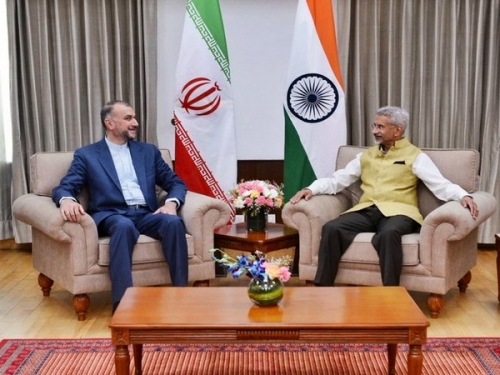
Le public n'est peut-être pas au courant de tous les résultats de sa visite, mais personne ne devrait douter qu'il s'agira de l'un des engagements diplomatiques les plus importants pris entre l'Iran et l'Inde depuis des années, compte tenu du contexte mondial dans lequel il se déroule. Il ne s'agit pas de minimiser l'importance de la Chine et de la Turquie dans l'intégration du cœur de l'Eurasie par le biais du Corridor du Milieu, mais seulement de souligner que la République populaire n'est plus seule aux commandes. L'initiative "Belt & Road" (BRI) de Pékin restera toujours l'un des véhicules les plus puissants de la multipolarité, mais elle n'est désormais plus la seule, car le NSTC et son corridor complémentaire de Chabahar transforment également l'Inde en une puissance eurasienne majeure.
C'est cette tendance, plus que toute autre chose qui s'est développée depuis que la nouvelle guerre froide s'est réchauffée de façon spectaculaire après le début de l'opération spéciale de la Russie, qui constitue l'un des développements les plus inattendus de ces derniers mois. Il est difficile de surestimer l'importance de ce phénomène, car il se produit au début d'une nouvelle phase de la transition systémique mondiale, ce qui signifie que son impact est bien plus important que si tout cela se produisait progressivement. Peu de gens ont encore reconnu le rôle que l'Inde est sur le point de jouer dans l'intégration du cœur de l'Eurasie, mais plus tôt ils le feront, plus tôt ils pourront contribuer à aider le monde à mieux comprendre cette tendance fondamentale.
21:06 Publié dans Actualité, Géopolitique | Lien permanent | Commentaires (0) | Tags : russie, inde, iran, asie, eurasie, affaires asiatiques, géopolitique, politique internationale |  |
|  del.icio.us |
del.icio.us |  |
|  Digg |
Digg | ![]() Facebook
Facebook
vendredi, 27 mai 2022
La Russie, l'Iran et l'Inde créent un troisième pôle d'influence dans les relations internationales
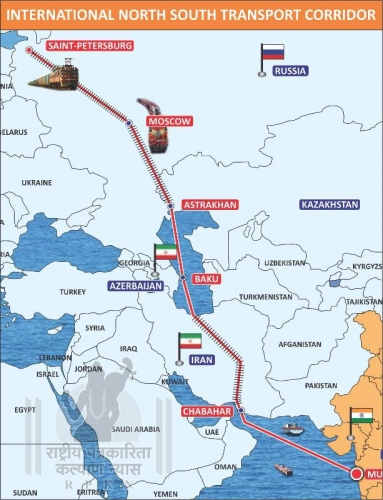
La Russie, l'Iran et l'Inde créent un troisième pôle d'influence dans les relations internationales
Andrew Korybko
Source: http://www.elespiadigital.com/index.php/noticias/geoestrategia/37812-2022-05-23-12-51-00
Le ministre russe des Transports, Valery Savelyev, vient de reconnaître le rôle vital que joue aujourd'hui l'Iran pour la logistique de son pays grâce au corridor de transport Nord-Sud (NSTC - North South Transport Corridor). Selon lui, les sanctions occidentales sans précédent imposées par les États-Unis en réponse à l'opération militaire russe en cours en Ukraine "ont pratiquement brisé toute la logistique dans notre pays. Et nous sommes obligés de chercher de nouveaux couloirs logistiques".
La principale priorité de son pays est le NSTC à travers l'Iran, notant que trois ports de la mer Caspienne servent déjà de conduits commerciaux avec la République islamique, tout en reconnaissant qu'il reste beaucoup à faire en matière de connectivité terrestre.
Peu après le début de l'opération spéciale de la Russie, il avait déjà été prédit que l'Iran deviendrait beaucoup plus important pour la Russie. En effet, le NSTC fonctionne comme un corridor d'intégration entre les civilisations, reliant la civilisation historiquement chrétienne de la Russie, la civilisation islamique-chiite de l'Iran et la civilisation hindoue de l'Inde, sans oublier d'autres, comme celles d'Afrique et d'Asie du Sud-Est, qui peuvent se relier indirectement à la Russie par cette voie. Il s'agit d'une soupape irremplaçable à la pression économique et financière de l'Occident dirigée par les États-Unis, qui a créé tant de difficultés logistiques pour la Russie ces derniers mois, d'autant plus qu'elle est reliée à l'Inde, qui a défié la pression occidentale en continuant à pratiquer sa politique de neutralité de principe.
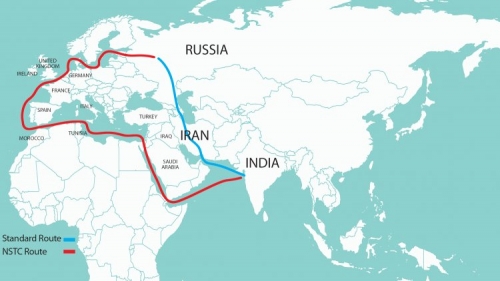
Sans la participation de premier plan de l'Iran au NSTC, la Russie serait isolée de ses indispensables partenaires indiens dont l'intervention décisive lui a évité de manière préventive une dépendance potentiellement disproportionnée vis-à-vis de la Chine à l'avenir. Ce résultat, à son tour, a aidé le monde à dépasser l'actuelle phase intermédiaire bi/multipolaire de la transition systémique mondiale vers la multipolarité qui a vu les relations internationales largement façonnées par la compétition entre les superpuissances américaine et chinoise. Il est de plus en plus possible de parler d'un troisième pôle d'influence représenté par la grande convergence stratégique entre la Russie, l'Iran et l'Inde.
Leurs diplomates ne le reconnaissent pas officiellement, de peur que les superpuissances américaines et/ou chinoises n'interprètent mal les intentions de leurs États-civilisation, mais tous trois tentent officieusement de réunir un nouveau Mouvement des non-alignés ("Néo-NAM"). Ils espèrent servir de centres de gravité égaux au sein du troisième pôle d'influence qu'ils souhaitent créer afin de faire évoluer les relations internationales au-delà de leur phase intermédiaire bi/multipolaire actuelle et vers un système de "tripolarité" qui, espèrent-ils, facilitera inévitablement l'émergence de relations multipolaires complexes. L'objectif de cette démarche est de maximiser leur autonomie stratégique respective dans le cadre de la nouvelle guerre froide vis-à-vis des deux superpuissances.
Les implications internationales de la réussite de leur plan changeraient littéralement les règles du jeu, ce qui explique pourquoi des efforts sont déployés pour les arrêter. Elles ont pris la forme d'une campagne de guerre de l'information menée par l'Associated Press à la tête des grands médias occidentaux dirigés par les États-Unis contre le partenariat stratégique Russie-Iran, tandis que d'autres médias mènent une campagne complémentaire contre le partenariat stratégique Russie-Inde. Les deux ont échoué alors que leurs dirigeants s'appuient sur leur vision du monde multipolaire-conservatrice-souverainiste (MCS) commune pour maintenir le cap malgré une pression considérable après que leurs stratèges leur aient soi-disant assuré que tout finirait par payer, pour peu qu'ils restent patients.
Cela contraste avec son voisin pakistanais, qui semble de manière convaincante être en train de recalibrer sa grande stratégie et le rôle associé envisagé dans la transition systémique mondiale suite à son changement scandaleux de gouvernement. Les signaux contradictoires que ses nouvelles autorités ont envoyés à la Russie, parallèlement à leur rapprochement enthousiaste avec les États-Unis, suggèrent fortement que la vision du monde MCS précédemment épousée par l'ancien premier ministre Khan est progressivement remplacée, à un degré incertain, par un libéralisme unipolaire favorable à l'Occident mondialiste (ULG - Unipolar Liberal-Globalist). Cela complique les processus multipolaires en Asie du Sud et risque d'en isoler le Pakistan dans le pire des cas.
Cependant, le Pakistan n'a aucune intention d'interférer avec le NSTC, même s'il devait s'engager dans un rapprochement complet et extrêmement rapide avec les États-Unis. Cette observation signifie que la grande convergence stratégique entre la Russie, l'Iran et l'Inde va se poursuivre, les deux derniers devenant encore plus importants que jamais pour Moscou en tant que soupapes à la pression occidentale et alternatives fiables pour éviter de manière préventive toute dépendance potentiellement disproportionnée vis-à-vis de la Chine. Le Pakistan était censé jouer un rôle complémentaire dans le Grand partenariat eurasiatique (GPE) de la Russie en servant également à équilibrer la dépendance croissante de Moscou vis-à-vis de Téhéran et de New Delhi, mais cela semble peu probable à la lumière des récents développements.
Avec des relations virtuellement gelées sur le front énergétique qui était conçu comme la base de leur partenariat stratégique espéré, il y a peu de chances que la Russie considère un jour le Pakistan comme plus important pour son "pivot vers l'Oumma" que l'Iran ne l'est aujourd'hui, alors qu'il est en train de le devenir, à moins que ces questions ne soient résolues de toute urgence. Selon toute vraisemblance, elles ne le seront pas, et cette prédiction désastreuse découle de la conjecture selon laquelle les nouvelles autorités pakistanaises considèrent le ralentissement du rythme de son rapprochement avec la Russie comme une "concession unilatérale acceptable" en échange de la poursuite des pourparlers sur l'amélioration des liens avec les États-Unis, qui est leur nouvelle priorité en matière de politique étrangère.
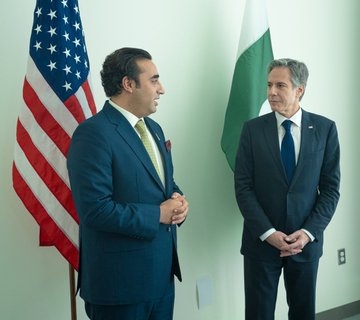
Bien que de petits pas vers le rétablissement des relations aient été constatés récemment, l'interview du ministre des Affaires étrangères Bhutto à l'Associated Press lors de son voyage inaugural aux États-Unis pour assister à un événement de l'ONU et rencontrer personnellement Blinken a jeté le doute sur l'intérêt d'Islamabad à reprendre les pourparlers sur l'énergie avec la Russie. Selon les médias, il a révélé que "lors de ses entretiens avec Blinken, il s'est concentré sur l'augmentation des échanges commerciaux, en particulier dans l'agriculture, les technologies de l'information et l'énergie". Cela suggère que les États-Unis tentent d'exercer un effet de levier sur le prétendu accord conclu par la Russie avec le Pakistan pour lui fournir des denrées alimentaires et du carburant à un prix réduit de 30 %, et peut-être même d'offrir un rabais moins important, le cas échéant, comme "coût nécessaire" pour améliorer les relations...
Le résultat prévisible de la décision du Pakistan de ne pas reprendre les pourparlers sur l'énergie avec la Russie est que l'importance de l'Iran et de l'Inde dans la grande stratégie russe continuera à croître sans que le facteur d'équilibre pakistanais, que Moscou considérait auparavant comme acquis, ne puisse être contrôlé. Ce ne sera pas un problème, à moins qu'ils ne politisent leur rôle de soupape pour la pression occidentale, ce qu'ils sont réticents à faire de toute façon, car cela pourrait nuire à leurs intérêts communs de MSC dans la transition systémique mondiale par le biais du Néo-MNA. Cependant, il reste important de noter que l'élimination pratique de l'influence équilibrante du Pakistan dans ce paradigme accroît la dépendance de la Russie vis-à-vis de l'Iran et de l'Inde.
Que les relations russo-pakistanaises deviennent stratégiques ou non, comme Moscou l'espérait, et qu'elles contribuent par conséquent à équilibrer le Néo-NAM qu'elle envisage, il ne fait aucun doute que l'axe que la Russie est en train de constituer avec l'Iran et l'Inde continuera à se renforcer, ces trois pays poursuivant conjointement la création d'un troisième pôle d'influence dans les relations internationales. La réussite de ce projet aidera le monde à dépasser la phase intermédiaire bi/multipolaire actuelle de la transition systémique mondiale et, par conséquent, à créer davantage d'opportunités pour les autres pays de renforcer leur autonomie stratégique dans la nouvelle guerre froide.
18:55 Publié dans Actualité, Affaires européennes, Géopolitique | Lien permanent | Commentaires (0) | Tags : géopolitique, north south transport corridor, iran, inde, russie, europe, asie, affaires européennes, affaires asiatiques, politique internationale |  |
|  del.icio.us |
del.icio.us |  |
|  Digg |
Digg | ![]() Facebook
Facebook
lundi, 02 mai 2022
RICs et multipolarité
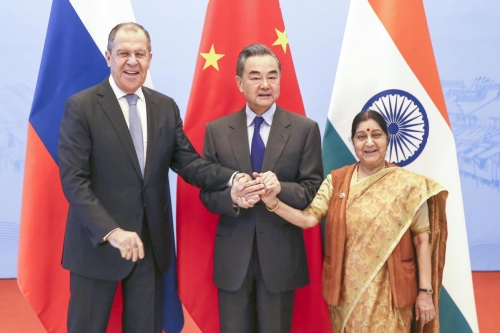
RICs et multipolarité
par le comité de rédaction de Katehon
Source: https://www.ideeazione.com/i-ric-e-la-multipolarita/
Ces dernières années, le monde est en crise, non seulement à cause de l'instabilité économique, mais aussi à cause des problèmes politiques relatifs au "déclin idéologique et à la perte d'identité". Un nouvel ordre mondial est en train d'émerger: d'un monde unipolaire, nous passons progressivement à un ordre mondial multipolaire. Cependant, sur le plan scientifique, la théorie du monde multipolaire (MMT) n'a pas été finalisée, car elle ne figure pas aujourd'hui parmi les théories et paradigmes classiques des relations internationales.
Malgré cela, un nombre croissant d'ouvrages sur la politique étrangère et la géopolitique liés au TMM sont apparus au fil du temps. L'historien britannique Paul Kennedy, spécialiste des relations internationales, a prédit dans son livre The Rise and Fall of the Great Powers (1987) que l'équilibre des forces militaires allait changer au cours des 20 à 30 prochaines années, pour aboutir à un monde multipolaire vers 2009. Jusqu'à présent, sa prédiction ne s'est pas réalisée, mais aujourd'hui, en 2022, nous faisons l'expérience d'un changement dans l'ordre mondial plus aigu que jamais. En 2000, la secrétaire d'État américaine Madeleine Albright a soutenu que l'ordre mondial émergent n'est plus unipolaire, mais plutôt multipolaire.
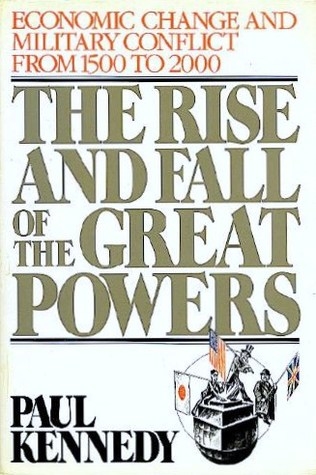
En 2009, le rapport Global Trends 2025 du National Intelligence Council américain a déclaré que les conditions préalables à l'émergence d'un "système multipolaire mondial" étaient en train de se mettre en place sur les deux prochaines décennies, vers 2029. Cette hypothèse sera testée par le temps. Le rapport cite les facteurs suivants: la montée en puissance de pays tels que la Chine, l'Inde, qui peuvent influencer la création d'un système mondial multipolaire. En 2025, il n'y aura plus une seule "communauté internationale" d'États-nations. Le pouvoir sera dispersé parmi les nouveaux acteurs politiques. Il y a aussi la dépendance des pays vis-à-vis des grands exportateurs de gaz, comme la Russie et l'Iran. Si les prix sont élevés, la puissance de ces pays augmentera considérablement. Le niveau du PIB de la Russie pourrait en théorie égaler celui du Royaume-Uni et de la France. Comme nous le savons, la question de l'approvisionnement en gaz de la Russie à l'UE n'a pas été résolue jusqu'à présent. En raison d'un nombre précédent de sanctions américaines et européennes contre la Russie, la Fédération de Russie a décidé de vendre du gaz exclusivement en roubles à partir du 1er avril 2022, ce qui a provoqué une vague d'indignation dans l'UE. Toutefois, le 25 avril 2022, on a appris que l'Arménie et l'Azerbaïdjan étaient passés au paiement du gaz en roubles. Ainsi, l'un des points d'influence de la Russie sur le monde pourrait être les ressources énergétiques.

Alors, quelle est la théorie du monde multipolaire? Il a été développé en Russie en 2012, grâce au philosophe, sociologue et penseur politique russe A. G. Douguine. Dans sa monographie intitulée The Theory of a Multi-polar World. Pluriversum, il a présenté le concept en détail. Le TMM est avant tout un concept politique, qui constitue une interprétation alternative du concept de multipolarité largement utilisé dans la théorie des relations internationales. La création de la théorie s'est appuyée sur diverses études politiques et culturelles-anthropologiques, ainsi que sur des systèmes socio-philosophiques tels que la géopolitique, l'eurasianisme et plusieurs autres. Ajoutons qu'elle s'appuie sur l'idéologie de la "révolution conservatrice" et le traditionalisme de la "nouvelle droite". Cette théorie vise à construire un nouveau système non occidental de relations internationales. En 1993, le politologue américain Samuel Huntington a proposé le concept du choc des civilisations, qui correspondait tout à fait aux idées de Douguine. Les "nouveaux centres", posés comme tels, sont une alliance de plusieurs États BRICS (Russie, Brésil, Chine, Inde et Afrique du Sud).
Cependant, les partisans américains de l'unipolarité rigide ne veulent pas reconnaître le terme "multipolarité". C'est pourquoi ils ont proposé un autre terme, la "non-polarité". Ce concept suppose que "les processus de mondialisation vont se développer davantage et que le modèle occidental d'ordre mondial va étendre sa présence parmi tous les pays et peuples de la terre". Ainsi, l'hégémonie intellectuelle des valeurs de l'Occident se perpétuera.
Toutefois, cette théorie soulève un certain nombre de doutes en raison des développements mondiaux actuels. La Chine, par exemple, devance désormais, en toute confiance de soi, les États-Unis dans un certain nombre d'indicateurs. Depuis 2013, l'initiative "Une Ceinture, une Route" s'est développée ("One Belt, One Road"). La Banque asiatique d'investissement pour les infrastructures a été lancée, ce qui a été un succès pour la RPC. La Chine a commencé à promouvoir les idées du concept chinois de "l'avenir commun de l'humanité". L'un des postulats de ce concept est la création d'une "grande famille", qui peut être interprétée comme une interconnexion étroite entre les peuples du monde. Progressivement, la Chine s'éloigne du soutien à l'ordre mondial existant pour tenter de remplacer l'ancien hégémon, les États-Unis.
Une autre théorie, alternative à la théorie de la multipolarité, est celle d'un "monde multipolaire". C'est que les États-Unis ne doivent pas être la seule puissance hégémonique. Elle devrait plutôt tenir compte des positions de ses partenaires et parvenir à des solutions de compromis avec les autres pays. Mais comme nous le savons, la politique américaine à ce jour est en totale contradiction avec cette thèse.
Ensuite, il convient de définir un cadre clair pour un monde multipolaire. Il ne s'agit pas d'un retour des deux pôles tels que les États-Unis et l'URSS qui se faisaient face autrefois: dans un monde multipolaire, il doit y avoir plus de deux pôles. La multipolarité n'est pas non plus compatible avec les concepts de non-polarité et de multilatéralisme mentionnés précédemment.
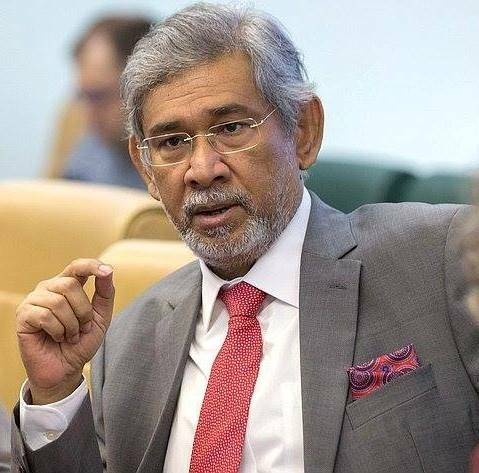

Il est important de noter que la tendance à la multipolarité se fera dans les États qui sont principalement orientés vers un monde multipolaire: la Russie, la Chine, l'Inde et quelques autres. L'eurasisme, par exemple, est considéré comme l'une des stratégies pour un monde multipolaire. À ce jour, il existe plusieurs perspectives sur l'intégration eurasienne. Premièrement, l'Union économique eurasienne (UEE) en tant qu'interprétation de l'eurasisme. Deuxièmement, l'évaluation de l'EAEU comme un véritable concurrent qui pourrait menacer les intérêts de l'UE et des États-Unis. Troisièmement, la possibilité d'évaluer objectivement la relation entre la politique étrangère de la Russie et l'intégration eurasienne et les développements politiques mondiaux. Le projet chinois One Belt, One Road, mentionné plus haut peut être considéré comme un complément à l'eurasisme. Un projet comme celui de la Grande Eurasie est souvent considéré ici dans sa globalité. Par exemple, le diplomate sri-lankais D. Jayatilleka (photo, ci-dessus) estime que le plus faisable pour la géopolitique eurasienne de la Russie est "d'étendre le concept de "multivectorisme" de Primakov au domaine de l'idéologie et à l'évolution du soft power, qui est véritablement multivectoriel: droite, gauche et centre... Ce n'est qu'ainsi que la Russie pourra redécouvrir son rôle d'avant-garde d'un nouveau projet historique, de porteuse d'une nouvelle synthèse d'idées et de valeurs".
Il est également important de noter que le terme "eurasisme" est souvent utilisé pour décrire la Russie et les nouveaux États indépendants. Selon l'historienne française M. Laruelle, la plasticité de l'eurasisme en tant qu'idéologie explique sa popularité. Parmi les prémisses théoriques de l'eurasisme, Laruelle identifie les suivantes: le rejet de l'Occident et du capitalisme, l'affirmation de l'unité culturelle entre l'ancienne Union soviétique et certaines parties de l'Asie, la formation d'une forme impériale d'organisation politique, ainsi que la croyance en l'existence de constantes culturelles.
En outre, M. R. Johnson, un chercheur de Pennsylvanie travaillant sur l'histoire de la Russie, note que la société américaine ne peut tout simplement pas accepter l'idée de l'eurasisme en raison d'un manque de compréhension de l'ontologie globale de l'eurasisme, et Johnson ne cache pas que le développement de l'eurasisme, et donc la formation d'un monde multipolaire, est une menace potentielle pour les États-Unis. Un autre historien américain, T. Fox, estime que pour parvenir à une diffusion mondiale de l'eurasisme, et donc à la multipolarité, il faut créer un récit universel qui combine l'expérience historique et les valeurs culturelles communes.
Après avoir discuté des théories de la multipolarité de la Chine et de la Russie, il convient de s'intéresser à la théorie de la multipolarité en Inde. L'Inde considère le concept de multipolarité depuis une position participative comme l'un des pôles. Cette position a été exposée lors d'une discussion en janvier 2017 dans The New Normal : Multilateralism with Multipolarity. Ce concept cherche à relier les deux théories de la "multipolarité" et du "multilatéralisme", dont nous avons discuté la distinction précédemment. La théorie indienne de la multipolarité est une fusion de la philosophie occidentale avec la Russie et la Chine. L'Inde présente les relations internationales contemporaines en termes de formation non pas de "pôles" mais d'États agissant en tant que sujets de la multipolarité.


Le politologue hindou Suryanarayana estime que la formation de la multipolarité est possible si les pays au centre ont leur propre développement historique, leur identité culturelle, leur intérêt national et leurs stratégies politiques. Le politologue critique également les politiques de néocolonialisme et de messianisme caractéristiques de l'Occident. C'est ici qu'émerge un nouveau concept de "multipolarité" par les politologues indiens, à savoir la coopération et le partenariat égalitaire entre les États. Ainsi, la multipolarité n'est pas la domination des "superpuissances", mais la coopération totale entre les pays. Sanjaya Baru (photo, ci-dessus), en tant que directeur de la géo-économie et de la stratégie à l'Institut international d'études stratégiques en Inde, a souligné qu'il était dans leur intérêt de trouver un terrain d'entente et de résoudre les conflits avec le Pakistan, et de maintenir la coopération au plus haut niveau entre l'Inde, la Russie et la Chine. De cette manière, de nouveaux centres ont été identifiés qui, s'ils coopèrent, pourraient obtenir des résultats significatifs dans la réalisation d'un monde multipolaire. Un regard sur les concepts de la Russie, de l'Inde et de la Chine révèle que ces trois pays sont unis par des objectifs communs. S'il existe effectivement un équilibre des forces, une coopération bénéfique entraînera un changement de l'ordre mondial.
29 avril 2022
19:41 Publié dans Actualité, Géopolitique | Lien permanent | Commentaires (0) | Tags : ric, actualité, politique internationale, multipolarité, inde, chine, russie, géopolitique |  |
|  del.icio.us |
del.icio.us |  |
|  Digg |
Digg | ![]() Facebook
Facebook
mercredi, 06 avril 2022
La Stratégie du Heartland à l'Est : un aperçu des objectifs et des priorités
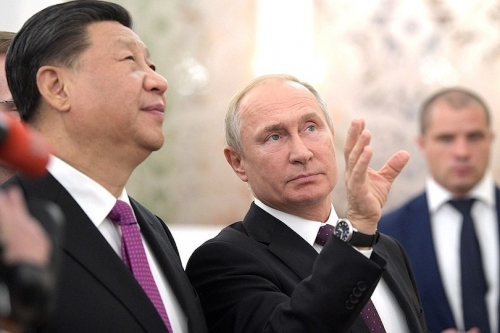
La Stratégie du Heartland russe à l'Est: un aperçu des objectifs et des priorités
Alexandre Douguine
Source: https://www.ideeazione.com/la-strategia-orientale-dellheartland-una-panoramica-degli-obiettivi-e-delle-priorita/
Axe Moscou-New Delhi
Déplaçons-nous vers l'est. Nous voyons ici l'Inde comme un "grand espace" à part entière, qui, à l'époque du Grand Jeu, était la principale tête de pont de la domination britannique en Asie. À cette époque, la nécessité de maintenir le contrôle de l'Inde et d'empêcher d'autres puissances, notamment l'Empire russe, d'empiéter sur le contrôle britannique de la région était essentielle pour la "civilisation de la mer". À cela s'ajoutent les épopées afghanes des Britanniques, qui ont cherché à plusieurs reprises à affirmer leur contrôle sur la structure complexe de la société afghane non gouvernée, précisément pour bloquer les Russes dans une éventuelle campagne en Inde. Une telle perspective est théorisée depuis l'époque de l'empereur Paul Ier, qui a virtuellement lancé une campagne cosaque (organisée et planifiée de manière quelque peu naïve) en Inde (en alliance avec les Français), ce qui pourrait être la raison de son assassinat (qui, comme le montrent les historiens, a été organisé par l'ambassadeur britannique en Russie, Lord Whitworth).
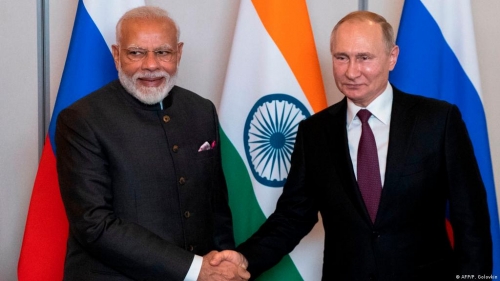
L'Inde mène actuellement une politique de neutralité stratégique, mais sa société, sa culture, sa religion et son système de valeurs n'ont rien en commun avec le projet mondialiste ou le mode de vie de l'Europe occidentale. La structure de la société hindoue est entièrement terrestre, basée sur des constantes qui ont très peu changé au cours des millénaires. Par ses paramètres (démographie, niveau de développement économique moderne, culture intégrale), l'Inde représente un "grand espace" complet, qui est organiquement inclus dans la structure multipolaire. Les relations russo-indiennes après la libération de l'Inde des Britanniques ont traditionnellement été très cordiales. Dans le même temps, les dirigeants indiens ont souligné à plusieurs reprises leur engagement en faveur d'un ordre mondial multipolaire. En même temps, la société indienne elle-même illustre la multipolarité où la diversité des groupes ethniques, des cultes, des cultures locales, des courants religieux et philosophiques s'entendent parfaitement bien malgré leurs profondes différences et même leurs contradictions. L'Inde est certainement une civilisation qui, au vingtième siècle, après la fin de la phase de colonisation, a acquis - pour des raisons pragmatiques - le statut d'"État-nation".
Dans ces circonstances favorables au projet multipolaire, qui font de l'axe Moscou-New Delhi une autre structure de soutien pour l'expression spatiale de la pan-idée eurasienne, un certain nombre de circonstances compliquent ce processus. Par inertie historique, l'Inde continue à entretenir des liens étroits avec le monde anglo-saxon, qui, pendant la période de domination coloniale, a réussi à influencer de manière significative la société indienne et à projeter sur elle ses attitudes sociologiques formelles (notamment l'anglophilie). L'Inde est étroitement intégrée aux États-Unis et aux pays de l'OTAN dans le domaine militaro-technique et les stratèges atlantistes apprécient énormément cette coopération, car elle s'inscrit dans la stratégie de contrôle de la "zone côtière" de l'Eurasie. En même temps, la mentalité même de la société indienne rejette la logique des alternatives rigides de l'une ou l'autre, et il est difficile pour la mentalité hindoue de comprendre la nécessité d'un choix irréversible entre la Mer et la Terre, entre la mondialisation et la préservation d'une identité civilisée.
Au niveau régional, cependant, dans les relations avec ses voisins immédiats - en particulier la Chine et le Pakistan - la pensée géopolitique indienne fonctionne beaucoup mieux et cela devrait être utilisé pour intégrer l'Inde dans la construction multipolaire de la nouvelle architecture stratégique eurasienne.
La place naturelle de l'Inde est en Eurasie, où elle pourrait jouer un rôle stratégique comparable à celui de l'Iran. Mais le format de l'axe Moscou-New Delhi devrait être très différent, en tenant compte des spécificités de la stratégie et de la culture régionales de l'Inde. Dans le cas de l'Iran et de l'Inde, différents paradigmes d'intégration stratégique devraient être impliqués.
La structure géopolitique de la Chine
La structure géopolitique de la Chine est la question la plus importante. Dans le monde d'aujourd'hui, la Chine a si bien développé son économie, trouvant les proportions optimales entre le maintien du pouvoir politique d'un parti communiste réformé, les principes d'une économie libérale et l'utilisation mobilisatrice d'une culture chinoise commune (dans certains cas sous la forme d'un "nationalisme chinois"), que beaucoup lui attribuent le rôle d'un pôle mondial indépendant à l'échelle planétaire et préfigurent un futur "nouvel hégémon". En termes de potentiel économique, la Chine a été classée deuxième parmi les cinq premières économies du monde avec le PIB le plus élevé. Avec les États-Unis, l'Allemagne et le Japon, le pays a formé une sorte de club des principales puissances commerciales du monde. Les Chinois eux-mêmes appellent la Chine "Zhongguo", littéralement "le pays central, du milieu".
La Chine est une entité géopolitique complexe qui peut être divisée en plusieurs composantes principales :
- Chine continentale : les zones rurales pauvres et mal irriguées situées entre les fleuves Huanghe et Yangtze, habitées principalement par des groupes ethniques indigènes réunis par le terme "Han" ;
- les zones côtières de l'Est, qui sont des centres de développement économique et commercial national et des points d'accès au marché mondial.
- les zones tampons habitées par des minorités ethniques (région autonome de Mongolie intérieure, région autonome ouïghoure du Xinjiang, région autonome du Tibet)
- les États voisins et les zones administratives insulaires spéciales dont la population est majoritairement chinoise (Taïwan, Hong Kong, Macao).
Le problème de la géopolitique chinoise est le suivant : pour développer son économie, la Chine manque de demande intérieure (la pauvreté de la Chine continentale). L'accès au marché international par le développement de la zone côtière du Pacifique augmente considérablement le niveau de vie, mais crée des inégalités sociales entre la "côte" et le "continent", et favorise un plus grand contrôle extérieur par le biais des liens économiques et des investissements, ce qui menace la sécurité du pays. Au début du 20e siècle, ce déséquilibre a conduit à l'effondrement de l'État chinois, à la fragmentation du pays, à l'établissement virtuel d'un "contrôle externe" par la Grande-Bretagne et, enfin, à l'occupation des zones côtières par le Japon.
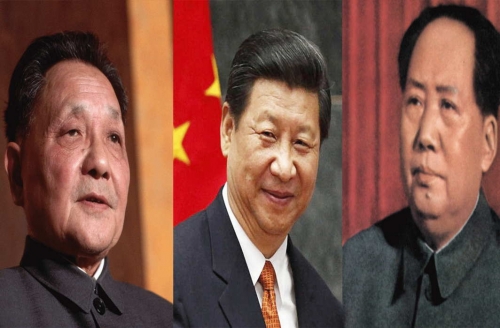
Mao Tse-tung (1893-1976) a choisi une autre voie : la centralisation du pays et sa fermeture complète. Cela a rendu la Chine indépendante, mais l'a condamnée à la pauvreté. À la fin des années 1980, Deng Xiaoping (1904-1997) a entamé un autre cycle de réformes, qui consistait à équilibrer le développement ouvert de la "zone côtière" et l'attraction des investissements étrangers dans cette région avec le maintien d'un contrôle politique strict de l'ensemble du territoire chinois aux mains du Parti communiste, afin de préserver l'unité du pays. C'est cette formule qui définit la fonction géopolitique de la Chine contemporaine.
L'identité de la Chine est double : il y a une Chine continentale et une Chine côtière. La Chine continentale est tournée vers elle-même et la préservation du paradigme social et culturel ; la Chine côtière est de plus en plus intégrée au "marché mondial" et, par conséquent, à la "société mondiale" (c'est-à-dire qu'elle adopte progressivement les traits de la "civilisation de la mer"). Ces contradictions géopolitiques ont été aplanies par le Parti communiste chinois (PCC), qui doit fonctionner dans le cadre du paradigme de Deng Xiaoping - l'ouverture assure la croissance économique, le centralisme rigide de l'idéologie et du parti, s'appuyant sur les zones rurales pauvres du continent, maintient l'isolement relatif de la Chine par rapport au monde extérieur. La Chine cherche à prendre de l'atlantisme et de la mondialisation ce qui la renforce, et à détacher et écarter ce qui l'affaiblit et la détruit. Jusqu'à présent, Pékin a réussi à maintenir cet équilibre, ce qui l'amène au leadership mondial, mais il est difficile de dire dans quelle mesure il est possible de combiner l'incompatible : mondialisation d'un segment de la société et préservation d'un autre segment sous le mode de vie traditionnel. La solution de cette équation extrêmement complexe prédéterminera le destin de la Chine dans le futur et, par conséquent, construira un algorithme pour son comportement.
En tout état de cause, la Chine d'aujourd'hui insiste fermement sur un ordre mondial multipolaire et s'oppose à l'approche unipolaire des États-Unis et des pays occidentaux dans la plupart des confrontations internationales. La seule menace sérieuse qui pèse aujourd'hui sur la sécurité de la Chine provient uniquement des États-Unis - la marine américaine dans le Pacifique pourrait à tout moment imposer un blocus sur l'ensemble du littoral chinois et ainsi faire s'effondrer instantanément l'économie chinoise, qui dépend entièrement des marchés étrangers. À cela s'ajoute la tension autour de Taïwan, un État puissant et prospère avec une population chinoise mais une société purement atlantiste intégrée dans un contexte mondial libéral.
Dans un modèle d'ordre mondial multipolaire, la Chine se voit attribuer le rôle du pôle Pacifique. Ce rôle serait une sorte de compromis entre le marché mondial dans lequel la Chine existe et se développe aujourd'hui, fournissant une part énorme de ses biens industriels, et sa fermeture totale. Ceci est globalement cohérent avec la stratégie de la Chine qui consiste à essayer de maximiser son potentiel économique et technologique avant l'inévitable affrontement avec les États-Unis.
Le rôle de la Chine dans un monde multipolaire
Il existe un certain nombre de problèmes entre la Russie et la Chine qui pourraient entraver la consolidation des efforts visant à construire une construction multipolaire. L'une d'elles est l'expansion démographique des Chinois dans les territoires peu peuplés de Sibérie, qui menace de modifier radicalement la structure sociale même de la société russe et constitue une menace directe pour la sécurité. Sur cette question, une condition préalable à un partenariat équilibré devrait être un contrôle strict par les autorités chinoises des flux migratoires vers le nord.
La deuxième question concerne l'influence de la Chine en Asie centrale, une zone stratégique proche de la Russie, riche en ressources naturelles et en vastes territoires, mais plutôt faiblement peuplée. L'avancée de la Chine en Asie centrale pourrait également constituer un obstacle. Ces deux tendances violent un principe important de la multipolarité : l'organisation de l'espace sur un axe nord-sud et non l'inverse. La direction dans laquelle la Chine a toutes les raisons de se développer est celle du Pacifique, au sud de la Chine. Plus la présence stratégique de la Chine dans cette région sera forte, plus la structure multipolaire sera forte.
Le renforcement de la présence de la Chine dans le Pacifique entre directement en collision avec les plans stratégiques de l'Amérique pour l'hégémonie mondiale, car dans une perspective atlantiste, la sécurisation du contrôle des océans du monde est la clé de l'ensemble du tableau stratégique du monde vu des États-Unis. La marine américaine dans le Pacifique et le déploiement de bases militaires stratégiques dans différentes parties du Pacifique et sur l'île de San Diego dans l'océan Indien afin de contrôler l'espace maritime de toute la région sera le principal enjeu de la réorganisation de la zone Pacifique sur le modèle d'un ordre mondial multipolaire. La libération de cette zone des bases militaires américaines peut être considérée comme une tâche d'importance planétaire.
La géopolitique du Japon et son éventuelle implication dans le projet multipolaire
La Chine n'est pas le seul pôle dans cette partie du monde. Le Japon est une puissance régionale asymétrique mais économiquement comparable. Société terrestre et traditionnelle, le Japon est passé sous occupation américaine après 1945 à la suite de la Seconde Guerre mondiale, dont les conséquences stratégiques se font encore sentir aujourd'hui. Le Japon n'est pas indépendant dans sa politique étrangère ; il y a des bases militaires américaines sur son territoire, et son importance militaire et politique est négligeable par rapport à son potentiel économique. Pour le Japon, d'un point de vue théorique, la seule voie organique de développement serait de rejoindre le projet multipolaire, ce qui implique :
- L'établissement d'un partenariat avec la Russie (avec laquelle aucun traité de paix n'a encore été conclu - une situation soutenue artificiellement par les États-Unis, qui craignent un rapprochement entre la Russie et le Japon) ;
- restaurer sa puissance militaire et technique en tant que puissance souveraine ;
- une participation active à la réorganisation de l'espace stratégique dans le Pacifique ;
- devenant le deuxième pôle, avec la Chine, de l'ensemble de l'espace Pacifique.
Pour la Russie, le Japon était le partenaire optimal en Extrême-Orient car, démographiquement, contrairement à la Chine, il n'a pas de problèmes de ressources naturelles (ce qui permettrait à la Russie d'accélérer l'équipement technologique et social de la Sibérie au Japon) et il dispose d'une énorme puissance économique, y compris dans le domaine de la haute technologie, qui est stratégiquement important pour l'économie russe. Mais pour qu'un tel partenariat soit possible, le Japon doit faire le pas décisif de se libérer de l'influence américaine.

Sinon (comme dans la situation actuelle), les États-Unis considéreront le Japon comme un simple outil dans leur politique visant à contenir le mouvement potentiel de la Chine et de la Russie dans le Pacifique. Brzezinski plaide à juste titre en ce sens dans son livre The Grand Chessboard, où il décrit la stratégie américaine optimale dans le Pacifique. Ainsi, cette stratégie prône un rapprochement commercial et économique avec la Chine (parce que la Chine est entraînée dans la "société mondiale" par son intermédiaire), mais insiste pour construire un bloc stratégico-militaire contre elle. Avec le Japon, au contraire, Bzezinski propose de construire un "partenariat" militaro-stratégique contre la Chine et la Russie (en fait, il ne s'agit pas d'un "partenariat", mais d'une utilisation plus active du territoire japonais pour le déploiement d'installations militaro-stratégiques américaines) et de se livrer à une concurrence acharnée dans la sphère économique, car les entreprises japonaises sont capables de relativiser la domination économique américaine à l'échelle mondiale.
L'ordre mondial multipolaire évalue légitimement la situation de manière exactement inverse : l'économie libérale de la Chine ne vaut rien en soi et ne fait qu'accroître la dépendance de la Chine à l'égard de l'Occident, tandis que sa puissance militaire - surtout dans le segment naval - est au contraire précieuse car elle crée les conditions préalables pour débarrasser à l'avenir les océans Pacifique et Indien de la présence américaine. Le Japon, au contraire, est surtout attrayant en tant que puissance économique qui rivalise avec les économies occidentales et qui a maîtrisé les règles du marché mondial (on espère qu'à un moment donné, le Japon pourra utiliser cela à son avantage), mais il est moins attrayant en tant que partenaire dans un monde multipolaire, en tant qu'instrument passif de la stratégie américaine. Dans tous les cas, le scénario optimal serait que le Japon se libère du contrôle américain et entre dans une orbite géopolitique indépendante. Dans ce cas, il serait difficile d'imaginer un meilleur candidat pour construire un nouveau modèle d'équilibre stratégique dans le Pacifique.
Actuellement, compte tenu du statu quo, la place du "pôle" Pacifique peut être réservée à deux puissances - la Chine et le Japon. Tous deux ont de solides arguments pour être le leader ou l'un des deux leaders, substantiellement supérieur à tous les autres pays de la région d'Extrême-Orient.

La Corée du Nord comme exemple de l'autonomie géopolitique d'un État terrestre
Il convient de souligner le facteur de la Corée du Nord, un pays qui n'a pas succombé à la pression occidentale et qui continue à rester fidèle à son ordre sociopolitique très spécifique (juché) malgré toutes les tentatives de le renverser, de le discréditer et de le diaboliser. La Corée du Nord illustre la résistance courageuse et efficace à la mondialisation et à l'unipolarité par un peuple assez petit, et c'est là que réside sa grande valeur. Une Corée du Nord nucléaire qui maintient une identité sociale et ethnique et une réelle indépendance, avec un niveau de vie modeste et un certain nombre de restrictions à la "démocratie" (comprise dans le sens libéral et bourgeois), contraste fortement avec la Corée du Sud. La Corée du Sud perd rapidement son identité culturelle (la plupart des Sud-Coréens appartiennent à des sectes protestantes, par exemple) et est incapable de faire un seul pas en politique étrangère sans se référer aux États-Unis, mais sa population est plus ou moins prospère (financièrement, mais pas psychologiquement). Le drame moral du choix entre indépendance et confort, dignité et bien-être, fierté et prospérité se joue dans deux parties d'un peuple historiquement et ethniquement unifié. La partie nord-coréenne illustre les valeurs du Sushi. Celui de la Corée du Sud illustre les valeurs de la mer. Rome et Carthage, Athènes et Sparte. Béhémoth et Léviathan dans le contexte de l'Extrême-Orient moderne.
Les principaux défis au Heartland russe à l'Est
Le vecteur oriental (Extrême-Orient, Asie) du Heartland russe peut être réduit aux tâches principales suivantes :
- Assurer la sécurité stratégique de la Russie sur la côte Pacifique et en Extrême-Orient ;
- Intégrer les territoires sibériens dans le contexte social, économique, technologique et stratégique global de la Russie (en tenant compte de l'état désastreux de la démographie de la population russe)
- développer le partenariat avec l'Inde, y compris dans le domaine militaro-technique (l'axe Moscou-New Delhi)
- construire une relation équilibrée avec la Chine, en soutenant ses politiques multipolaires et ses aspirations à devenir une puissante puissance navale, mais en prévenant les conséquences négatives de l'expansion démographique de la population chinoise dans le nord et de l'infiltration de l'influence chinoise au Kazakhstan ;
- Encourager par tous les moyens possibles l'affaiblissement de la présence navale américaine dans le Pacifique en démantelant les bases navales et autres installations stratégiques ;
- Encourager le Japon à se libérer de l'influence américaine et à devenir une puissance régionale à part entière, établissant ainsi un partenariat stratégique sur l'axe Moscou-Tokyo ;
- Soutenir les puissances régionales d'Extrême-Orient qui défendent leur indépendance vis-à-vis de l'atlantisme et de la mondialisation (Corée du Nord, Vietnam et Laos).
18:51 Publié dans Actualité, Eurasisme, Géopolitique | Lien permanent | Commentaires (0) | Tags : actualité, eurasisme, asie, affaires asiatiques, russie, chine, japon, océan pacifique, inde, océan indien, géopolitique, politique internationale, alexandre douguine |  |
|  del.icio.us |
del.icio.us |  |
|  Digg |
Digg | ![]() Facebook
Facebook
vendredi, 01 avril 2022
Comment l'Inde entend aider la Russie à échapper aux sanctions

Comment l'Inde entend aider la Russie à échapper aux sanctions
L'Inde devrait ignorer les avertissements occidentaux en créant un mécanisme d'échange roupie-rouble qui pourrait démarrer dès la semaine prochaine
par Anil Sharma
Source: https://asiatimes.com/2022/03/how-india-intends-to-help-russia-evade-sanctions/?mc_cid=1fc3f2de80&mc_eid=19c604030d
L'Inde aide de facto la Russie à échapper aux sanctions occidentales imposées suite à son invasion de l'Ukraine.
JAIPUR - L'Inde envisage de conclure un accord commercial roupie-rouble avec la Russie, une proposition de Moscou qui mettra New Delhi sur la voie de la confrontation avec l'Occident, mais qui pourrait contribuer à protéger l'économie indienne contre les vents contraires mondiaux qui se rassemblent, notamment la flambée des prix du pétrole.
L'Inde tient à poursuivre son commerce bilatéral avec la Russie malgré la forte pression exercée par les États-Unis et l'UE pour qu'elle s'aligne sur son régime de sanctions. L'Inde dépend fortement de la Russie pour ses armes et voit la perspective d'importer du pétrole moins cher à un moment où les prix ont flambé depuis l'invasion de l'Ukraine.
Les responsables de l'organisme commercial indien affirment que l'accord de paiement bilatéral pourrait être mis en œuvre dès la semaine prochaine, bien que la banque centrale et le ministère des finances indiens aient jusqu'à présent évité de faire des commentaires officiels sur la question.
Le principal quotidien économique indien, Economic Times, a rapporté que les responsables de la banque centrale russe devraient rencontrer la semaine prochaine leurs homologues de la Reserve Bank of India (RBI) pour discuter de la création d'un cadre réglementaire qui aidera à soutenir le commerce bilatéral et les opérations bancaires face aux sanctions occidentales imposées contre la guerre de Moscou en Ukraine.
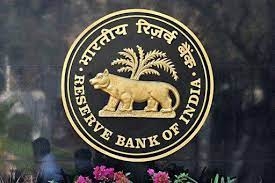 Des rapports locaux citant des fonctionnaires anonymes du ministère indien des finances suggèrent que les modalités du commerce roupie-rouble n'ont pas encore été élaborées en détail, mais une possibilité pourrait être, selon un rapport du journal Business Standard, "l'échange de la roupie par la banque russe contre le renminbi d'une succursale bancaire chinoise en Inde."
Des rapports locaux citant des fonctionnaires anonymes du ministère indien des finances suggèrent que les modalités du commerce roupie-rouble n'ont pas encore été élaborées en détail, mais une possibilité pourrait être, selon un rapport du journal Business Standard, "l'échange de la roupie par la banque russe contre le renminbi d'une succursale bancaire chinoise en Inde."
Le renminbi, contrairement à la roupie, peut être utilisé par les Russes. Pendant ce temps, les banques chinoises peuvent utiliser les roupies pour acheter des dollars, car elles ne font face à aucune sanction, selon le rapport.
D'autres rapports ont suggéré que le plan pourrait impliquer des paiements libellés en roupies et en renminbis par le biais du système de messagerie russe SPFS, une alternative au système SWIFT, plus largement utilisé, que sept banques russes sont désormais interdites d'utiliser à titre punitif.
Selon un rapport de CNBC, une méthode plus simple pourrait être adoptée, dans laquelle une banque russe n'aura qu'à ouvrir un compte dans une banque indienne et une banque indienne devra ouvrir un compte en Russie par lequel les exportateurs indiens seront payés dans la monnaie locale plutôt qu'en dollars ou en euros pour leurs exportations vers la Russie.
Dans ce cas, New Delhi et Moscou devront se mettre d'accord sur la valeur d'échange et disposer également d'une valeur d'équivalence théorique, très probablement en dollars ou en euros, à laquelle la valeur des monnaies indienne et russe sera rattachée.
Le rouble s'échange à environ 85 pour un dollar, à peu près là où il se trouvait avant que la Russie ne commence son invasion il y a un mois. La monnaie russe était tombée jusqu'à 150 pour un dollar le 7 mars à la nouvelle que l'administration Biden allait interdire les importations américaines de carburant russe, mais elle a rebondi avec la hausse des taux d'intérêt à 20 % et l'imposition de contrôles des capitaux par Moscou.

La Russie souhaite également que l'Inde se branche sur son interface de paiement unifiée avec son système de paiement MIR pour une utilisation sans faille des cartes émises par les banques indiennes et russes après la suspension des opérations de Visa Inc. et Mastercard Inc., indique un rapport de Bloomberg citant une source gouvernementale indienne.
Michael Kugelman, associé principal pour l'Asie du Sud au Wilson Center, un groupe de réflexion basé à Washington, a déclaré à Asia Times : "La décision de l'Inde de rechercher des accords commerciaux non basés sur le dollar avec la Russie peut en irriter certains à Washington, mais elle n'est pas du tout surprenante et s'inscrit parfaitement dans la politique indienne passée."
"New Delhi entretient une relation spéciale avec Moscou qui implique une amitié de longue date. Cela incite l'Inde à trouver des moyens de continuer à travailler avec la Russie tout en veillant à ne pas se mettre en travers des sanctions imposées par les États-Unis, un partenaire de plus en plus proche pour l'Inde", a déclaré M. Kugelman.
Il pense qu'un accord commercial entre la roupie et le rouble est un moyen possible de sortir de l'impasse diplomatique dans laquelle se trouve actuellement l'Inde, qui cherche à équilibrer ses relations avec Moscou et Washington.
M. Kugelman a également noté que l'Inde a une forte dépendance à l'égard des armes russes, à un moment où elle est confrontée à des défis de sécurité à deux volets, à savoir le Pakistan et la Chine. Et elle a un fort désir de pétrole russe bon marché à un moment où les prix mondiaux augmentent rapidement.
"En effet, les intérêts immédiats de l'Inde, tant sur le plan de la sécurité que sur le plan économique, l'incitent fortement à élaborer un accord commercial roupie-rouble avec Moscou", a-t-il déclaré.
Brahma Chellaney, éminent penseur stratégique, auteur et commentateur, s'est fait l'écho de ces opinions dans un récent tweet en déclarant : "La neutralité de l'Inde dans l'impasse Russie-OTAN à propos de l'Ukraine a attiré plus d'attention que la neutralité d'Israël. De même, alors que l'Europe dépend toujours de l'énergie russe, un éventuel accord pétrolier indien avec Moscou attire l'attention, bien que, comme le signale [le porte-parole de la Maison Blanche] Psaki, il ne violera pas les sanctions."
Les échanges commerciaux entre la Russie et l'Inde entre avril 2020 et mars 2021 se sont élevés à 8,1 milliards de dollars, selon les chiffres officiels du commerce indien. Ventilé, l'Inde a exporté 2,6 milliards de dollars vers la Russie, tandis qu'elle en a importé 5,48 milliards.
L'amélioration des relations économiques et commerciales était une priorité bilatérale essentielle avant la guerre en Ukraine, les deux parties ayant déclaré leur intention de porter le commerce bilatéral à 30 milliards de dollars et les investissements bilatéraux à 50 milliards de dollars d'ici 2025. Actuellement, les exportations de l'Inde vers la Russie sont principalement constituées de produits agricoles, de produits marins et de produits pharmaceutiques, tandis que les importations en provenance de Russie sont principalement constituées de pétrole brut.
Pendant ce temps, les commentateurs et experts américains et européens ont commencé à fustiger l'Inde pour avoir aidé la Russie à esquiver les sanctions et demandent aux États-Unis d'imposer des sanctions à New Delhi.
Trish Regan, l'éditrice primée de TrishIntel.com, a écrit dans un récent tweet au ton ferme: "Si l'INDE achète du pétrole brut russe, elle doit s'attendre à être sanctionnée par les États-Unis. Et, croyez-moi, cela ne marchera pas très bien pour l'économie indienne. En ce moment : vous êtes avec les États-Unis ou vous êtes contre nous. Simple."
Jamie Jenkins, un commentateur de l'actualité basé au Royaume-Uni, a écrit dans un tweet similaire : "L'Inde cherche à renflouer la Russie en achetant du pétrole brut à prix réduit. L'Inde est un pays auquel nous accordons une aide étrangère. Si nous sommes sérieux au sujet des sanctions, alors le budget de l'aide doit aussi être examiné."
Son tweet est intervenu après la parution de rapports selon lesquels l'Inde pourrait acheter du brut à un prix réduit à la Russie dans le cadre de l'accord d'échange de devises.
Suivez Anil Sharma sur Twitter à @anilsharma45
17:31 Publié dans Actualité, Eurasisme, Géopolitique | Lien permanent | Commentaires (0) | Tags : actualité, eurasisme, inde, russie, politique internationale, pétrole, roupie, rouble |  |
|  del.icio.us |
del.icio.us |  |
|  Digg |
Digg | ![]() Facebook
Facebook


